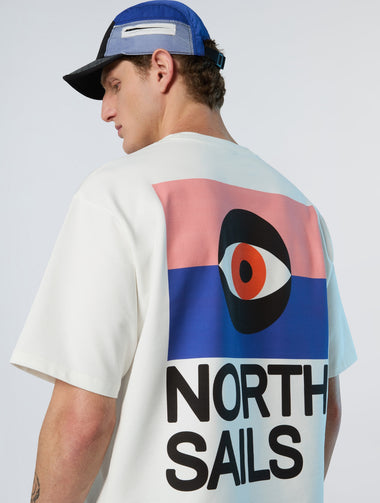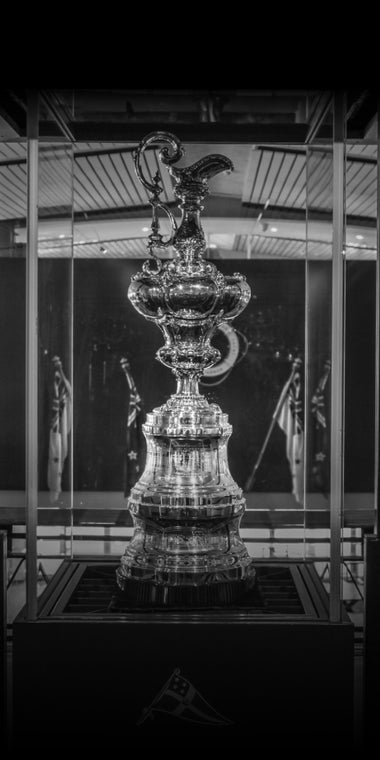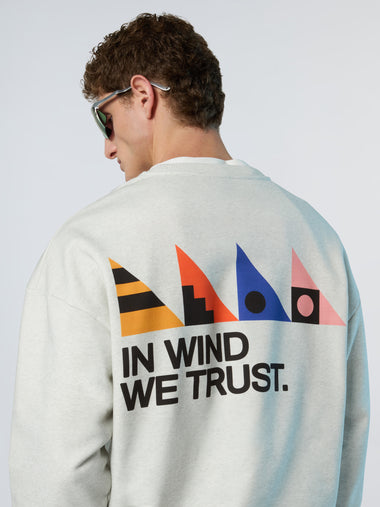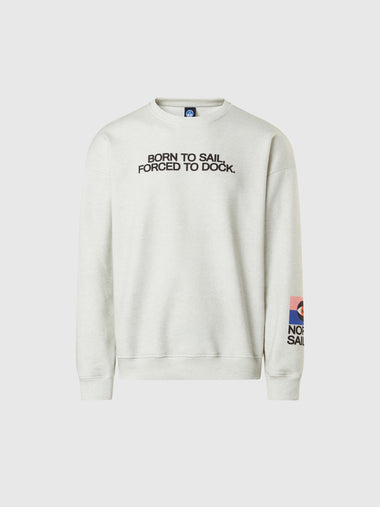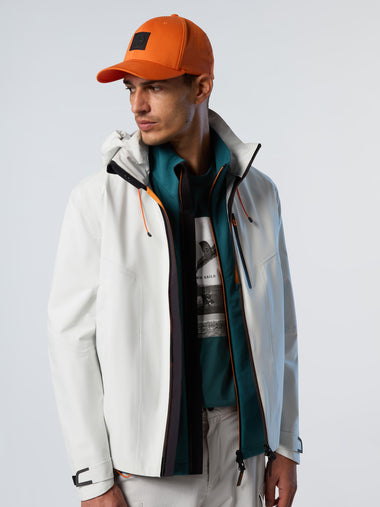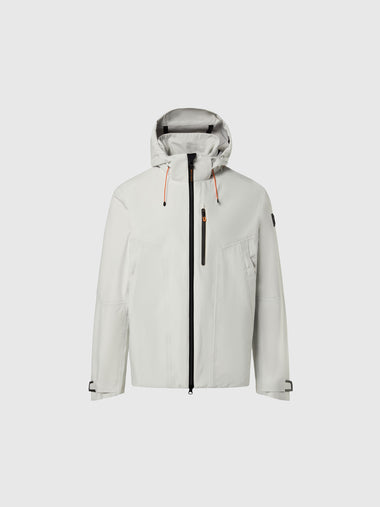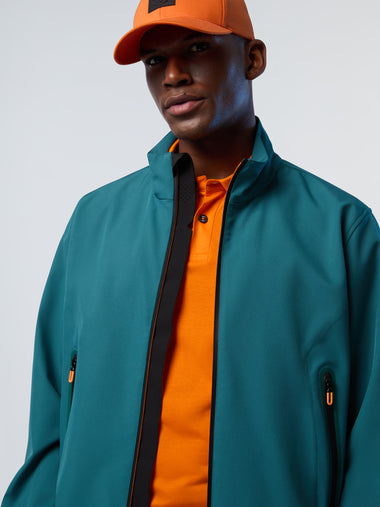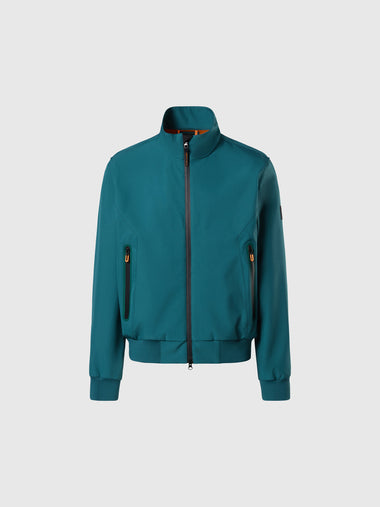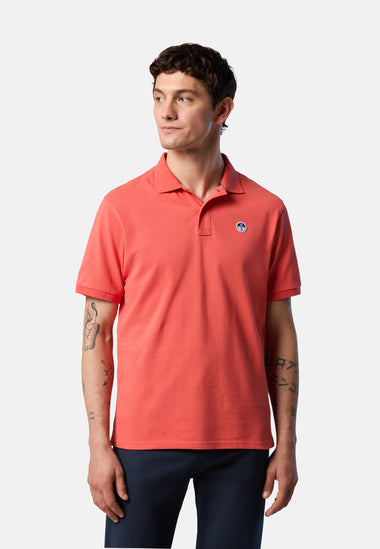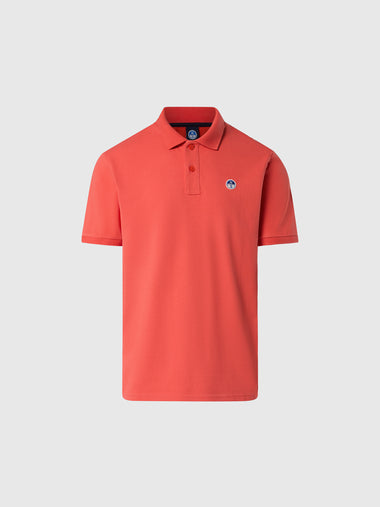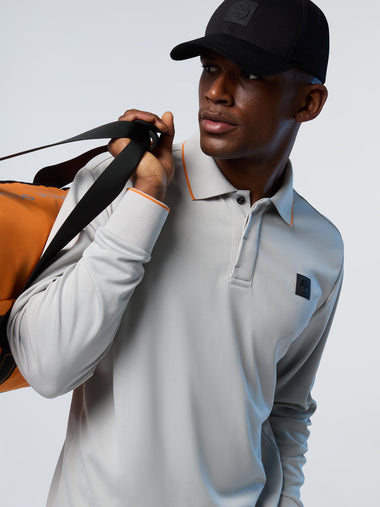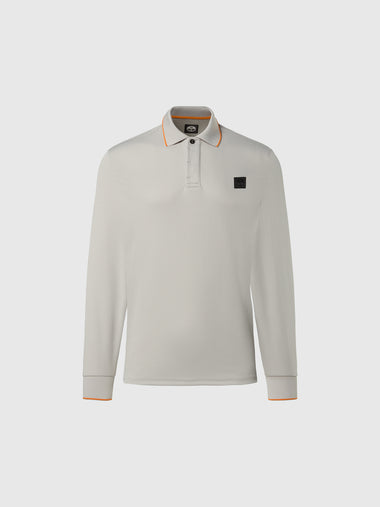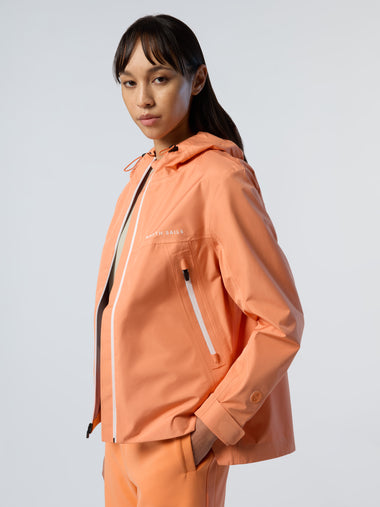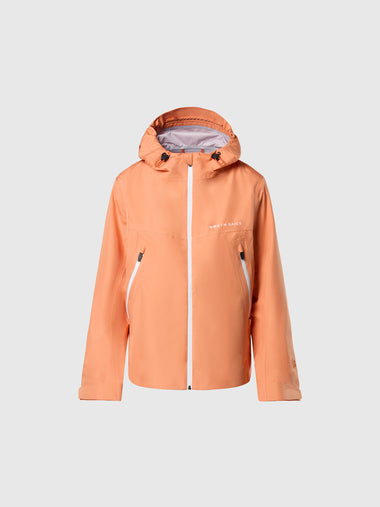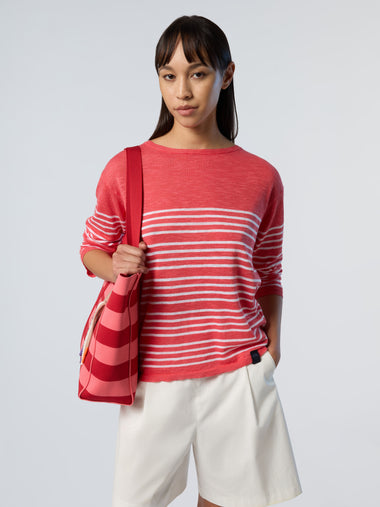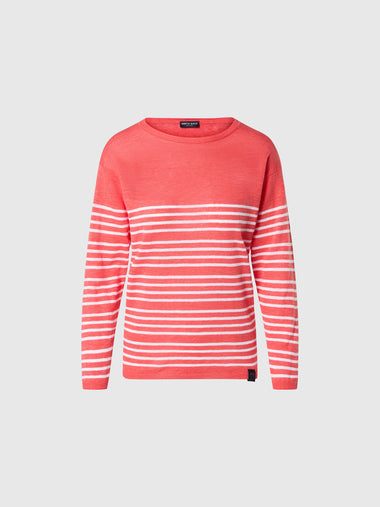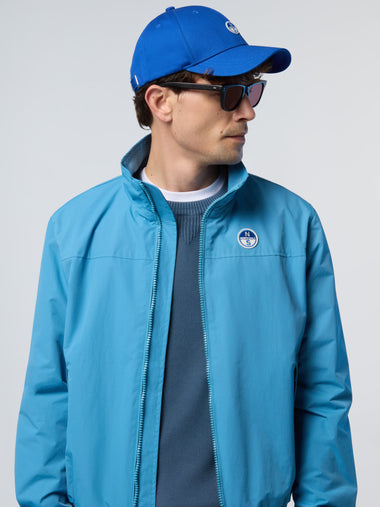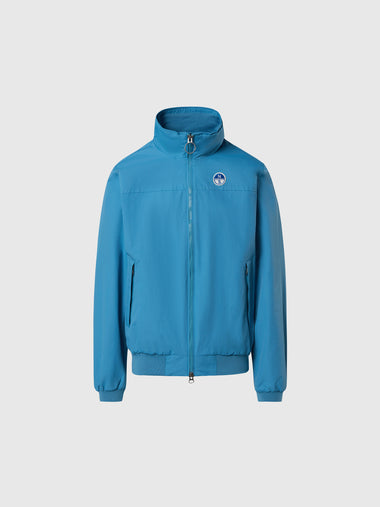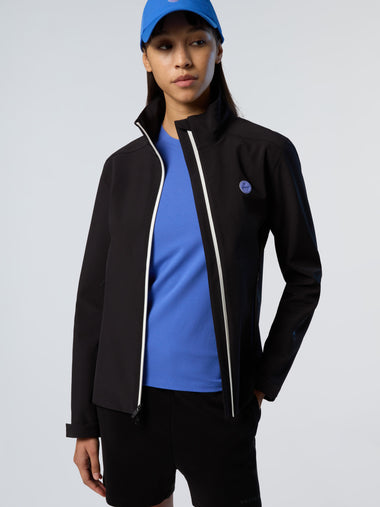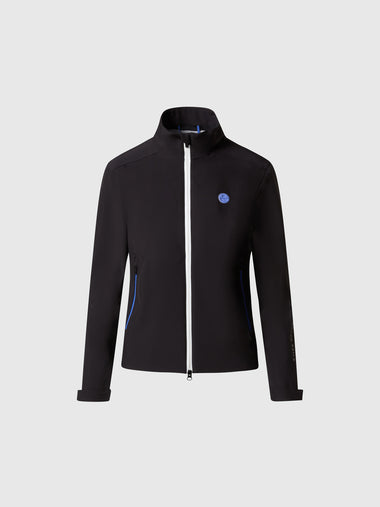NORTH SAILS BLOG
All
Events
Guides
News
People
Podcast
Sustainability
Tech & Innovation
Travel & Adventure

SESTO-COSBY MAKES WAVES IN THE OPTIMIST FLEET
SESTO-COSBY MAKES WAVES IN THE OPTIMIST FLEET
After Two International Regatta Wins on Lake Garda
📸 Fraglia Vela Riva/Zerogradinord
Making a name for himself in the fiercely competitive Optimist fleet is 14-year-old British sailor Santiago Sesto-Cosby. Having sailed the Optimist for an astounding 10 years, we were eager to find out about his journey and where he is heading next.
Sesto-Cosby started sailing at Salterns Sailing Club in Lymington on the south coast of England. He then joined the Royal Lymington Yacht Club before being part of the regional squad and ultimately being selected to train at a National level; a commitment that set him up well as he now competes internationally and races all over the world.
The young sailor recently made waves on Lake Garda after winning the Ora Cup against 240 boats earlier this month. He topped off his achievements most recently after becoming the first-ever British sailor to win the Country Cup, also on Lake Garda, racing against countries including Denmark, France, and Germany.
It is clear Sesto-Cosby has some in-depth knowledge of Garda as a sailing venue, so we asked him to share his insights. “During the Ora Cup, I learned alot about the fleet, the wind, and the conditions. We often launched early so got to know the conditions prior to the race start. It was different from when I’ve sailed there before as there seemed to be less wind, but it arrived earlier. Sailing with a north wind on Garda is tricky because it is shiftier which means big gusts to look out for!’’
Getting caught up on the line can ruin the whole race before it has even begun. Sesto-Cosby balances picking the bias side of the line whilst avoiding starting amongst the big bunches. He explains, “Generally, only one or two boats starting in a bunch will actually get a good start and the rest will be buried. Once I’ve got my position, I accelerate a few seconds earlier than most and don’t start too close to the pin to allow myself room to tack off. Once you have done that and crossed a few boats, you are out in front and in the lead. From there, you can fight with those closest to you rather than battling it out with everyone and risking dropping back in the fleet as a result.’’
“From there, you can fight with those closest to you rather than battling it out with everyone and risking dropping back in the fleet as a result.’’
Working with Riccardo de Felice from North Sails Italy, Sesto-Cosby uses the new-design 2021 prototype North sail which was designed for racing on Garda. “I recently transitioned after being offered to test it out in Valencia where I became very attached to it. I found it perfect – more powerful than my previous sail, but the pinching modes of sailing remained. 10-15 knots of breeze is the perfect condition for me with this sail.’’
The size of the Optimist fleet can be daunting for younger sailors who are new to sailing. Sesto-Cosby’s advice is to prioritize boat speed and handling during the early stages of racing. “Tactics and fleet knowledge develop with time; after a few years of racing,’’ he says. “I regret not focusing more on my boat handling (tacking, general speed) when I was younger, because the knowledge of strategy and tactics comes with experience when you get older.’’
The future looks bright for Sesto-Cosby who hopes to continue his winning streak at the European Championship next October. When it comes to moving on from the Optimist, he is looking to partner with a Swiss sailor in the 29er whilst doing some Optimist coaching on the side. We look forward to watching the progress of this young, rising star.
📸 Fraglia Vela Riva/Zerogradinord
📸 Valeria Sesto
📸 Fraglia Vela Riva/Zerogradinord
READ MORE
READ MORE
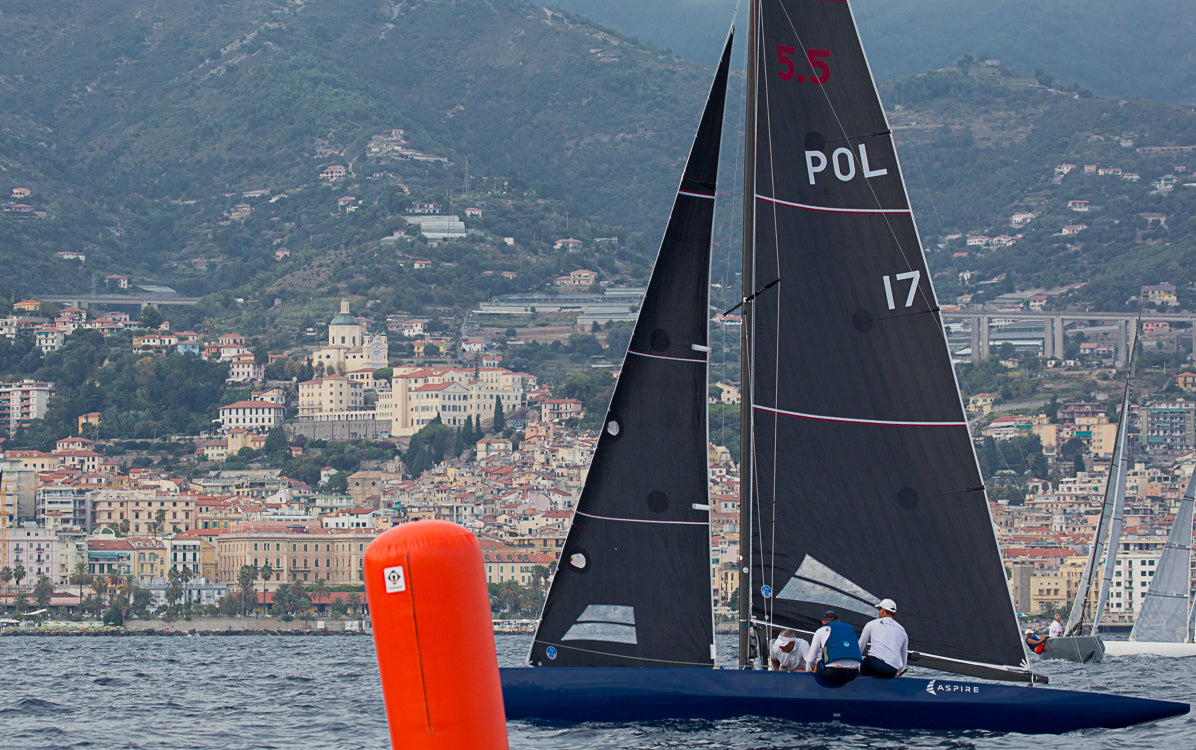
ASPIRE WINS THE 5.5 METRE EUROPEAN CHAMPIONSHIP
#NSVICTORYLIST: 5.5 METRE EUROPEANS
Aspire’s Mateusz Kusznierewicz Sweeps the Fleet
Congratulations to Aspire’s Mateusz Kusznierewicz, Przemyslaw Gacek, and Simon Fry 2020 5.5 Metre European Champions! 📸 Robert Deaves
The 5.5m Class is one of the very few classes this year to hold a Worlds and European Championship. All sailors respected the organizing authorities’ mandatory guidelines to prevent the further spreading of the virus, carefully social distancing and taking their temperatures each day before going to their boats. While adhering to the safety protocol, sailors still made the best of the event, and San Remo provided excellent racing conditions.
Teams were noticeably excited to be out sailing again, as this was the first event for the class since January. The conditions in San Remo showed the fleet a mix of conditions, and North’s client results were proof that our products for the 5.5 Metre can deliver top results in any wind condition. North Sails class expert Christoph Burger on New Moon II explained, “As a class leader for North Sails, I am always thinking of ways to make our products better. Sometimes these can be smaller things or new designs. Right now, I am focusing on the smaller things to help our clients gain that extra performance boost.”
📸 Robert Deaves
Christoph explains: “The 5.5 Metre class is on the right track and very attractive. We swept the podium here at the Europeans and our clients filled almost all of the top 10 spots. About 20% of the fleet has newer boats too, and there are some new building projects in the works we are all excited about.”
Christoph commented, “Before the regatta, we had one week to train, so we lined up with Otto (NOR 68) and Momo (SUI 229) to make sure we were up to speed. At the regatta, we took the bronze. “Every team is fast,” explains Christoph. “We all had speed, so it came down to strategy and tactics to do well at this regatta. The top end of the fleet was very close in scores. The tiniest mistake would cost an entire position. This year’s conditions were challenging. Aspire sailed an excellent regatta, ending their speed streak with two bullets to close out the event. Well done!”
📸 Robert Deaves
New Moon II used North Sails MNi-1 All Purpose Mainsail, Li-2 Jib Light Jib, and S-2 Spinnaker in the lighter conditions. Christoph explains, “This choice of North’s upwind sails are designed to be used in the light winds up to max 12 Knots TWS, so they were the perfect match. We chose to use the AP mainsail because we wanted to be ready if the wind got stronger. For the moderate wind races, we only changed jibs, shifting to our Mi-1 Medium Jib. These choices proved to be the best for the regatta.”
Congratulations to Aspire’s Mateusz Kusznierewicz, Przemyslaw Gacek, and Simon Fry 2020 5.5 Metre European Champions! In second place was Momo’s Dieter Schon, Markus Wieser, and Thomas Auracher, followed by New Moon II’s Mark Holowesko, Christoph Burger, and Peter Vlasov.
Next up is Régate Royal in Cannes and the season finale in Thun, Switzerland.
Full Results
Want to learn more about North Sails 5.5 Metre championship-winning sails? Contact your Class Expert for more information.
📸 Robert Deaves
READ MORE
READ MORE
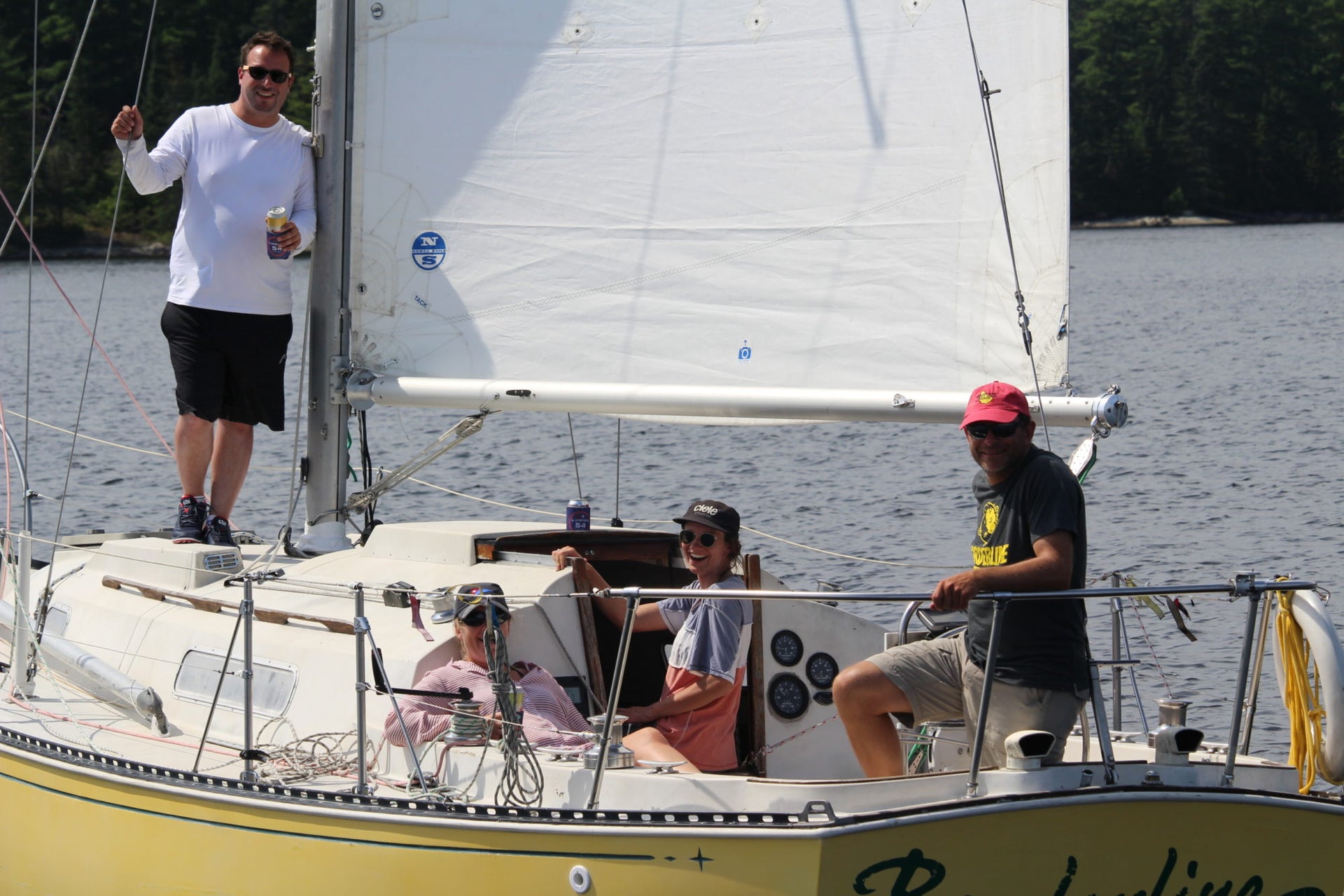
EVENT SPOTLIGHT: LOWISA 2020
EVENT SPOTLIGHT: LOWISA 2020
Locals Gather For Annual Regatta
North Sails expert Drew Mitchell out of Vancouver reports from the annual LOWISA regatta in Lake of the Woods.
After 54 years of LOWISA being the sailing event to attend within Manitoba and Western Ontario, the 55th edition had to be postponed to July 31- August 7, 2021 due to Covid-19.
If you have not heard about LOWISA before, it is an amazing race with a lot of history. Back when sailing was thriving, the regatta would get over 100 boats! There are many families who have been racing LOWISA for many generations. The regatta is a 7 day, 6 stage distance race around Lake of the Woods nearby Kenora, ON. On a normal year, the Regatta starts off at Northern Harbour just outside Kenora and loops around islands of Lake Of Woods, some of the time even going down into the US.
They usually do roughly 20-30 NM legs per day and end up all at the same anchorage for the night. All the boats raft up after racing and start making dinner, enjoy a cocktail and talk about the day of racing. Depending on the day, there are social events such as island rum parties, cocktail making competitions and I've even seen a float plane fly in pizza for a pizza party! After three days of amazing racing around islands they choose a fishing lodge and have a layover day. The layover day is always a good day for rest but also fun activities. The standard activities are a football game, USA VS CANADA, a talent show, paddle board race and a North Sails presentation.
After the lay day is over, they race three more legs back to Northern Harbour where they have the awards after the last day of racing. A neat part of LOWISA is they give out awards for 1st, 2nd and 3rd but the awards that are most sought after are the LOWISA Spirit Award, the award for the boat that overcame the most obstacles to get to the event and the sailor that was showed the most sportsmanship during the event. These awards always get the most cheers and laughs as they ask the winner to come up and give a short speech.
This year’s informal gathering was a bit different without the friends from the south and a formal itinerary. There were raft ups at the anchorages but these were kept smaller with little to no on shore activities. They spent one night at a fishing camp where a dinner was offered outside and eaten at picnic tables. I also ran a North Sails talk about sail maintenance and repair. Despite the restrictions, the week was a great time with great cruising and even better weather.
Everyone is looking forward to the 55th edition of LOWISA as Commodore James and his team have now had two years to plan it. It's going to be one for the ages and I think everyone is excited to have the Americans back and proper sanctioned racing to be had.
Let us know if you would like to join the fleet. They would be ecstatic to have you join.
Please check out Lowisa.org or Lowisa on Facebook for updates.
READ MORE
READ MORE
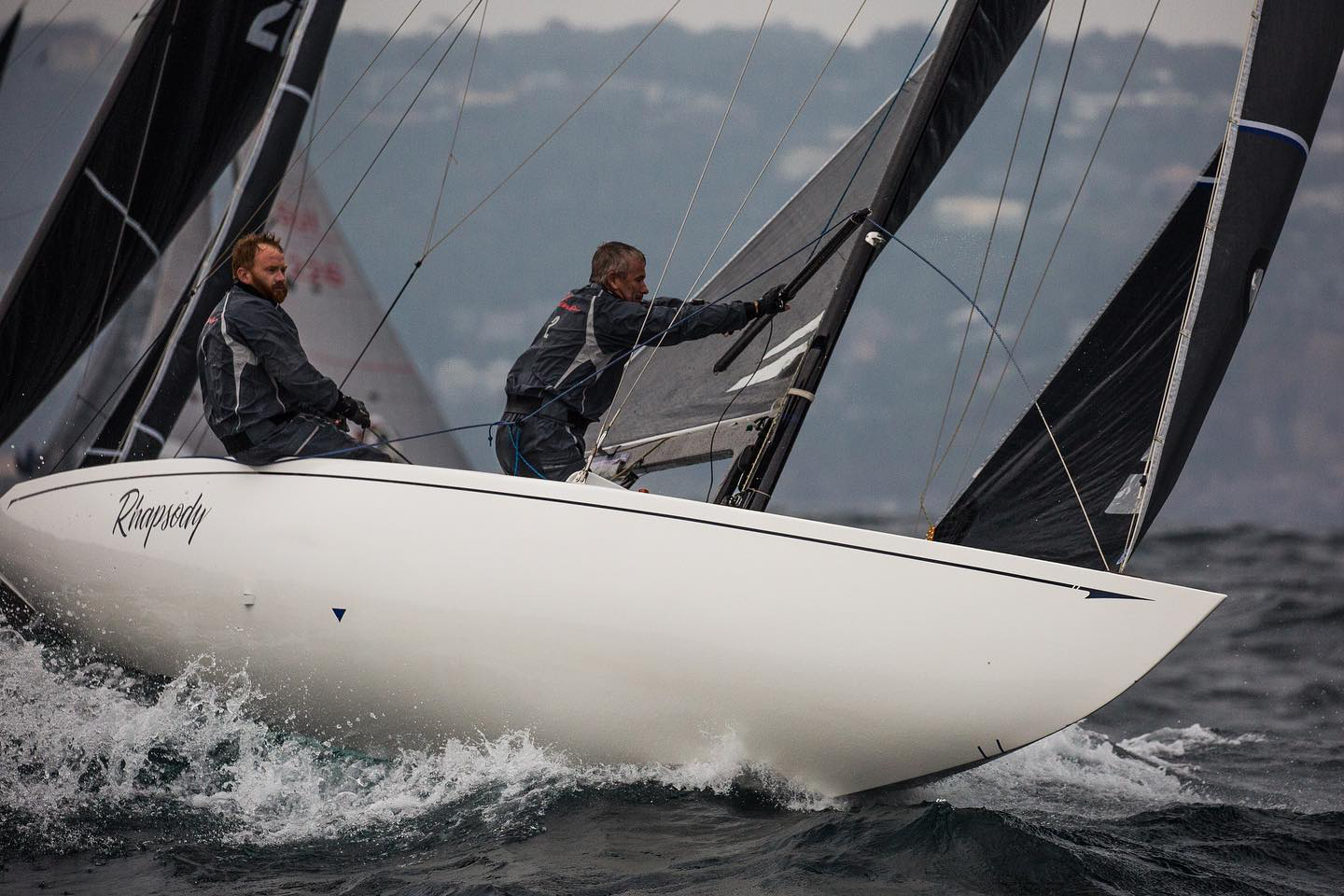
TOM SPITHILL JOINS TEAM AUSTRALIA
NEW ADDITION TO TEAM AUSTRALIA
Tom Spithill Joins North Sails Sydney
North Sails are pleased to announce the addition of Tom Spithill to the team in Australia.
Growing up in Elvina Bay on the waters of Pittwater as a part of a sailing family, Tom was chucked into a boat at a young age.
Since then Tom has continued to sail, and up until recently was the head coach at the RPAYC for over ten years where he coached many successful youth and open teams and was awarded both NSW Coach of the year and Australian Coach of the year.
Tom has a passion for teaching veterans and first responders sailing, and was an integral part of the Invictus Games Sydney in his role as Sports Competition Manager.
More recently Tom has been enjoying sailing his foiling moth Wendy Jnr and his classic international 5.5 metre Baragoola.
“I've enjoyed hopping out of the coach boat and getting back out on the water, doing as much yachting as I can, whether that be a non spinnaker twilight, or a world championships.
Tom was a client of North Sails prior to joining the team, using championship-winning sails on his 5.5 Metre and the 3Di Decksweeper on his Bieker Moth. Tom commented, "both of which I have been equally impressed with."
What does Tom hope to do for North Sails clients? He commented, "I'm looking forward to sharing my passion with other like minded sailors, while helping new and potential clients marry up with the right product for their type of sailing."
We are proud to have Tom on our team in Australia. If you have any questions about optimizing your inventory, please contact Tom.
© Martina Orsini
READ MORE
READ MORE
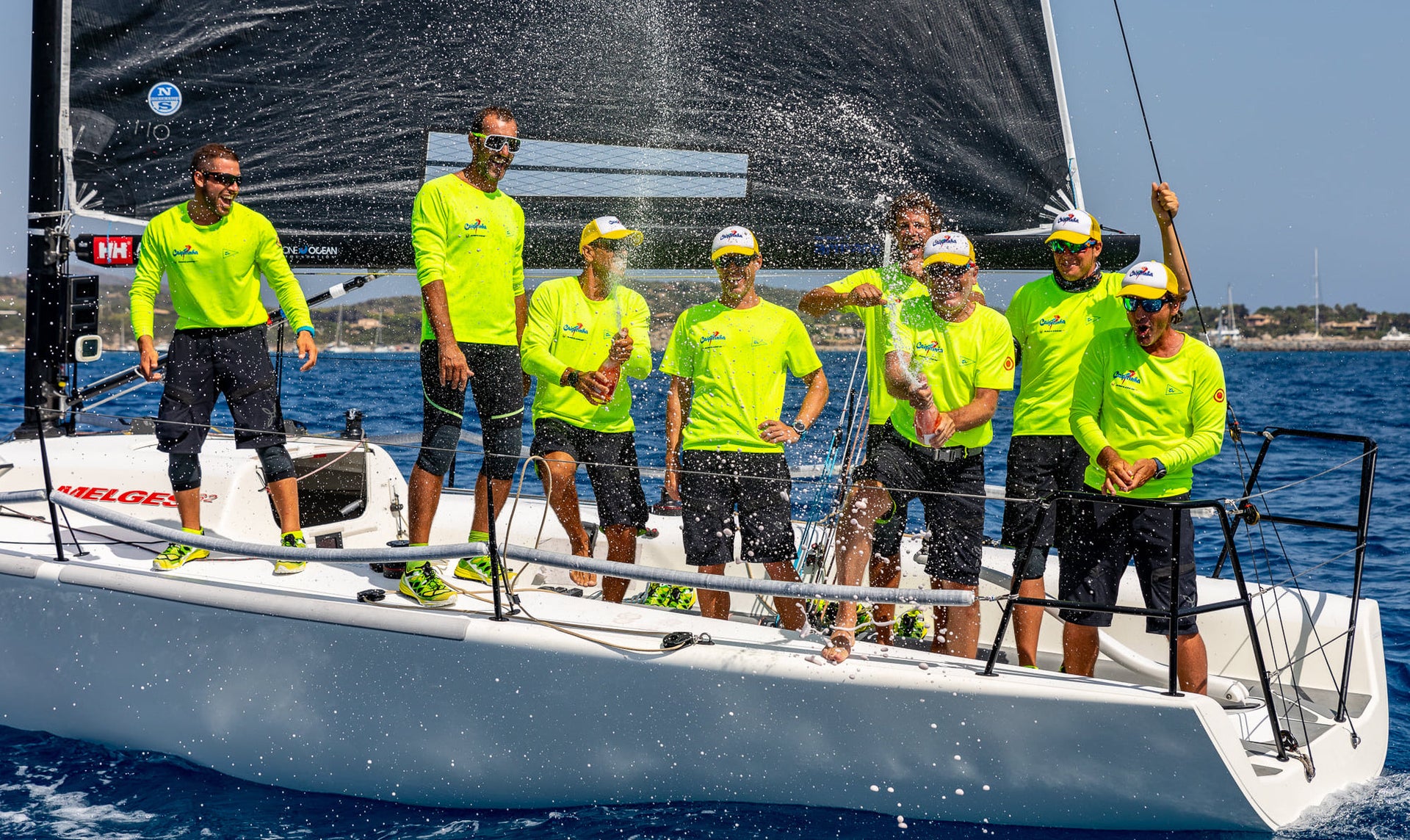
#NSVICTORYLIST: CAIPIRINHA IS 2020 WORLD CHAMPION
#NSVICTORYLIST: CAIPIRINHA IS 2020 WORLD CHAMPION
Mainsail Trimmer Alberto Bolzan’s Take on the Melges 32 Worlds
📸 Zerogradinord / MWL
The racing season for Martin Rejnes’ Caipirinha* started a little different than usual. Typically the crew gets together before the season begins and spends time on the water practicing and attending as many events as possible to get up to speed. Still, with the threat of COVID, their season jump-started at their first event. In a typical environment, the season’s start would allow teams to train and focus on improvement areas. This year, an exceptional year indeed, teams had little to no opportunity to fine-tune. Catching up with the mainsail trimmer, Alberto Bolzan, who had much to say about how this season was unlike others, but all the same how fun it is competing in such a high-level class with great competition and camaraderie.
“It was a bizarre season beginning for us. Starting much later this year, it was full-on, just taking what we’ve learned in previous years and trying to start where we left off. Fortunately, we were very fast from the get-go, as in previous years, which made things a little easier for us to get right back into it.”
📸 Zerogradinord / MWL
Villasimius served up a little bit of everything for competitors, challenging all scopes of the crew work, boat speed, and tactical decisions. Alberto comments, “the secret to our success was speed, hands down. Thanks to that, we were able to take a conservative approach to each race for this championship. We also were very consistent when it came to race results. We did not win any races, but we kept our point count low.”
When it came to staying conservative, Caipirinha* made sure they got off the line. Clear air meant speed, which made all the difference. As far as staying consistent, it wasn’t only about race finishes. The team has the same pre-start plan, which they execute each race at each event. It included matching up with the fastest boats to make sure you were where you needed to be on the rig. “We made sure we stayed close to our competition,” said Alberto. “Although we got no bullets, we sailed what I would call a perfect championship.”
📸 Zerogradinord / MWL
Before each day begins, their routine comes into play. “We assess the conditions, look at the forecast, and think about what we can do with our sail set up and rig tune. Once we leave the dock, we scope out the racing area. We sail around and try to figure out if any risks are depending on which side of the course we are on, so there are no surprises,” said Alberto. Collecting valuable information before the race started allowed them to focus on other things. “In a few of the lighter air races, making the right observations pre-start was the contributing factor to our success,” said Alberto.
What makes Capiriniha’s* sailing program strong is that the core team sails together in other classes. “We’re good friends, says Alberto. “And we know what a fast boat should feel like. So you put us together on one boat, and we can make it happen.” The team also gives thanks to their coach Flavio Grassi who has provided them with feedback based on observations and can find the tiniest things they can work on that make a huge difference. “Flavio comes from America’s Cup and Olympic background, so he analyzes every move we make and helps us improve each time.”
📸 Zerogradinord / MWL
The average experience level in the Melges 32 class is very high, so each team is a threat. Caipirinha* is always working to keep things easy and straightforward. That way, no mistakes can happen, and they can put themselves in a fair position to have a good race result.
“Our closest competition at the event, second place finisher Christian Schwoerer on La Pericolosa is fast, no doubt,” says Alberto. “Every time we see them, we are challenged. Last year, this year, they are very fast. That has made the game of winning that much more fun from a sports aspect.”
As far as the event location, Alberto loves the venue. “Villasimius, Sardegna is such a great place to host events. They have top-notch conditions, always challenging, which makes the perfect platform for fleets like the Melges 32 to come and play.”
📸 Zerogradinord / MWL
North Sails has been working hard to develop the fastest sails for the Melges 32 class for many years to help clients perform their best. Alberto comments, “North’s experience is unrivaled, not just from Italy, but from all over the world. How the sails have evolved and how high-level the technology is now, makes the class what it is today–the perfect high-performance platform.” North Sails class experts want to congratulate team Donino, Gspot, Vitamina, and new teams, Star Telekom and Heat, for their hard work during this challenging year.
Now that the Worlds have come and gone, is it all over?
Alberto says, “It’s never over. We will be working together in this class and others, always working hard to be the fastest boat with the fastest sails on the racecourse.”
Race results
Have questions about race-winning sails? Contact your Melges 32 Class expert today.
📸 Zerogradinord / MWL
READ MORE
READ MORE
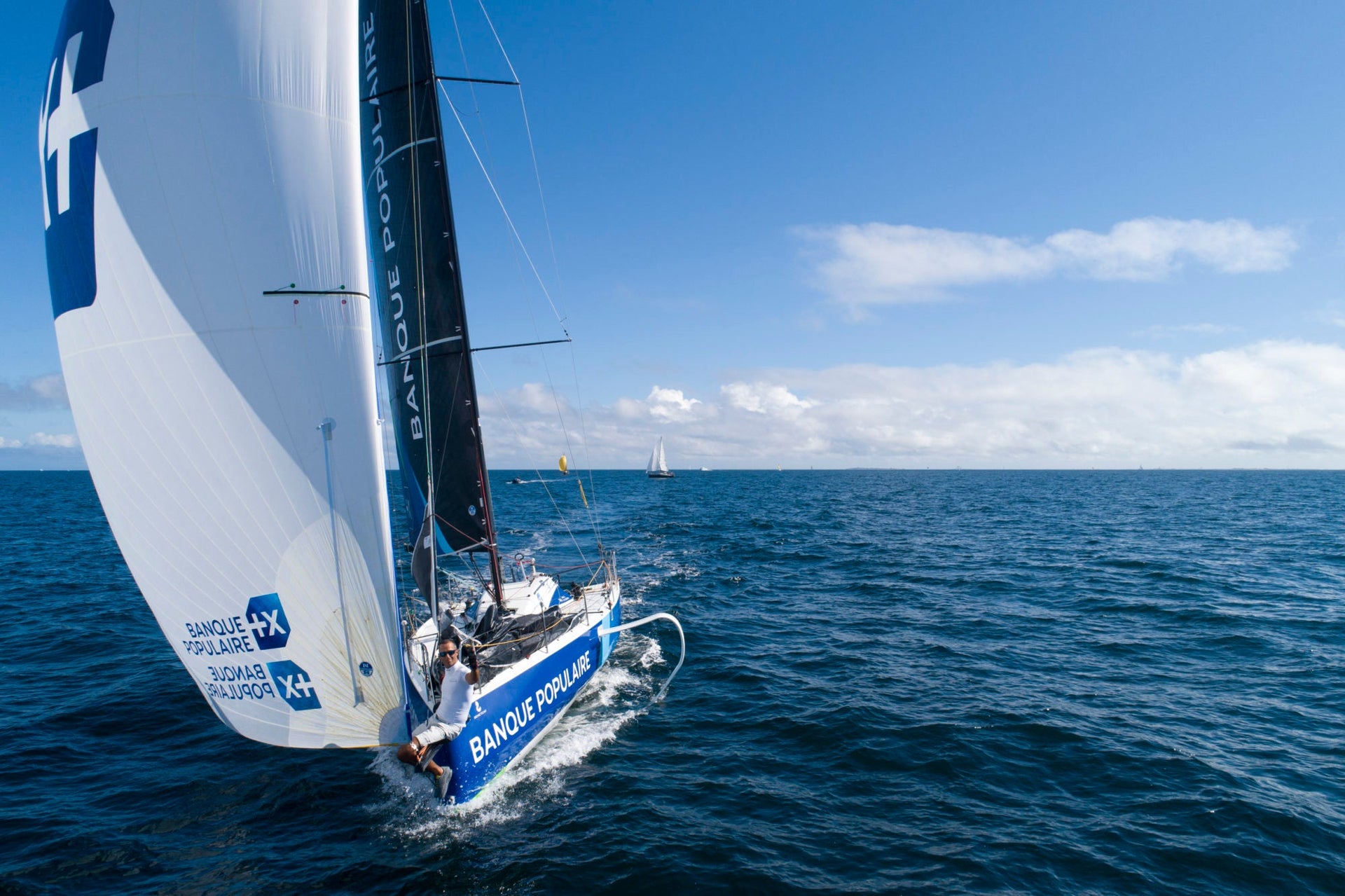
THE STORY BEHIND THE SAILS
THE STORY BEHIND THE SAILS
The Solitaire du Figaro is an unrivaled ocean race and demanding on the sailors who participate. It requires grit and teamwork to make it to the start line.
📸 Alexis Courcoux
The Solitaire du Figaro is an unrivaled challenge in ocean racing. Whether it is the craft on which the sailors’ race – the Figaro Beneteau 3 hydrofoil -, the format of the race over four short legs, the frantic pace where the management of sleep and mind is required, the demanding course with complicated conditions or the heterogeneous profile of Figaro sailors who compete on an equal footing. This unique competition is the meeting ground for renowned sailors who come to test their abilities with young, sometimes up and coming sailors who aspire to enter the big league, in search of a springboard to a career in ocean racing.
At North Sails, Quentin Ponroy, sail designer, and Gaétan Aunette, technical salesman, are responsible for Figaro projects. They take stock of the race and work with the skippers to bring their project to fruition.
Why is the Figaro Class Championship attracting so much interest? And why is the Solitaire du Figaro an unrivaled ocean race?
The Figaro Class is the only one-design single-handed ocean racing yacht with an accessible format and affordable budgets for racers and partners. The championship includes a renowned flagship race, the Solitaire du Figaro, and brings together both young and experienced sailors who regularly compete against each other. It’s a great mix of talent at a high level.
The Figaro Class is a competitive platform where sportsmen and women want to assess their level in ocean racing, and sometimes the reality can be severe or not. If we can compare it with another sport, soccer, it would be a bit like the Champions League of ocean racing where the best, as well as the enlightened amateurs, have gone through it. For us, it’s great work in terms of project development with our customers.
What is the profile of a Figaro sailor in the way he or she sails and trims?
There are as many profiles as there are Figaro sailors. Each one has their own history with divergent backgrounds (Olympic, FFV, cruising…), their style of tuning, and driving their boat. They are also part of different training centers. And so we need to have a strong capacity to listen and then to meet the needs of each one, to design the best sails, to adapt to both their unique style and the one-design support. Some racers want sails that are identical to the others and will try to stand out in other aspects such as strategy. Others are looking for the best possible sail to make the difference in speed and are willing to spend time with us to develop their sail set and achieve the desired result. In general, they are very receptive to our advice. In any case, it’s all about the details, because the level is very high.
How do you design a set of sails in the Figaro Class?
In 2019, the first year of the Figaro 3, most of our work was based on studies carried out from and around the boat’s build plans (design process identical to IMOCA boats, etc.). This year and for the years to come, we are modifying and optimizing this base thanks to prototypes (1 to 2 per year and per sail) designed based on feedback from the skippers and all the tests we do with them (design process identical to the one-design series). The precision and the level of requirement of the skippers in this class are unique for an offshore series. The set of sails being almost the only non-one-design parameter in this series, the racers necessarily devote a lot of time and attention to it. Together, we manage to get detailed work. In IMOCA and Class40, for example, the skippers have to take into account several non-one design parameters (boat design, foil, electronics…) and therefore have proportionally less time for the sails.
The three main stages of Figaro design include the drawing of the 3D mold of the sail, the adapted design of the structure (3Di being a real strength because of its dynamic shape retention, reliability, and longevity; our competitors use for the most part more classical membranes), and meticulous manufacturing in the detail of the sail (the stiffness of the battens, the halyard ring offset, the reefing system… are studied with precision).
What changes have been made to the sail plan in the Figaro class since the previous edition?
We are only in the second year of the evolution of the Figaro 3, but almost all aspects have been reworked. The main trends on the flat sails are the weight saving in the structure, the volumes that have advanced in the Genoas, and the introduction of load-sharing Helix structured luff technology in the Gennaker among others. The rest is confidential.
What learning comes from the sails of Figaro?
The boat performs well upwind. Moreover, with the arrival of the Gennaker, the main and J2 sails are real sails specifically designed for VMG upwind sailing.
Can the work done on the Figaro be applied and highlighted for other classes, particularly in IRC and club regattas?
Absolutely, because the latest IRC boats such as JPK or SunFast have similarities with the Figaro 3. Moreover, the use of reduced crew in IRC is more and more present and is getting closer to that of the Figaro. For these two reasons, the work done in Figaro 3 is largely transposed to IRC.
What is your relationship with the skippers?
Sometimes we exchange via SMS late at night… We obviously have a relationship of trust, listening, and exchange. It’s important to understand their needs. They are the ones who, through their feedback, make the sails evolve. Our job is to transcribe their feedback on our North Design Suite software.
How do you arrive at the ideal inventory for a skipper?
We exchange a lot beforehand through different modes of communication and gather all the information concerning the type of materials, the shape of the sails, the gauge, the tests, the service on the regattas, the training sessions for test sails, the estimate, the delivery, etc.
As far as the choice of sails is concerned, the skippers base their choice on several parameters such as the feeling with the sail (feeling and performance), the risk-taking (who among the other competitors uses this same sail? Am I the only one or do several racers have the same one?). Finally, there are the effects trends in this race. Each racer is free to ask us to customize his inventory around a standard model per sail.
Can you name the sails and their function in the Figaro class?
Mainsail | J3 front breeze sail | J2 light and medium close-hauled sail | Helix GK multi-purpose reaching sail | A5 spinnaker for strong wind | A2 spinnaker max for VMG down | TMT safety sails
How do you assist the sailors to make the most of their sails specially designed for this race?
We spend time explaining how the sail is designed, its shape, and potential. And we follow up on the training sessions, we ask them for their technical feedback on each sail according to the sensations, speed, ease, versatility, trimming, the stability of the sails under pilot, etc. Then, we proceed with the development of the sail to improve all the points mentioned above.
What evolutions can still be made on the Figaro class sails?
The shapes and structures will always evolve, to a lesser extent, sometimes with some backtracking, but the evolution will be continuous. We will still be able to save weight, improve the shapes… We already have a lot of ideas for this winter. We also need to have the right timing in our evolutions and our tests on the sails in order to anticipate and be reactive.
READ MORE
READ MORE

DOUBLEHANDED TIPS FROM ARMEL LE CLÉAC'H & CLARISSE CRÉMER
DOUBLEHANDED TIPS FROM ARMEL LE CLÉAC’H & CLARISSE CRÉMER
Masterclass Takeaways from the Live Webinar with Ken Read
Armel Le Cléac’h & Clarisse Crémer during the Transat Jacques Vabre 2019 📸 Alea
North Sails were lucky to have the two doublehanded experts Armel Le Cléac’h & Clarisse Crémer host a webinar for an in-depth masterclass.
Best known as a singlehanded sailor with notable race wins in the Solitaire du Figaro, Transat AG2R and the singlehanded Transat, Le Cléac’h’s accolades also include a record-breaking finish in the 2016-17 Vendée Globe. Crémer is an up and coming sailor, making a name for herself during the Transat 6.50 in 2017, where she finished second in her class.
Did your partnership come naturally?
Le Cléac’h and Crémer began their partnership in 2019 when Crémer was scouted to join the Banque Populaire team, racing the IMOCA platform with Le Cléac’h. The team’s training gave Crémer the confidence and experience to pursue a singlehanded campaign for the 2020 Vendée Globe later this year. Although sailing with the best-brought pressure, Crémer explains that “Armel is confident, calm and explains everything well on these kinds of boats.’’ Together, the French duo finished sixth overall and took the top spot in both the non-foiling and mixed crew classes in last years’ Transat Jacques Vabre (TJV).
How did you go about choosing the right teammate?
Define your roles at the start. Even though the responsibilities may change over time, it is important to have defined roles onboard, with the most important being safety. Both team members must know where everything is onboard and what to do if there is a problem. During the TJV, Le Cléac’h was responsible for weather, strategy, and route planning, but as Crémer gained experience on the boat, her role evolved as her confidence developed, to the point where she was able to make decisions and changes whilst sailing.
Know how to do every job onboard. Try changing roles in training so you understand and realize what your teammate is doing.
Choosing the right teammate. Time on the water training helps you get to know people better, so sailing and training together lots before doing a high-pressured race. There are three important factors in finding the right teammate: having the right personality to be able to work together, physical ability to handle the job, and mental state to know what to do and figure out how to solve problems.
Understand your boat. To get into offshore racing, you can’t just be a sailor anymore. You’ve got to be a sailmaker, boat builder, electrician, rigger, as well as being a trimmer, navigator, and helmsman!
📸 Easy Ride Videos
Why Shorthanded Sailing?
Shorthanded sailing is an important part of France’s culture, sparked in 1964 by the French legend and offshore sailor, Eric Tabarly. Tabarly made a mark in history when he won the singlehanded Transat, arriving into Newport, Rhode Island, two days earlier than the next sailor. He went on to win future offshore races and became an inspiration for France.
France now provides some great racing platforms for singlehanded sailing, which is how Le Cléac’h got involved. When asked if single and doublehanded sailing are similar, he advised: “Doublehanded sailing is like sailing solo, for two. To perform well in doublehanded sailing, you almost need to be two-single handed sailors.’’
Crémer got hooked on the thought of adventure, completing the singlehanded Mini Transat Race as her first offshore race. “Shorthanded sailing is a good opportunity to do more strategic roles and learn as much as possible, especially when sailing alone,’’ she says. “It gives you the chance to do everything and make all the decisions – the best way to learn!’’
“Doublehanded sailing is like sailing solo, for two. To perform well in doublehanded sailing, you almost need to be two-single handed sailors.’’
Clarisse Crémer: A Women on the Rise in the Sailing World
As well as being important for women sailors in general, role models are vital for new, young female sailors coming up through the sport.
Crémer started sailing as a hobby when she was young on holidays and began racing at the age of 16, discovering the world of offshore racing in 2010 through University. Saying yes to every opportunity led to her decision in 2015 to take part in the Mini Transat, marking the time when she became fully committed to the sport. “I always loved sports, competition, and the sea in general. I was especially driven for the adventure of the Mini Transat. This race gave me my love for offshore sailing.’’
“Shorthanded sailing is a good opportunity to do more strategic roles and learn as much as possible, especially when sailing alone.’’
Up next for Crémer is another exciting opportunity to be part of the Banque Populaire team for the 2020 Vendée Globe, leaving from Les Sables d’Olonne on the 8th November 2020 for a non-stop race around the world.
Her advice?
“Progressing and reaching the stage where you feel useful (and not just a weight moving from one side to the other), can be hard on a crewed boat.” This is why singlehanded sailing appealed to Crémer, as it provided more opportunity for tactical decisions and driving.
“Have confidence if you want people to trust and choose you for different positions on the boat. Otherwise, only results and other experiences will allow you to be legitimate. The more I practice, the more my confidence grows which is the only answer to my doubts. One thing I did learn is that you can be confident without being loud!’’
Missed the live webinar with Ken Read? Catch up now.
📸 Easy Ride Videos
📸 Jean-Marie Liot/Alea
READ MORE
READ MORE

EVENT SPOTLIGHT: WELCOME BACK REGATTA
EVENT SPOTLIGHT: WELCOME BACK REGATTA
Locals Take To The Water
Lunenburg Yacht Club held the first sanctioned regatta in Nova Scotia since the start of the pandemic. They named it the Welcome Back Regatta and was organized in less than three weeks! Lunenburg offers some of the best summer sailing in North America. It is not only held in the clean open waters on the South Shore of Nova Scotia, it normally offers 25 degree weather with a 15-25 SW sea breeze. Lets just say last weekend did not disappoint.
There were 35+ boats and 5 fleets on one course. Two PHRF fleets, a sonar, an IOD and a J105 fleet. With the local PRO expert Colin Mann running the event everyone knew that it was going to be a great weekend. Day 1 was a classic Lunenburg sea breeze. It took a little while to get going but once it settled it was great racing. The IOD fleet got 1 race off as the wind got above their class limit and had to head in. The rest of the fleets got 3 races in with the last one being a race back to Yacht Club. Breeze was a steady 20-22 knots with a decent swell coming in from the ocean. Drew Mitchell from North Sails was on the water taking video and pictures of the racing. Once everyone got back to the yacht club there was a BBQ, sponsor tents, daily prizes and a North Sails booth inside the club with the videos and pictures playing on a TV. Day two was postponed until 1 o'clock to let the breeze come in. Racing started at 1 pm sharp and 3 great races got off in 8-14 knots. Again everyone came into the club after racing and enjoyed a BBQ while chatting about the racing. Many sailors hung around the docks and yacht club until late and enjoyed the standard sailor chit chat and beverages. Day 3 had a bit of a surprise with the Bluenose II sailing across the race course before the racing started. Once the racing started the breeze was very similar to day one in terms of direction and strength. Started around 8-10 knots and quickly built to proper sea breeze. Colin got the IOD's off first so they could make up for some races lost on day one. IOD's got three races in and the rest of the fleets got 2.
Having spent the better part of a lifetime in the business it was wonderful to be reminded how much fun it is to race boats. Welcome back!
After racing everyone headed back to the club except for a few Chester YC boats that just continued downwind to Chester. Dinner and Awards were a hit with local sailing hero Andreas Josenhans presenting the awards. I know everyone enjoyed the regatta and I would like to pass along a big thanks to the organizers especially Jennifer Hall and the Mann family as well as a thank you to all the sponsors. A final straw in the regatta cap was when I was walking down the dock to head home I heard a group of sailors saying " hopefully we can have another event like this next year."
Regatta Chair Jennifer Hall shares, "As one of the only keelboat regattas in North America this summer, it’s not surprising that sailors from across Atlantic Canada were keen to come to Lunenburg for the LYC Welcome Back Regatta this past weekend. The success of the event is thanks to all the Club volunteers who made it happen and the support from our event partner and suppliers, including North Sails."
Please check out the results and contact Drew Mitchell, based at North Sails Vancouver, if you would like to see any pictures or videos taken on day one of the event. Photos below courtesy of Sky Sailing Studios.
Photo courtesy of Sky Sailing Studios
Photo courtesy of Sky Sailing Studios
Photo courtesy of Sky Sailing Studios
Photo courtesy of Sky Sailing Studios
Photo courtesy of Sky Sailing Studios
READ MORE
READ MORE
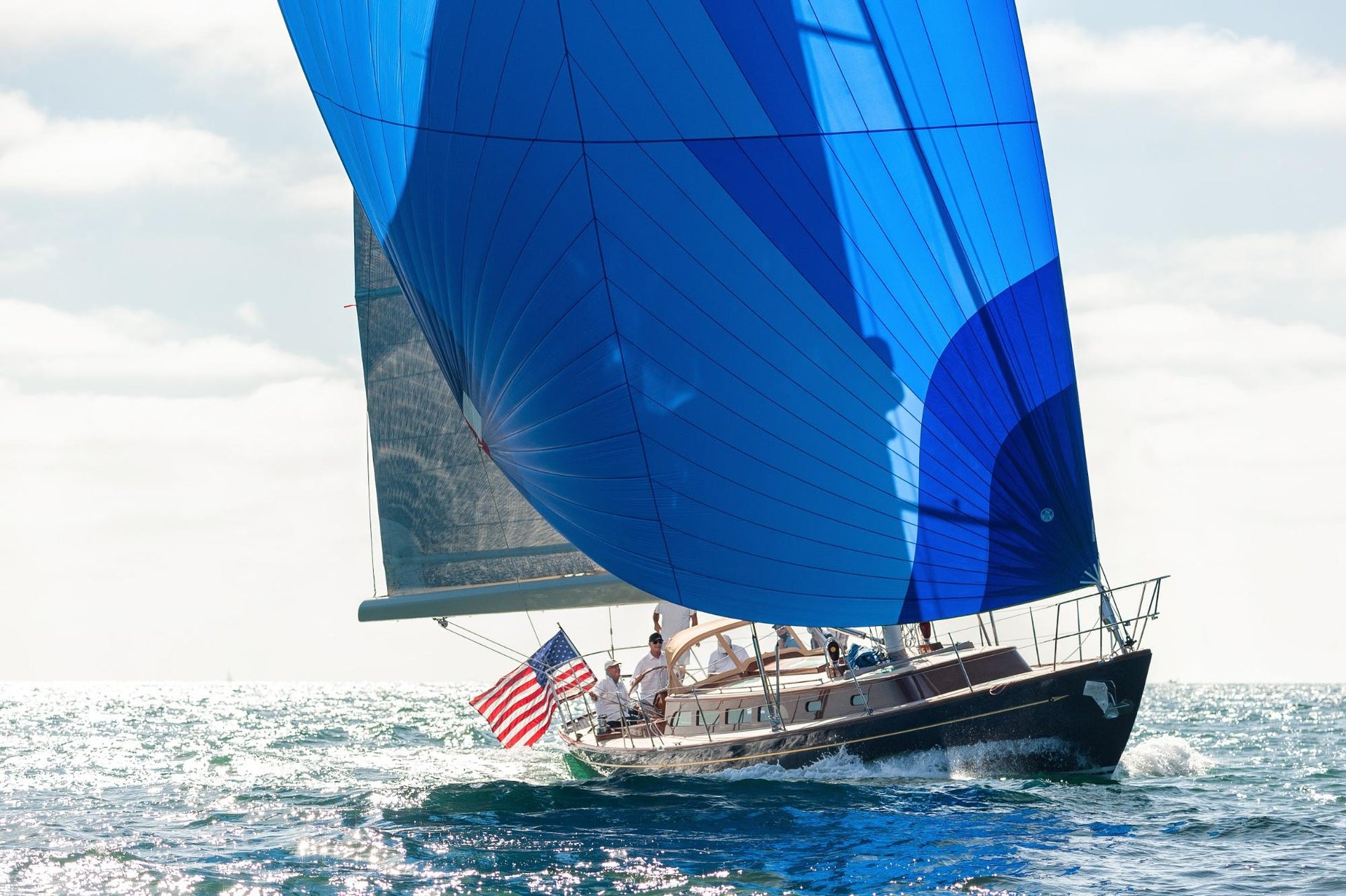
SAILS, SUPPORT, AND SERVICE GO THE DISTANCE
FINDING THE RIGHT SOLUTION FOR THE ULTIMATE CRUISER
Sails, Support, and Service Go the Distance
📸 Mark Albertazzi
Point Loma native, Morgan Dene Oliver (Dene) started sailing when he was eight years old on his North-fitted Sabot out of Mission Bay Yacht Club. “I was thrilled when my dad bought me a Sabot. I’ll never forget it. Since then, I’ve owned six different sailboats from 35-62 feet, and all of them have had a North Sails wardrobe.”
Dene was in the market for a different type of boat this time around. He wasn’t going to be racing, purely focusing on enjoying his time on the water.
“This time I wanted something different,” said Dene. “But not a racer. Something for ultimate day sailing in San Diego. I found this extraordinary boat built at the Morris yard in Northeast Harbor in Maine. It’s the largest boat but also the most sophisticated model Morris has ever built. Commissioned four years ago, the engineering team collaborated with Sparkman Stephens and Ted Fontaine to did a fantastic job. She’s like the prettiest girl at the prom. No matter where I go, everyone wants to see her. Everything is a push-button; Up and down, in and out.”
My idea of the perfect sail consists of sailing straight out into the Pacific from San Diego, CA. I could go for 24 hours or so, then turn around and come back. Throw in an 80-mile downwind or broad reach with a nice swell behind me; that’s what I’m all about now.”
Dene Oliver, excited for another great day on Solutions II in San Diego!
The big delivery
Dene acquired his Morris 52 Solutions II in January. She got a new paint job in Camden, ME, where she was safely stored for the winter season at Lyman Morse. Solutions II was then trucked across the country from Camden, ME to San Diego, CA, in February. “Imagine a 52-foot sailboat with an 82-foot mast (that’s 20 feet sticking out behind the trailer!). Boy was that a sight to see!” said Dene. “She arrived here in San Diego, and because of the state shut down for COVID, I had to wait a month and a half to get her in the water. She was launched in the beginning of May, as the team at North Sails in San Diego went above and beyond to get her ready to sail, and I’ve spent as much time as possible with her since. Solutions II is a work of art on the water.”
Expertise, sail service, support, and friendships
“My experience working with North Sails has been a great one,” says Dene. “To me, it’s about the people you meet and the relationships you develop. With North, I’ve always been taken care of, treated fairly, respected; there’s trust in our relationship. Feeling important and knowing I am in good hands is what I like best about the whole deal. The team here in San Diego is a team I can rely on–hands down.”
Dene explains, “My service expert Eric Heim, with the help of sail expert Brian Janney, Marnie Jenkins, and John Gladstone quickly supported my new program once Solutions II made it to the West Coast. I can’t thank them enough for their help.”
Longtime friend, sail expert, and now boat broker John Gladstone enjoying the sail testing with Dene and the North crew.
John Gladstone is now Dene’s boat broker (Fraser Yachts) and has played an intricate role in helping Dene not only find the best boat, but help the San Diego team coordinate to find sail solutions to suit Dene’s needs.
John explained, “Although I am working with Dene from the other side of the industry these days, I still find myself supporting him with the whole package. Time has gone by, but we’ve worked together for so many years. It’s just as fun and rewarding as it was back then. My first interaction with him was in the 80s as his primary North sailmaker on several of his earlier yachts. Dene has always done things well, first-class– and all with a contagious passion. We are having a blast with his latest addition, Solutions II, the most exquisite Morris 52 you’ve ever seen. Solutions II is not your average day sailor!”
The value of seasonal service
“When you buy something,” says Dene, “you aren’t investing in the asset alone, you are investing in the care of the asset, and you have a program plan to keep things running smoothly. Like all features of the boat, the hull, through-hull fittings, your sails–these things need attention. Tweaking here and there is part of normal maintenance, but most important, having your sails inspected regularly ensures you have a good day on the water, every time.”
📸 Mark Albertazzi
That #firstsailfeeling
Once the boat left the dock, the mainsail and jib were deployed. John said, “I anticipated that when we got the sails up, he may be in the market for replacing them, knowing they were a bit old. Unbelievably, his 3DL sails still look amazing! That goes to show not only how well the previous owner and now Dene takes care of things, but how involved Dene was in finding the perfect boat that had top-notch gear. He was looking to add more excitement to his off-wind sailing, which is where the idea for an optimized downwind sail came into play.”
Solutions II is now equipped with a new G1 top-down furling gennaker. With the top-down function, Dene can set it all up before he even leaves the dock. He can hoist it and have it ready to deploy at the touch of a button. Powered winches allow for easy furling and unfurling, all leading back to the cockpit. The advantage of his new sail addition is that it’s a ready-made system. When he’s done using it, he furls it and then drops it into a zipper bag on deck to safely store for next time. It fits perfectly in the custom length bag without being folded or compressed into the forward storage locker..
“I don’t mind a little challenge here and there, but I need to have options that work best for my type of sailing,” said Dene. “Many reasons led me to add a more performance-based sail option to my inventory, like this hot new downwind sail. It’s added significant speed off-wind, and it’s unbelievably easy to use.”
Why top-down? John commented, “We knew he needed something big enough, but also something he was comfortable using shorthanded, which is most of his sailing these days.”
“By adding the new G1 to Dene’s inventory options, Solution II’s performance downwind has increased tenfold!” said John. “Working with Dene is always a great experience. Just being able to get out on the water, let alone on such a beautiful yacht with an appreciative owner, is such a treat.”
Client support is key to any sailing program. “Dene likes to know that his best interest is at the top of the list. Having trust in his longtime sailmaker enables him to make the best decisions so he can enjoy his sailing which is the most important thing. Dene has exquisite taste and appreciates perfection, and everyone who’s worked with him appreciates that about him too,” said John.
📸 Mark Albertazzi
READ MORE
READ MORE

A GLIMMER OF HOPE
A GLIMMER OF HOPE
North Sails Experts Team Up For J/70 Tuning Session
Photo courtesy of Lisa Bronitt
Since the pandemic hit, many sailors around the world have resorted to day dreaming about sailing. Regattas were cancelled or postponed, goals were pushed back, and boat work was no longer a chore, rather it was a way to pass the time by. That is until Bruce Golison and Jim Murrell put their heads together to create a “group sailing session” out of Marina Del ray. This was an opportunity to get back out on the water and train and race with some great teams and coaches while still observing all the local health regulations.
During the first weekend of August, when the California Yacht Club was supposed to be holding a 100 boat world championship regatta, the local Fleet 4 J/70 class took to the water to prepare for what is now the 2021 J/70 Worlds. North Sails experts Alex Curtiss and Eric Doyle joined up with other prominent industry professionals for three days of extensive training and racing. 11 J/70 teams from Southern California showed up for some tuning and long course racing. Coaching was given during tuning sessions and racing and everyone learned some things about the race course and set up. Here are some of our big takeaways:
A Challenging Venue
Santa Monica Bay has all the necessary elements to create a very challenging race course. While not known as a particularly windy venue in the late summer months, there are plenty of wind shifts, holes, kelp, current lines and sometimes even fog to keep everyone on their toes. The wind usually dies at night in Southern California and doesn’t build again until after mid-morning when the rising temperatures on land push the marine layer back out to sea. The water temperature is between 60 and 69 degrees which allows a high thin cloud layer (the marine layer) to come in at night as the land cools. Races are not scheduled to start before 11am as a result. The first race is generally in a light building sea breeze in flat water unless there is an underlying groundswell to mix things up.
Play Your Side
During the racing we had typical Santa Monica Bay conditions-- 5 to 11 knots, lighter in the morning and generally building sea breeze in the afternoon. It almost never paid to cross the middle of the course. Regardless of fleet size, in light air the breeze will typically fill from the sides first. Getting caught in the middle can be death. Usually there were left puffs on the left and right puffs on the right. Sometimes you would need to duck several boats to get to the side you wanted. It is painful at first, but on long beats it took a lot of patience in order to see long term gains.
Look Up
When sailing in Southern California, the clouds will often tell you the story on what might happen next. In general, cloudiness will keep the breeze more to the south. As the sun comes out and the land heats up, look for the breeze to go more to the west. The natural sea breeze direction is more in a westward direction. Also pay attention to the clouds that form over the mountains. If the clouds start to form, generally that means the thermal is starting to form.
There is some thought that if there is a 25-30 degree difference between temperatures in Palm Springs and Marina Del Rey, the chances of a solid sea breeze increases. That’s not the bible, but it is something that local sailors look at during their morning preparation.
Photo courtesy of Lisa Bronitt
Potential For Light Air
In order to be successful at the world’s, speed in very light conditions is going to be a requirement. We raced all day on Sunday in conditions where a race might not have started but the wind can drop out at any time so we have to be prepared to finish races in 3-5 knots of wind. Smooth tiller motions, keeping the weight forward, full team kinetics, lots of time and room for acceleration at the and good patience were the primary keys to success.
Once the sea breeze does establish itself the sailing is awesome. 11 to 14 knots is the afternoon norm with everyone hiking and the waves tend to come up rather quickly with the breeze. 100 boats will also create lots of chop. The boat is fastest when tracking straight and this can be challenging as the wind rotates right and the swell becomes more side on when sailing upwind. More twist to accommodate the constant change in the apparent wind angle at the top of the mast is necessary but full power to get through the chop is required as well. Trimmers and drivers must focus constantly and yet have the boat set up to do the work and track easily. The crew will have to be on their toes to steer the boat with their weight and heel angle in order to minimize tiller movement and maximize speed through the water.
Off The Wind
Downwind there are lots of waves to surf and over 13-14 knots of wind there are plenty of good rides available. This is also prime conditions in which to sail wing on wing, it’s just important to identify the flatter spots and the ideal times to utilize. It will certainly be challenging at the world’s in a 100 boat fleet to get clear lanes and smooth water to keep the speed up.
Overall the weekend was a great success. Teams had lots of time on the water to shake the rust off and develop teamwork while under the watchful eye of some great coaches. We had plenty of practice starts and some boat handling drills and while the long course racing in under 5 knots of breeze was a bit painful at times, I am sure that everyone came away from the weekend with new skills and ideas and looking forward to next time. It is being discussed to have the same format during September, the 11th-13th are penciled in at the moment, see if you can join!
Photo courtesy of Lisa Bronitt
READ MORE
READ MORE
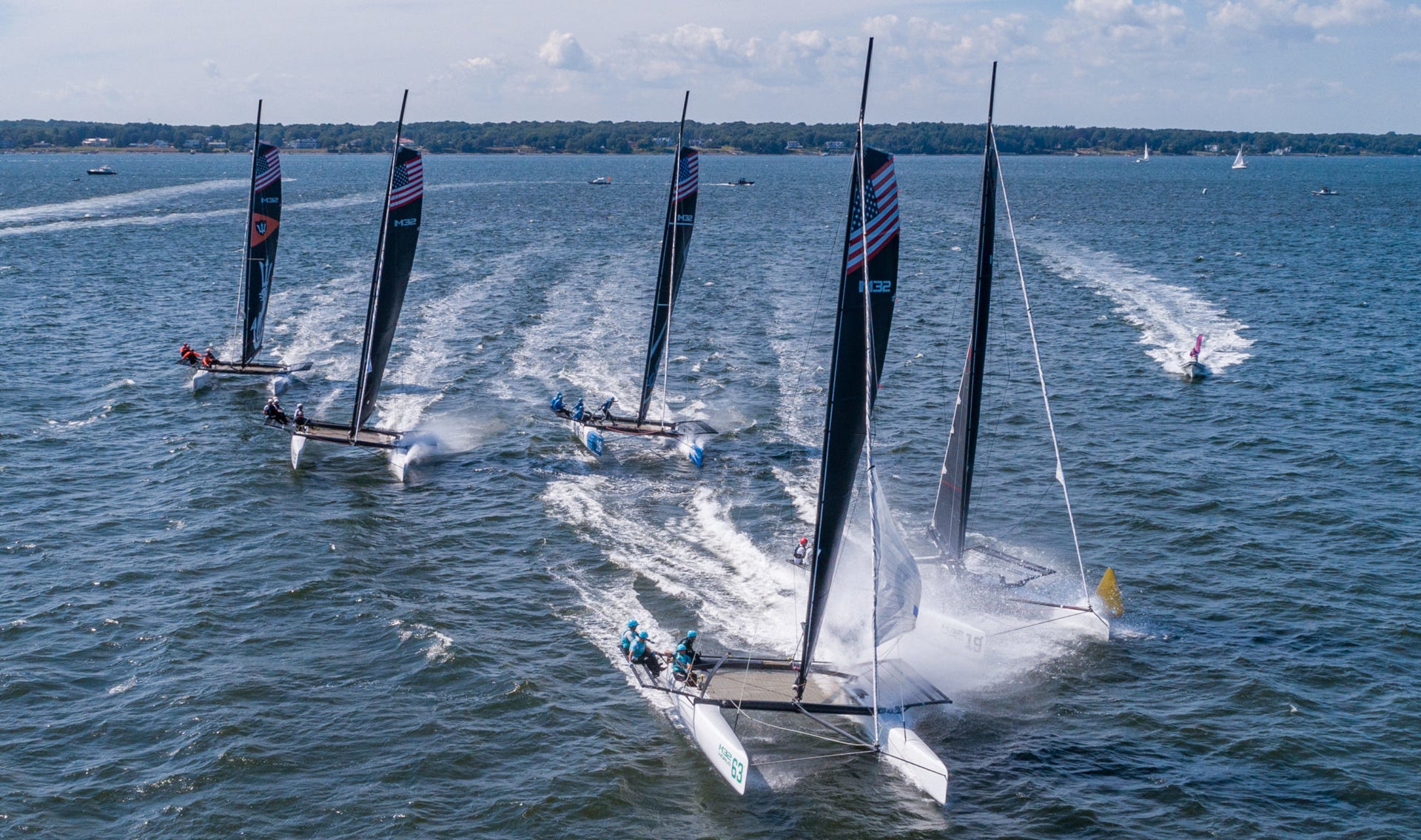
TRAINING UP IN THE M32
TRAINING UP IN THE M32
Closing The Gap
📸 M32 World / Stephen R. Cloutier
In the M32 class, the knowledge gap between pros and amateur racers gets smaller.
In the highly competitive M32 Newport fleet, not one of the high-speed catamarans is sailed by a professional skipper. Instead, the owner-driven class has tapped some of sailing’s household names, including Rome Kirby and Taylor Canfield, to sharpen the skills of the skippers. They have also managed to snag their own pier space behind Midtown Oyster Bar in downtown Newport to serve as a summer base for the North American fleet. Their model has proved excellent for fleet building and kept high-performance racing from feeling unattainable to the average sailor.
“It’s been a blast sailing down at Midtown Sailing Center, down at the pier there.” Says Rome Kirby who sails on Midtown Racing as crew for driver Larry Phillips, “Larry has created a cool little haven in this crazy world we’re living in right now.”
Kirby has a Volvo Ocean Race and two America’s Cups to his resume. When the pro could pick up a ride any given weekend this summer, he chooses to spend his time sailing on the M32.
“Racing the boats within inches of each other at 20+ knots is probably not normal for some guys, but when you’ve got pros on each of the boats you take that fear away.”
📸 M32 World / Stephen R. Cloutier
While the M32s are not foiling, they are high-speed, and the transition from a monohull is not an easy one.
Taylor Canfield is one of the most seasoned M32 sailors in the fleet, racing onboard Convexity, “I think the class kind of started more as a pro-driver class and has slowly migrated into an owner-driver class, which is awesome. I think a lot of people saw the boats as super intimidating, they are high-speed, everyone’s wearing helmets. If you go for a first sail with the right people and trust in your crew, the boats are very safe and they’re built well.”
The fleet boasts an all North inventory of a 3Di main and a Carbon Fiber code zero we have kept the same design for the past 4 years. M32 and the M32 class association has been working closely with North to deliver the most consistent and highest quality product. At the request of the class, the sail shapes are remaining unchanged in 2020 with only changes to ensure increased durability and smoother finishing.
“My immediate impression getting on the boat was just the sheer speed,” says Doug Newhouse. “The boat will accelerate from zero to 20 knots very quickly. The boats only weigh 1300 pounds. They have a huge sailplane.”
Doug Newhouse is no stranger to the sailing scene, but he is the latest team to join the M32 fleet with his boat, Yonder Racing.
“You don’t have a cockpit, you have a trampoline. Literally moving on the boats, there’s a different movement pattern and there’s a different level of physicality to sailing an M32 that you just don’t have on a monohull.”
Newhouse says that any given event in the fleet feels ‘like a pro-am’ with the sharing of knowledge from the high caliber competition on Narragansett Bay.
“The pros on the M32s are at the top of the game, and the drivers are quite skilled but aren’t full-time professionals like these other guys. Having them involved on the boats really gives you the confidence that you actually can sail these kinds of boats.” Newhouse credits Jeremy Wilmot with his M32 education. “Jeremy’s a very, very talented sailor and he is great to go out with, and he’s a lot of fun, but he’s also very strict. My goal with Jeremy is to see how little he can correct me. The better I do the less he has to say.”
📸 M32 World / Stephen R. Cloutier
The fun and physicality are just two of the reasons that the class is attracting new owners and competes at a high level. The M32 class association itself has made entry into the class easy by managing their own races, not relying on a yacht club. The organization of the events is phenomenal, with professional race committees, safety ribs and umpiring on the water means no flags, no yelling, and no wasted time in the protest room.
Ryan McKillen is the owner/driver for team Surge, who made the transition from the J/70 fleet to the M32, they most recently finished second in the Midtown Surf Cup, despite McKillen having only a few years of experience in the sport at all.
“It’s like night and day from the J/70 where you’re pretty much on your own,” says McKillen. “Dave Doucet, Who Is the fleet Manager and Director of M32 North America, really held my hand through the whole thing and they made it super easy to get set up. You get good help from the class at the individual owner level. Most one-design classes set the rules and put the events on, and as an individual owner, you’re not going to get help from the class. It’s not like that with the M32.”
📸 M32 World / Stephen R. Cloutier
The racing itself makes it easy and exciting for teams to get on the water, the races are fast-paced and short, only around 17 minutes. Teams are pushing off the dock around noon, meaning they can log 5 or 6 races before they head in for the day.
Newhouse testifies that it’s hard to have a bad day of M32 racing, “Everybody wants to win. Everybody wants to be on the podium, but the boats themselves are so much fun. And they’re so exhilarating that even if you came in last place, you’re probably going to come in with a smile on your face because you’ve had a good time. You’re just flying across the water and that by itself as special.”
The class has two more events planned in Newport, Rhode Island for September and October.
READ MORE
READ MORE
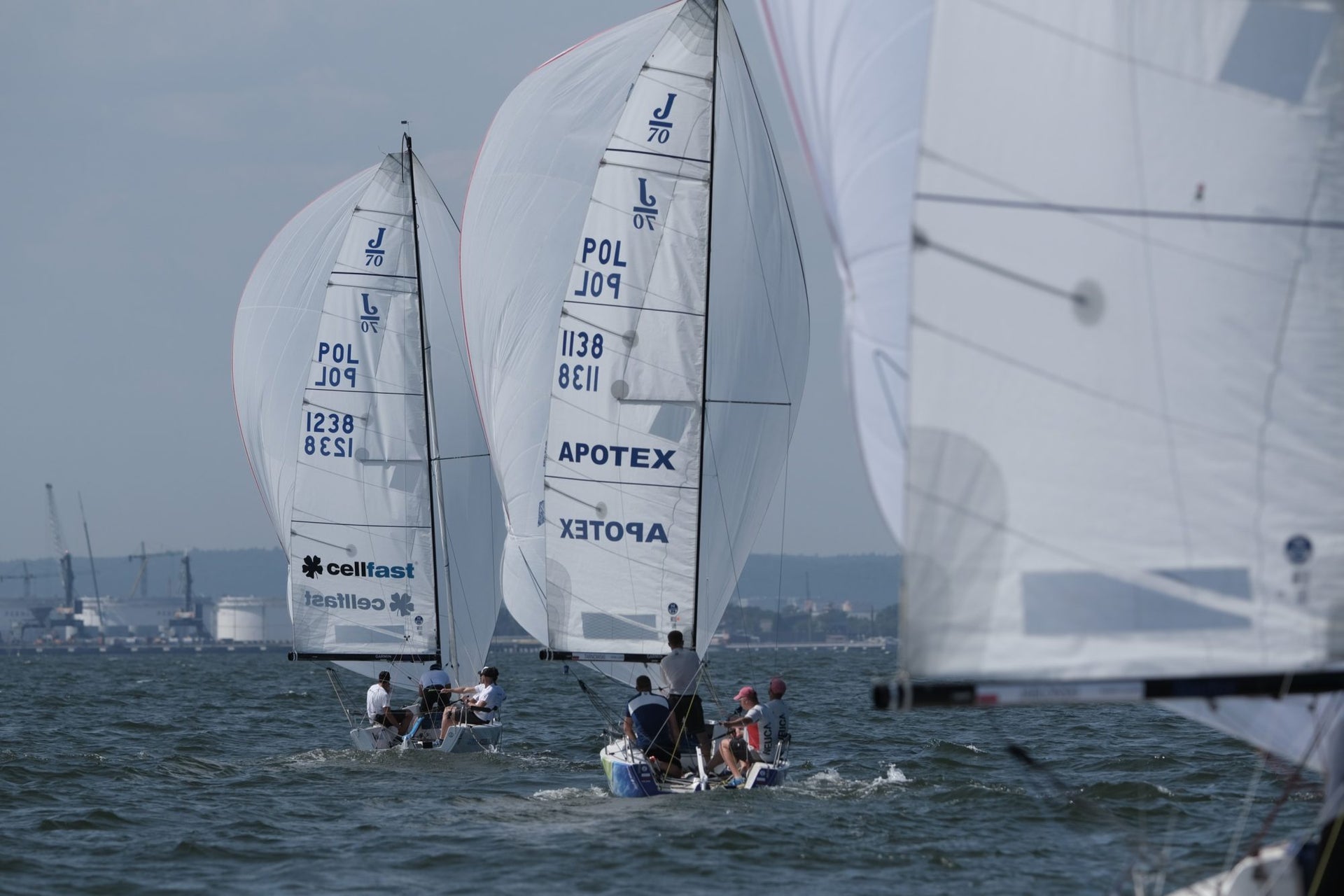
TEAM CELLFAST WYGRYWA MISTRZOSTWA KLASY J/70
TEAM CELLFAST WYGRYWA MISTRZOSTWA KLASY J/70
North Sails wspiera załogi w tej popularnej zagranicą klasie
📸 Jacek Bonecki
Mistrzostwa Miasta Gdańska, które zostały rozegrane w randze Mistrzostw Polskiej Floty klasy J/70 pewnie wygrywa Team Cellfast z Michałem Korneszczukiem za sterem. Drugie miejsce, po zaciętej walce zajmuje zespół GTJ z Michałem Jabłońskim, a trzecie CB Racing ze sternikiem Marcinem Rymerem.
Po udanych zeszłorocznych, pierwszych mistrzostwach załogi polskiej klasy J/70 zdecydowały, aby kontynuować organizację regat w Polsce. W poprzednich latach ekipy te skupiały się na startach zagranicznych – głównie we Włoszech i Niemczech. Dlatego w tym roku zaplanowano dwa starty – pierwszy podczas Lotos Nord Cup Gdańsk – a drugi jako impreza mistrzowska. Niestety nie wszystkim teamom udało się stanąć na linii startu – nasilające się restrykcje koronawirusowe „uziemiły” kilka łódek przebywających zagranicą. Finalnie w ośrodku COSA AZS w Gdańsku – Górkach Zachodnich, który wspólnie z Yacht Club Gdańsk zorganizowały mistrzostwa, pojawiło się pięć zespołów. Nie brakowało jednak wśród utytułowanych żeglarzy. Obok znanych we flocie teamów Neuca oraz GTJ, a także broniącego tytułu Cellfast, flotę zasilił w tym roku SKŻ Powidz z Tomaszem Feretem na czele z załogą w składzie Kacper Kowalski, Michał Szewczuk i Jacek Zalewski. Na starcie stanął również CB Racing, w którego skład wchodzi Marcin Rymer – były kadrowicz klasy 49er, Paweł Kołodziński – olimpijczyk w klasie 49er, Marcin Bużański poprzednio startujący w J/70 jako EonD team oraz Piotr Przybylski – m.in. uczestnik Americas Cup 2007.
Regaty rozpoczęły się w piątek 14 sierpnia od oficjalnego treningu, który poprowadził Paweł Butowski. Jak się okazało piątkowe, bryzowe warunki powtórzyły się również podczas następnych dni rywalizacji. – Bardzo dobrze oglądało mi się trening tej floty. To są świetni zawodnicy i musiałem się mocno skupiać aby wyłapać elementy, które mógłbym zaproponować obszary do poprawy – powiedział Butowski.
Sobotnia rywalizacja rozpoczęła się od krótkiego oczekiwania aż bryza się ustabilizuje. Cały dzień stał pod znakiem północno-wschodniego wiatru o sile 7-12 węzłów. Po godzinie 12 Sędzia Główny – Tomasz Sawukinas rozpoczął procedurę startową. Dzięki temu udał się zapewnić komisję sędziowską wysokiej jakości. Sobotnie rozgrywki kończą się prowadzeniem teamu Cellfast.
Ostatni dzień regat ponownie stał pod znakiem chwilowego oczekiwania na wiatr. Finalnie bryza, która zawitała na akwenie była trochę słabsza i wiatr nie przekraczał 10 węzłów. Zaowocowało to tez mniejszą falą. Te prostsze warunki przełożyły się na mniejsze różnice w prędkości łódek i niejednokrotnie cala flota meldowała się niemal równocześnie na znakach zwrotnych. - Bardzo cieszę się z obrony zeszłorocznego tytułu. Głównie wynika to z tego, że nasz team pływa w bardzo stabilnym składzie i udaje nam się coraz lepiej egzekwować manewry i pilnować prędkości. Podczas tych regat używaliśmy foka J-6, Grota XCS-1 oraz genakera AP1. Żagle te są proste w użyciu i łatwo reagują na zmianę trymu, co pozwala nam na szybkie dostosowanie się do zmiennych warunków. – mówi po zakończeniu Michał Korneszczuk.
📸 Jacek Bonecki
📸 Jacek Bonecki
📸 Jacek Bonecki
📸 Jacek Bonecki
📸 Jacek Bonecki
READ MORE
READ MORE

PRVENSTVO HRVATSKE ZA KLASU LASER RADIAL
Prvenstvo Hrvatske za klasu Laser Radial
Drugo Prvenstvo Hrvatske odjedreno u Splitu prošlog tjedna bio je u organizaciji JK Mornar, a klasa za koju je bilo organizirano je Laser Radial. Ovog puta jedrilo je četrdeset troje jedriličarki i jedriličara iz Hrvatske i susjednih zemalja, a apsolutnu pobjedu odnijela je članica JK Split, Elena Vorobeva.
Jedrilo se uglavnom pored Čiova s tim da u tri dana predviđena za jedrenje nije se uspio napraviti kompletan program. U petak nije bilo vjetra i RO je u 14:45 flotu vratio natrag na kopno. Istina, iza 15 sati je nešto i zapuhalo, ali najvjerojatnije se ne bi uspjelo odjedriti niti jedan plov.
Zato su atmosferske prilike iduća dva dana omogućila ispunjenje maksimalnog programa i na kraju su se rezultati zbrajali na osnovu 6 jedrenja.
U subotu se izašlo na more iza 12 sati i prvi plov se odjedrio po laganom vjetru, dok su iduća dva bila po više nego ugodnim uvjetima s atraktivnim valom i vjetrom do 14-15 čvorova. Nedjelja je bila slična. Također je puhao maestral, ali ovog puta regata je organizirana malo desnije od Sustipana. Prvi plov je započeo na oko 6-7 čvorova, da bi se iduća dva plova jedrila na oko 10 do 12 čvorova.
Unatoč relativno velikoj floti startevi su bili stvarno disciplinirani i jedino je drugi plov startan na Uniform zastavu koja je opet bila kobna samo za jednu jedriličarku iz Pule. Razlog tolikoj disciplini, bar na početku, možda leži u tome što je određeno da su sva PH ove sezone valjana već nakon jednog odjedrenog plova, pa je stvarno svaki start više nego bitan za konačan plasman i sigurno nije potrebno ulaziti u rizik prijestupa već na početku eventa.
Inače, polje koje se jedrilo bilo je klasični štap koji se morao obići dva puta, a cilj je bio definiran s brodom RO-a i bovom ispred njegovog pramca. Do njega se jedrilo nakon prolaska kroz gate.
A evo što je o regati ispričala aktualna prvakinja Hrvatske, Elena Vorobeva:
Uvijek je zadovoljstvo pobijediti regatu, a ovu godinu još je bila prilika pobijediti i u muškoj i u ženskoj konkurenciji ukupno, što sam i ostvarila!
S obzirom da su i muški i ženske jedrili zajedno, bilo je puno zanimljivije nego prošle godine kad se natjecalo odvojeno u ženskoj konkurenciji.
Imali smo dobru flotu od 43 broda što već sliči na ozbiljno natjecanje. Imali smo 6 plovova u 2 dana po uvjetima od 3-5 čvorova promjenjivog maestrala do stabilnih 16 čvorova s valom iz istog smjera.
Htjela bih zahvaliti Regatnom odboru koji je maksimalno iskoristio drugi i treći dan da jedrimo što više i istovremeno nas nisu držali na moru dok nije bilo uvjeta za jedrenje, a nakon dolaska na regatno polje ubrzo bi krenula startna procedura.
Na ovu regatu smo gledali kao dio priprema za naredno Europsko prvenstvo koje bi trebalo održati u 10. mjesecu u Poljskoj i bilo je dobro vidjeti gdje se nalazimo nakon dugih mjeseci rada i treninga u domaćim vodama.
Cijeli naš tim završio je u vrhu liste, pored mog zlata donijeli smo još i 2 brončane medalje u klupsku kasicu zahvaljujući ulaganju mojih sparing partnera, iskusnog Tonija i mladog Lovre. Sve to smo uspjeli uz podršku našeg kluba, pažljivoj pratnji i nadzoru trenera Tonča Antunovića i našeg marljivog rada.
Elena Vorobeva, JK Split
Elena je inače pokazala najstabilnije jedrenje tijekom Prvenstva i ostvarila je 50% pobjeda uz 6. mjesto kao najslabiji rezultat, dok su joj u ukupnoj sumi dva četvrta mjesta bila najveći bodovi. U konačnici, može se reći da joj je pobjedu donio posljednji dan regate kad je bila mnogo bolja od do tada vodećeg, Roka Stipanovića iz YC Croatia.
Roko je fenomenalno otvorio regatu i u subotu se u Mornara vratio s dvije pobjede i jednim trećim mjestom i bio je pobjednik dana. Međutim, u nedjelju je jedrio znatno sporije i najbolji mu je rezultat bio 8. mjesto. Srećom, matematika je bila na njegovoj strani i izvrsna subota mu je u konačnici osigurala drugo mjesto u generalnom poretku i prvo u muškoj konkurenciji.
Brončana medalja u otvorenom dijelu regate je ovog puta otišla u ruke mladog Slovenskog jedriličara Gaspera Strahurnika iz JK Burja. Njegov najbolji rezultat je bilo 2. mjesto u predzadnjem plovu, ali niti jedan od ostalih finiša nije bio ispod 9. mjesta. Tako da mu je konačna suma bila za samo 4 boda veća od Rokove.
Najbliža konkurencija mu je bila u vidu Marka Smolića iz JK Val i Sandre Lulić iz JK Mornar. Njih dvoje su završili regatu na bod razlike i bili su 2, odnosno 3 boda iza Gaspara. Naravno, oboje su izvrsno jedrili da bi mogli ostvariti ovako visok plasman, ali oboje su imali po dva kiksa s plasmanima izvan top deset i to ih je izbacilo iz utrke za medalje.
Kompletne rezultate regate možete pronaći na ovom linku.
Inače, kako pravila dopuštaju, natjecatelji su bili podijeljeni u različite kategorije... U19, U21 i stariji. Najbrojniji su bili u dobnoj skupini U19 s više od 30 imena na toj ljestvici. Naslovi su podijeljeni u svim tim kategorijama i u dodatnim podjelama na jedriličare i jedriličarke, a tko je sve smio biti nazočan na proglašenju pobjednika možete pročitati u nastavku:
OTVORENO PH - GENERALNO Ž
1. Elena Vorobeva - JK Split
2. Sandra Lulić - JK Mornar
3. Ursula Balas - JD Val
PRVENSTVO HRVATSKE - GENERALNO Ž
1. Elena Vorobeva - JK Split
2. Sandra Lulić - JK Mornar
3. Ursula Balas - JD Val
OTVORENO PH - U21 Ž
1. Ursula Balas - JD Val
2. Petra Mastelić - JK Labud
3. Nika Manestar - JD Val
PRVENSTVO HRVATSKE - U21 Ž
1. Ursula Balas - JD Val
2. Petra Mastelić - JK Labud
3. Nika Manestar - JD Val
OTVORENO PH - U19 Ž
1. Ursula Balas - JD Val
2. Petra Mastelić - JK Labud
3. Nika Manestar - JD Val
PRVENSTVO HRVATSKE - U19 Ž
1. Ursula Balas - JD Val
2. Petra Mastelić - JK Labud
3. Nika Manestar - JD Val
OTVORENO PH - GENERALNO M
1. Roko Stipanović - YC Croatia
2. Gasper Strahurnik - JK Burja
3. Marko Smolić - JK Val
PRVENSTVO HRVATSKE - GENERALNO M
1. Roko Stipanović - YC Croatia
2. Marko Smolić - JK Val
3. Toni Bušić - JK Split
OTVORENO PH - U19 M
1. Roko Stipanović - YC Croatia
2. Gasper Strahurnik - JK Burja
3. Matija Reljanović - YC Croatia
PRVENSTVO HRVATSKE - U19 Ž
1. Roko Stipanović - YC Croatia
2. Matija Reljanović - YC Croatia
3. Lovre Bakotić - JK Split
Iduće Prvenstvo Hrvatske je za tjedan dana i u Šibeniku će JK Val okupiti najmlađe od najmlađih, odnosno organizira PH za klasu Optimist U12.
READ MORE
READ MORE
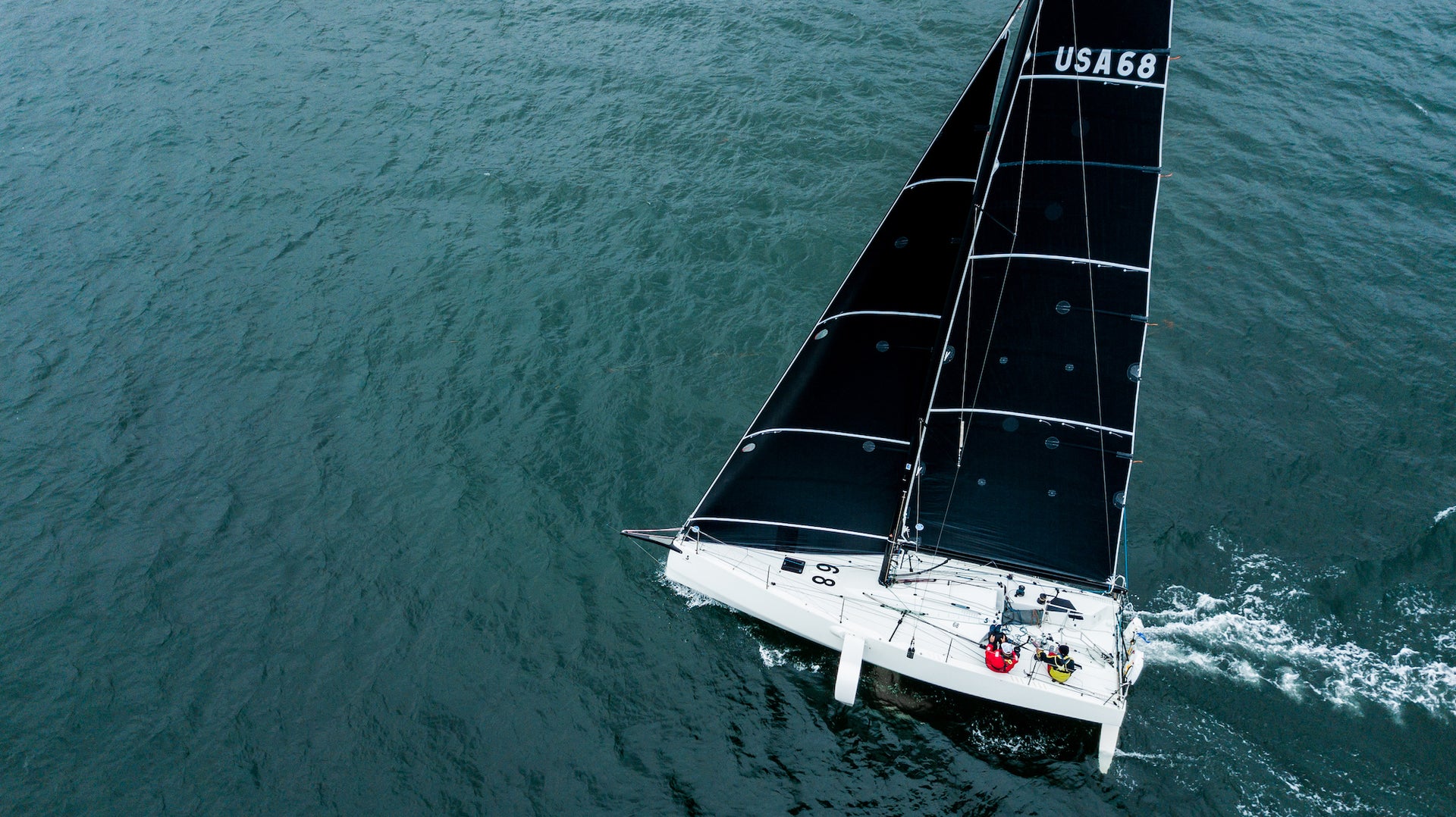
BECOMING A DOUBLEHANDED TEAM
STATE STREET MARATHON SAILING IS BECOMING A TEAM
Gearing Up and Building their Doublehanded Campaign for Paris 2024
By the time most people are making their morning coffee, Jesse Fielding and Francesca Clapcich have logged a 20-mile bike ride with their team. Getting to their goals includes a training regimen on par with any other athlete training for the 2024 Paris games. If they aren’t on their bikes in the morning, they are in the gym where, in addition to workouts, they practice mobility to keep them limber on deck during sail changes and maneuvers.
After they’ve logged their workout, rehydrated, and caffeinated, the pair head to their newly set-up training complex. A space on the Newport, Rhode Island waterfront where a trailer and large industrial building houses various equipment and parts, and a commercial tent is the base for the athletes.
On this particular morning, Clapcich is dealing with an unresponsive wifi router while Fielding runs errands in preparation for the weekend’s Ida Lewis Distance Race. Before lunch, the pair will take a look at weather routing and work with their training partners to devise the best course for the weekend’s racing.
Being an offshore sailor, especially one with Olympic aspirations, means being a multi-faceted competitor. If the team isn’t working out or sailing, they are making sure their sails and equipment are in top shape, studying the conditions, and working on their team dynamic.
“It takes a complete sailor to exist in the doublehanded discipline, right?” Says Fielding, “ And so it’s a big bucket to fill, and you are filling it with all the different little cups of knowledge you can from all the different sectors of the sport as a whole, whether it’s fitness or mechanics of the boat or sailing speed and smarts, et cetera, performance, et cetera. That being said, you can never fill that bucket alone. I really want to highlight the fact that this discipline, specifically in offshore sailing, requires a co-skipper. And that is co and equal in the complete sense of the word. And I think that is an incredible opportunity to showcase the better part of society, which would be a truly equal world, not only between genders but people as a whole.”
There is a certain buzz around the base, the Ida Lewis Distance Race boasts steep competition for the team, high winds, and challenging weather. It will give the team a chance to test their grit and their trust in each other as teammates when no one else is around.
Each session on the water is a chance for Fielding and Clapcich to prepare for whatever Paris 2024 could throw at them. Variety in training is important for the group, to the point where the program invites any seasoned sailors to come down to their base and train against them. It’s an open invitation to grow the discipline and get the best training possible against those who think they have what it takes.
By mid-afternoon, the two Beneteau Figaro 3s are pushing off the dock. There’s a light breeze on Narragansett Bay, nothing compared to what is expected for the weekend’s competition. Instead of an afternoon of sparring with their training counterparts, the goal for this afternoon is to hoist each sail in the team’s inventory and check all of the lines and reef points.
The Figaros are outfitted with North Sails 3Di RAW, sails specifically built for this kind of racing. The durability of 3Di is peace of mind for the team. The sails have been tested for days of racing in the toughest conditions and can withstand heavy loads for extended periods of time.
“It takes a complete sailor to exist in the doublehanded discipline, right? It’s a big bucket to fill, and you are filling it with all the different little cups of knowledge you can from all the different sectors of the sport as a whole”
As Clapcich and Fielding work through their pre-racing checklist, the teammates chatter idly about anything, including what they have been watching on Netflix this week. Their ease with each other is evidence of their commitment to the program’s success.
“We’re a great check and balance on each other.” Says Fielding. “We’re doing this together. We are leaning on each other’s skillsets, and I just think that that’s been a really pleasant part of the experience.”
The idea for the State Street Marathon Sailing platform came from Malcolm Gefter, the team manager.
“It’s always bothered me that in spite of how big the country is and how many sailors there are, the US performance in the games has been less than proportional to its ability based on size and talent. Creativity and innovation is integral. So faced with a new problem, the US should be pretty damn good at getting the answer. Since this is a double hand offshore program that’s new, right?”
He continues with how he recruited Fielding and Clapcich.
“In any other class, when you’re doing any other sailing, you say, ‘Well, who are the best Opti sailors? Who are the best 420 sailors? Who are the best college sailors?’ And it becomes obvious who the best sailors are. We were forced by virtue of the circumstances to say, ‘pick some team or a small number of people that you already know by their reputation are good sailors at the level that is necessary to even think about competitive level.’ Make them the reference standard, and then have everybody come and compare themselves to the reference standard that you use one by one by one rather than supporting a large base.”
When Fielding received the call, he was all in.
“To hear of an opportunity with such foresight and strength behind it and a plan and a place for me in that program, it was a great moment in my sailing timeline and personal timeline. And to have that program be here in Newport, in a startup phase, and get to join that program from early stages. It’s just an amazing opportunity.”
Fielding, who has career ties to North Sails, found offshore sailing through showing up on the dock, and got his break after his application was accepted to sail with the Morning Light program.
“I was passionate about offshore sailing. And I was lucky to have a resume that allowed me to join larger boat teams and go and learn from older sailors that have so much to give. So I still think there’s a huge knowledge transfer dynamic that happens from older sailors that pass down offshore sailing knowledge and experience, and you sort of get that in the situation. You have to be out there with those people to hear the story, see the example in action, and then learn.”
For Clapcich, the opportunity is equally as huge. As a two-time Olympian for Italy (she has since immigrated to the U.S.) and Volvo Ocean Race veteran, she is taking her leadership position at State Street in stride.
“Especially for women in the sport, it’s really hard to get opportunities. I feel more confident. The more you get older and the more you get to experience, it’s good to take on some leadership. And I feel that I’m in that stage of life, personally.” Clapcich continues, “The responsibility is high. You’re in charge of so many things. I want to be a good example where a woman in this sport can actually be in the leadership role.”
The program has a long way to go before 2024, but Fielding and Clapcich are ready to face the competition, they aren’t intimidated.
Francesca speaks up, “everyone is using the French teams as a benchmark, but of course. They sail a lot. They sail a lot offshore, and they sail solo, and they sail doublehanded. They are not unbeatable, the level is very close all around the world. And one little mistake can take you out of the running for the medal.”
After the Ida Lewis Distance Race, Fielding and Clapcich are 180 miles closer to Olympic competition.
READ MORE
READ MORE

EVENT SPOTLIGHT: LEO WARDRUP CAPE CHARLES CUP 2020
EVENT SPOTLIGHT: LEO WARDRUP CAPE CHARLES CUP 2020
Hosted By Broad Bay Sailing Association
When Covid 19 hit in early March, many of the regattas on the Chesapeake bay that we have come to know and love succumbed to postponement and cancellation. One staple on the Southern calendar bay every year the Cape Charles Cup looked like it might endure the same fate. Traditionally, the race involves a race over to Cape Charles on the Eastern shore on Saturday and a race back. This year with a couple of adjustments, Broad Bay was able to host a fun event by having two medium distance races in great wind in the Hampton Roads area.
Saturday brought strong winds of 15-20 knots and rain, but that didn’t stop both the PHRF and Cruising fleets from completing their respective courses. Fleets had individual staggered starts around government marks finishing the courses in blazing time. Fleets included PHRF A,B,C, Multihull, CRCA, Non-spin, Cruising A,B, and C classes. Those who braved the rain were treated to excellent wind and waves to surf to the finish line.
Photo Credit: Donna DeSteph and Charity Gavaza
Sunday brought lighter air to start for the competitors on both race courses. Halfway into the race, a 180 degree wind shift and an increase to 15 knots forced crews to be on top of their sail trim and boat handling. This time, without the rain boats got to enjoy a surf through the finish line just after lunchtime with the rest of the day to enjoy time with their crews.
Some Highlights from North customers included:
Robert Radam, Grey Area, 1st in PHRF A, 1st in PHRF Overall
Ben Carver, Entourage, 1st in Multihull
Bob Archer, Bad Habit, 1st in PHRF B
Pete Hunter, Wairere, 2nd PHRF A 2nd race
Ken Vinson, Popoki Kai, 2nd in Multihull
To learn more about North Sails line of racing, including club racing, see here.
READ MORE
READ MORE

AYC HOSTS FIRST ANNUAL TWO BRIDGE FIASCO
AYC HOSTS FIRST ANNUAL TWO BRIDGE FIASCO
Big Turn Out On The Bay
Charles Kowalyshyn’s “Coalition” rips downwind at the Chesapeake Bay Bridge © Will Keyworth / North Sails
On Sunday August 2nd, Annapolis Yacht Club hosted the first annual “2 Bridge Fiasco.” A “run what ya brung” pursuit style race between the Chesapeake bay bridge and the Severn River bridge with a start line smack in the middle. Boats all shapes, sizes, and even foilers showed up for this unique event. With 133 participants, it was one of the largest regattas of 2020.
There was one restriction for the race. Boats must be sailed either single or double handed. The smallest boats included a foiling windsurfer and waszp, with the bigger boats ranging into the mid 40 footers. Classes included PHRF, PHRF non spin, Portsmouth, Portsmouth multihull, Etchells, Harbor 20, J/22, J/24, J/105, and J/70.
Mary and Geoff Ewenson heading upwind on the “Evil Hiss” in the Viper 640 class © Will Keyworth / North Sails
Typically, this time of year in Annapolis would not have much to offer in terms of wind at 11AM on an August day, but the wind gods cooperated by delivering a 10-15 knot southerly to keep the conditions fresh for all of the shorthanded crews. North customer’s had victories in multiple classes and the results can be found here.
The next big event on the calendar is the Annapolis Nood held over August 28-30. We hope for everyone to sign up for a fun and safe three day regatta. Registration can be found here.
John Loe’s Hornet a J/33 on a kite reach surfing down waves out in the bay © Will Keyworth / North Sails
© Will Keyworth / North Sails
READ MORE
READ MORE
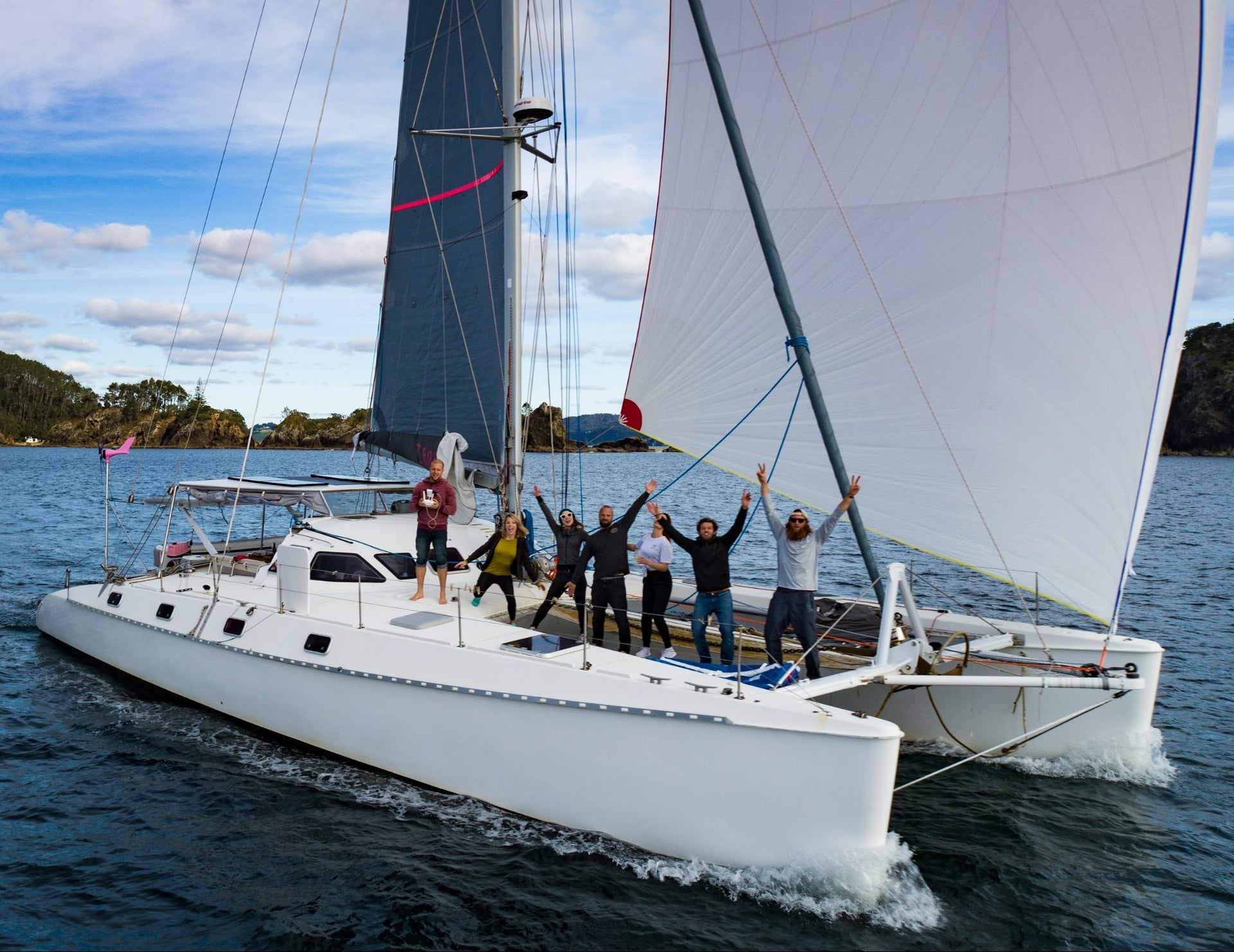
FIRST HOIST ON ZEPHYR
FIRST HOIST ON ZEPHYR
A New Kite Makes All The Difference
Zephyr is an Outremer 55, equipped with a 3Di ENDURANCE square top mainsail, which currently has 7,000 miles on it. She also sports a 3Di OCEAN genoa, and has recently acquired a brand new NPC Downwind masthead asymmetric. Boat owner and captain, Eric Laakman, has worked closely with sail expert Matt Steven in Auckland, New Zealand and San Francisco sail expert Seadon Wijsen to optimize Zephry’s sail plan. He credits both for top notch service and expertise to get him ready to take on offshore distance sailing.
After three months of lying in wait in the sail locker, Zephyr hoisted their brand new, massive 211 sq meter North asymmetric spinnaker for the first time, and were in awe from the moment the kite was made. Eric was eager to see the new kite in action and was beyond satisfied with what he saw after their first hoist.
Winter sailing in New Zealand is on the windy side, which means there’s no real need for light air sails. Every now and then, you’ll get an odd light air day, but even so, conditions rapidly change which in most cases means hoisting your kite is not necessarily the most prudent decision, especially when you’re on the water shorthanded. “For me,” says Eric, “Patience is key, as quick maneuvers while shorthanded are not always easy to pull off.”
“The day of Zephyr’s first hoist, we had the perfect conditions on the Bay of Islands, especially for winter. With 10-12 knots, the breeze was strong enough to keep blowing us back to where we started. Never mind that most on board were a few cocktails deep into the afternoon!”
Since Eric has owned the boat, he’s seen his fair share of spinnakers on the foredeck. “Typically they’d fall into two categories,” he said. “Either they were too small and had a narrow range or they were useful verses simply using the working sails. We’ve also tried used sails before, but they were never quite the right fit for the boat.” Multihulls are made for fast off-wind sailing and Eric appreciates the importance of having the right sails to get the job done. “If you really want to go fast downwind in light conditions on a catamaran that can pull the wind forward, you want your spinnaker to fit just right.”
“Before the sail was cut,” Eric said,” I had a chance to sit down with North sail designers and experts in Auckland, New Zealand. It was great to know exactly what I would be getting, as well as discuss my options for the design. While 1.5 oz nylon was used in the panels that would typically see higher loads, we decided to go with a lighter material, 0.75 oz, for the remaining panels. The goal of this sail was to get Zephyr moving in the lightest of downwind conditions, and the weight savings on the sail would give it a few knots of extra range at the low end. I chose the color white, not just for the classy aesthetics, but also for the best durability given that some of the panels were lighter cloth weight.”
Low and behold, the first launch out of the sock went surprisingly smooth. Without really doing much adjusting or trimming, we immediately hit 8 knots. I set the autopilot to hold a constant angle to the wind at 110 AWA. In 12 knots of true wind, our true sailing angle was 150 degrees –meaning we were pulling the wind forward by a full 40 degrees. I’m used to this on a beam reach with a code zero, but not while using an asymmetric spinnaker. Our VMG downwind was nearly 60% of the TWS. It was unreal! I’m looking forward to experimenting by floating the tack line to get a little more fullness from the luff and more rotation. By doing this, we’ll get even more power out of the sail in the lighter conditions.
“As we awed in the size of the new kite, we mixed up another batch of Dark and Stormy’s, kicked back, and took in the view as we flew past other sailboats that were motoring back into the harbor.”
READ MORE
READ MORE
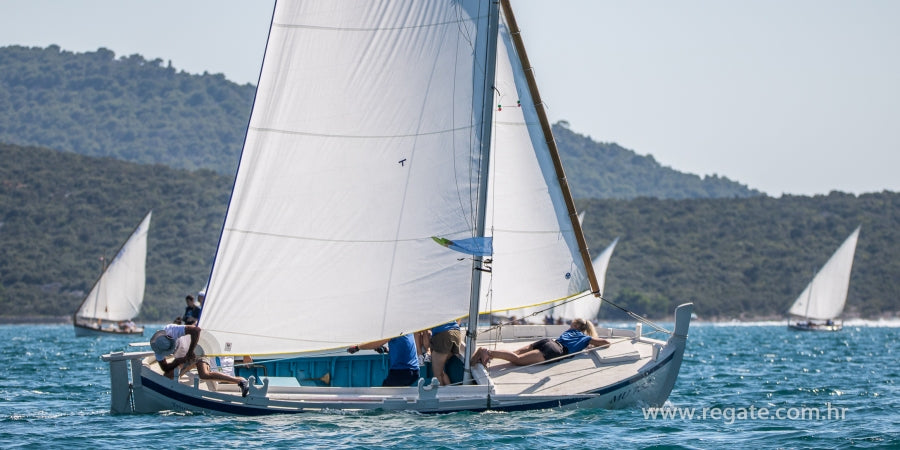
18. REGATA ZA DUŠU I TILO
18. regata za dušu i tilo
18. regata za dušu i tilo odjedrila se u Betini u nedjelju 16. kolovoza. Manje više po već uhodanom receptu, osim što su ovog puta izostale posade iz daljih krajeva, pa su se natjecali uglavnom Betinjani, Murterini, Jezerani i Tišnjani. Jedino "sa strane" bilo je nekoliko barki tradicionalnih jedriličara iz Vodica, Biograda, Prekog i Novigrada.
Ugodno ljetno poslijepodne s laganim i umjerenim maestralom do desetak čvorova prevladavalo je na cijeloj ruti koja je bila identična onoj od prošle godine. Znači, start s Betinske rive, prva bova ispred kampa u Plitkoj vali, zatim natrag i oko rta Rat, pa oko otočića Sustipanac i prema bovi ispred rta Gradina (na ulazu u Murtersku uvalu), te natrag u Betinu u cilj.
Barke su bile kategorizirane na tradicionalni način u gajete, leute i kaiće. Gajeta je kao i uvijek bilo najviše, čak 33! Potom su po brojnosti slijedili kaići kojih se prijavilo sedam, te najmoćniji među njima, četiri velika leuta.
S obzirom da su se svi mogli vezati na rivu start je bio s krmama vezanim na nju, a signaliziran je točno u 15 sati topovskim udarom koji je dobro protresao sve nazočne.
Na startu je bio vrlo ugodan vjetar, ne toliko jak kao godinu ranije, ali svejedno su vodeći vrlo brzo stigli do prve bove. Već od početka, dobar izbor startne pozicije i ozbiljne namjere, favorite su izvukli na čelo flote. Prošlogodišnji pobjednici, gajeta Sirotica bila je na čelu i tako najavila obranu titule. Ostali su bili u blizini, ali sticao se dojam da će pobjeda biti vrlo lagana.
Nakon obilaska ove bove i rta Rat drugi ozbiljni filter je uslijedio na Sustipancu. S obziroz da je vjetar bio ugodan, ljetni povjetarac, sjena ovog otočića stvarala je probleme onima koji nisu uzeli u obzir njegovu visinu i vegetaciju koji su radili sjenu i značajno usporavali. Oni koji su to uzeli u obzir i obišli ga u širem luku mnogo brže su nastavili prema najduljoj dionici regate. Ta dionica je u bila i najotvorenija i jedrila se u orcu, pa su tu najviše do izražaja došle vještine kormilara i kvaliteta jedrilja. Oni manje iskusni su dosta opali s obzirom na idealni kurs, ali ekipa s vrha to sebi nije dozvolila i na jednim uzdama stižu do Gradine nakon koje je slijedio još samo finalni sprint.
Do Gradine je Sirotica još uvijek održavala značajnu prednost, pogotovo jer su im prvi pratitelji, gajeta Trtuša bili nekoliko desetaka metara niže od njih. Na samom okretu ta prednost je izgledala nedostižna, ali nikad ne reci nikad...
Ekipa s Trtuše odlučila se na rizik i jedini mogući način jedrenja koji bi mogao ugroziti Siroticu, a to je jedrenje uz kraj (obalu). Kako je dio obale uz koji se jedrilo načičkan kućama, koje mogu stvarati tu sjenu vjetra, Sirotica se odlučila na sigurnu varijantu i praktički dulju rutu u vidu šireg obilaska Betinske obale. Međutim, svjestan ulazak u rizik posade Trtuše ovog puta se isplatio i u posljednjih nekoliko stotina metara uspijevaju sustići Siroticu, a kako su bili unutarnji pred finalnom virom za ulazak u cilj, a i na desnim uzdama, Sirotica je stavljena u poziciju iz koje nije bilo izlaza...
Što se tiče generalnih rezultata, njih možete pronaći na ovom linku. A što se tiče raspodjele po pojedinim kategorijama, njih možete pročitati preko slijedećih linkova:
gajete 1. - 24.
gajete 25. -34.
leuti
kaići
Po svemu sudeći, prva iduća regata latinskog idra bit će tek na kraju ljeta, na tradicionalnoj završnoj svečanosti u Murteru.
READ MORE
READ MORE

470, FINN & RS:X PRVENSTVO HRVATSKE
470, FINN & RS:X Prvenstvo Hrvatske
FOTO: JK LABUD
JK Labud je sredinom prošlog tjedna, točnije od utorka 11. kolovoza, do četvrtak 13. kolovoza. Odziv je bio dobar, a vrijeme koje je pratilo natjecatelje na moru bilo je vrlo sličnom onom koje je u istom tom akvatoriju vladalo za vrijeme održavanja PH za klasu Optimist. Drugim riječima, pravo ljetno.
U sve tri klase bio je prijavljen po jednoznamenkasti broj sudionika, a najbrojniji su bili daskaši na RS:X.
Surfere je predvodio Luka Mratović, po stažu najiskusniji od njih, a i po postignutim rezultatima u svojoj karijeri jedan od naših najboljih surfera u različitim kategorijama. S njim su na regatnom polju jedrili i momci i djevojke kojima je prosjek godina oko dvadeset, a došli su iz četiri kluba uglavnom iz Splita i bliže okolice. Ukupno su odjedrili 6 jedrenja, a među prijavljenih 9 natjecatelja Luka je apsolutno dominirao i osvojio je sve plovove osim 4. na kojem nije ni startao.
Tim četvrtim plovom, odnosno pobjedom na njemu, može se pohvaliti njegov klupski kolega Bartol Urem. On je na kraju osvojio srebro, a ta pobjeda mu ga je osigurala, jer je imao jednak broj bodova kao još jedna Labudašica, Palma Čargo. Nažalost, Palme nema na fotografiji, već su tu top tri u muškoj kategoriji.
FOTO: JK LABUD
Također šest jedrenja uspješno su odradili i dvosjedi u klasi 470. Od kada su se iz ove klase povukli zlatni olimpijci, posada Fantela - Marenić, u njoj su jedrili uglavnom Labudovi juniori. Međutim, od kad je taj program ukinut za ovu klasu nismo dugo čuli, sve dok se nije pojavila nova generacija juniora. Ti momci i djevojke su upravo u prijelaznim fazama između klase 420 i većih jedrilica, pa tako vidimo da su neki od njih zajedrili na 470, a dok neke od njih viđamo i u klasi 49erFX.
U ovoj floti jedrilo je šest posada i jedrenja su bila dosta izjednačenija u usporedbi s RS:X. Čak četiri posade se mogu pobijediti s pobjedama u pojedinim jedrenjima, a jedino je Uskokovcima Puleku i Lokasu to uspjelo za rukom tri puta. Naravno, njih dvojica su se ovjenčali naslovom najboljih.
Na drugu stepenicu su se popeli Mistral i Iris Matulja iz Lovranskog JK Istra. Kod njih su dominirala druga mjesta, za razliku od isključivo ženske posade Petešić - Bašić iz JK Uskok, a koje su zauzele treće mjesto i kod kojih su u većini bila treća mjesta.
Kompletne rezultate klase 470 možete pronaći ovdje.
FOTO: JK LABUD
A što se tiče kraljevske klase, klase Finn, na njihovom Prvenstvu Hrvatske okupilo se šest kormilara iz četiri kluba, a najzanimljivije je bilo u samom vrhu, odnosno u borbi za pojedinu od stepenica postolja. Dva Labudova predstavnika i jedan jedriličar Šibenskog JK Val bili su glavni režiseri raspleta ove skupine.
Kod njih se može primijetiti zanimljiv razvoj njihove forme tijekom regate. Pobjednik i prvak za 2020. je Josip Olujić - JK Labud i u pet odjedrenih plovova jedini kiksevi su mu bili dva druga mjesta. U stvari kod njega nije bilo uzleta i padova i uglavnom je pokazao stabilnost od početka do kraja. S druge strane, kolega mu iz kluba, Nenad Bugarin, na kraju brončani, otvorio je regatu pobjedom i drugim mjestom, ali do kraja osvaja isključivo treća mjesta.
Zato je Milan Vujasinović - JK Val, nakon što se "tražio" u prva dva plova, nastavio vrlo dobro jedriti i suci mu upisuju druga mjesta i pobjedu u posljednjem plovu. Tko zna, možda bi rezultat bio i malo drugačiji da su Dugi i Neno jedrili na svojim jedrilicama. Naime, oba su jedrila na posuđenim brodovima i s posuđenom opremom jer je jednom sve to u Španjolskoj, a drugom na Palmi. A evo što je o regati rekao novi prvak Hrvatske:
Ne mogu se sjetiti kad je bilo posljednje PH za Finn, tako da mislim da je vrlo lijepo da smo se ponovno uspjeli okupiti u dovoljnom broju unatoč tomu što smo nas prva trojica dosta aktivniji i s puno većim iskustvom i značajno smo se izdvajali od preostale trojice.
Za razliku od ostalih ja sam imao prednost jedrenja na svom brodu, jer su njih dvojica trenutno locirani u Španjolskoj i na Palmi i tamo im je ostala sva oprema. Tako da su obojica jedrili u posuđenim brodovima i to im je vjerojatno bio hendikep u određenim uvjetima. Sve u svemu mislim da sam dobro jedrio, ali mislim da je prevagu odnijelo to što sam poentirao u uvjetima s više vjetra.
Početak i sredinu regate sam odjedrio vrlo dobro i osigurao titulu, tako da sam mogao opušteno ući u posljednji plov u kojem sam onda mogao pustiti da njih dvojica imaju svoju borbu u koju se ja više ne moram uplitati.
Uglavnom, nismo odjedrili puni program, ali mislim da su svejedno ovih pet odjedrenih bile dovoljno kvalitetne i zanimljive.
Josip Olujić, JK Labud
Njihove kompletne rezultate možete pronaći na ovom linku.
FOTO: JK LABUD
Inače, što se tiče vremenskih uvjeta na regatnom polju o tome je par riječi ispričao predsjednik Regatnog odbora g.Jozo Višić:
U utorak smo izašli na Čiovo tek oko 14:30. Do tada nije bilo vjetra. Onda je naglo stiglo 10-12 čvorova koji su omogućili da se započne druga orca za vrijeme koje sam morao prekinuti regatu.
Jedino su daske uspjele završiti taj plov, jer je njihova orca bila na otprilike pola duljine orce druge dvije klase. Tako da su oni svoju regatu završili za 15-20 minuta. Oni su na kraju tu regatu završili pumpanjem, a to im je bila već druga za prvi dan Prvenstva.
U srijedu je počelo puhati već oko podne i pol i krenuli smo s jedrenjem oko 13 sati. Tog dana smo napravili tri regate za 470, dvije za klasu Finn kojima smo započeli i treći plov kojeg sam morao prekinuti.
Vjetar je počeo padati i okrenulo je naglo u buru, pa su i "štiriji" zadnju mezzonavu u stvari vozili u orcu. Kako im se redoslijed nije mogao promijeniti ostavili smo ih, ali Finnovima smo morali prekinuti. A daske su napravile samo dva plova, oni su na regatno polje došli malo kasnije...
I trećeg dana regate, u četvrtak, napravili smo po tri plova za 470 i Finn, dok su daskaši odjedrili dva plova.
Inače sva ta jedrenja smo napravili po maestralima iz 240 do 260°. Kao što sam rekao, najlošije je bilo prvog dana kad je maestral stigao kasno i puhao samo sat - sat i pol. Zato je drugih dana dolazio ranije i bio dovoljne snage cijelo vrijeme.
Jozo Višić, predsjednik RO
Ova regata je bila na neki način i dobar sparing test za naše Finnaše pred kojima je Europsko prvenstvo u Poljskoj na početku mjeseca rujna. Po trenutnim prijavama neće biti najveća moguća konkurencija od uobičajenih 60 i više sudionika, jer ih je trenutno prijavljeno oko 40.
Po programu jedrenja će biti od 2. do 6. rujna, a tri dana prije jedrenja bit će organizirana premjeravanja.
Što se tiče samog jedrenja, format je promijenjen i neće biti medal racea i finalnog plova, već je predviđeno da se u tih pet dana jedri po dva plova svaki dan.
Prije Europskog prvenstva bit će organizirano i Prvenstvo Poljske za klasu Finn, tako da će naši jedriličari tu regatu nastojat iskorisititi kao posljednju ozbiljnu pripremu nakon vrlo duge pauze bez regata i ozbiljnih sparinga.
READ MORE
READ MORE
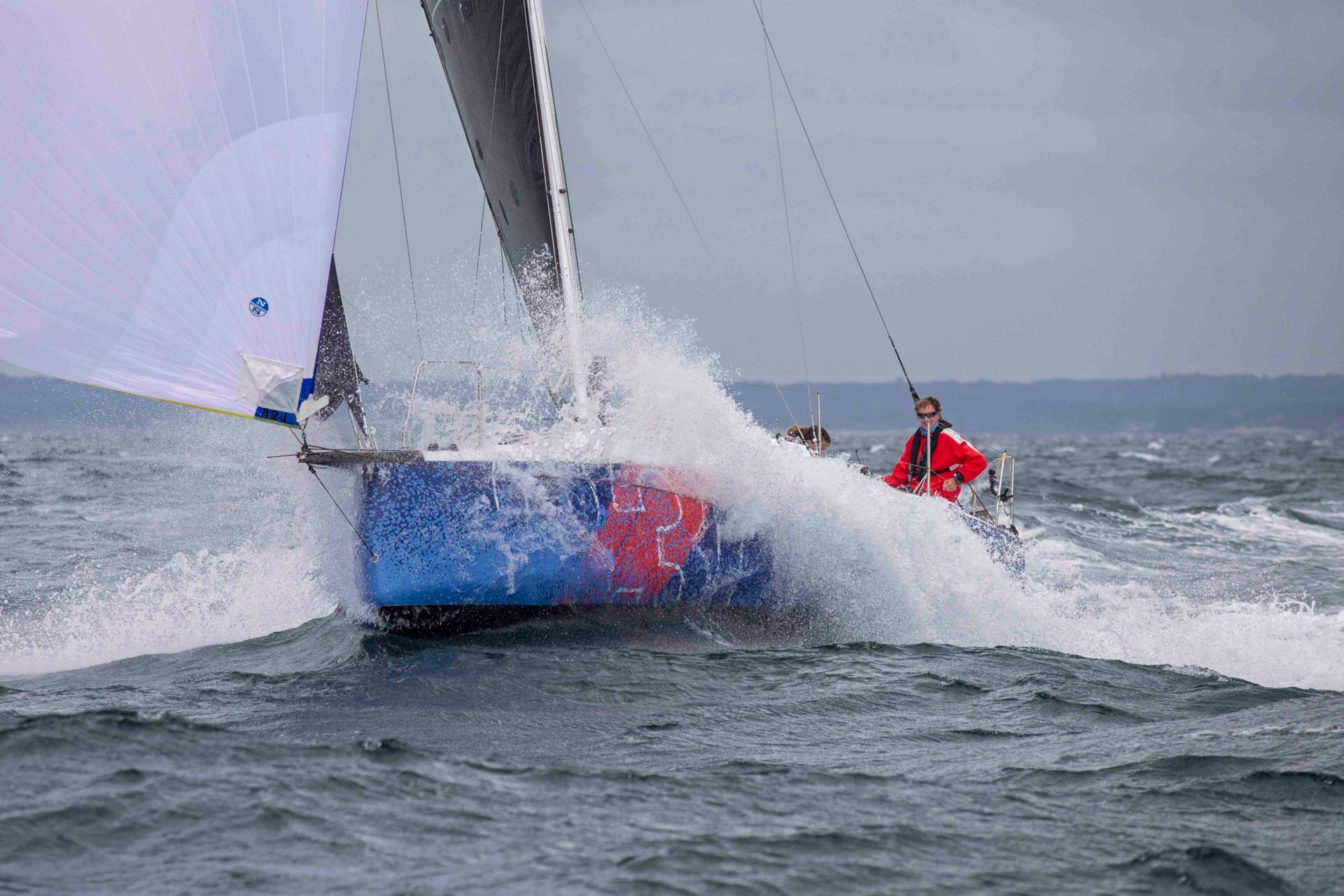
DOUBLEHANDED DEBRIEF LIVE WITH KEN READ
YOU’RE INVITED: DOUBLEHANDED DEBRIEF
Join North Sails President Ken Read and Special Guests on Monday, August 24th Live on Zoom
📸 Billy Black
Diving headfirst into a new style of sailing has made for an exciting and competitive summer for North Sails President Ken Read. Join Ken live with special guests Suzy Leech and Brad Read as they debrief their recent of doublehanded sailing experiences.
Ken’s year of doublehanded sailing kicked-off in February, a few weeks before we knew close-to-home, short-handed sailing would be so popular this summer. Luckily for Ken, talented crew and world-class competition are never hard to find in Newport, Rhode Island. Inspired by the growing doublehanded trend, Ken has been alternating races with his brother Brad and Suzy Leech. They’ve been getting to know their boat Alchemist, a Jeanneau Sunfast 3300, and bonding as teammates. Putting in their miles on the Sunfast has brought them several successes. Alchemist has won on handicap in all three races entered and took line honors in the New England Twin/Solo.
Monday, August 24th, 1500 EDT
Keeping It Simple | Mistakes & Recovery | Choosing Your Teammate
Register Now
Please submit any questions in advance to webinars@northsails.com or ask live via the Zoom chat. We look forward to having you join us!
READ MORE
READ MORE
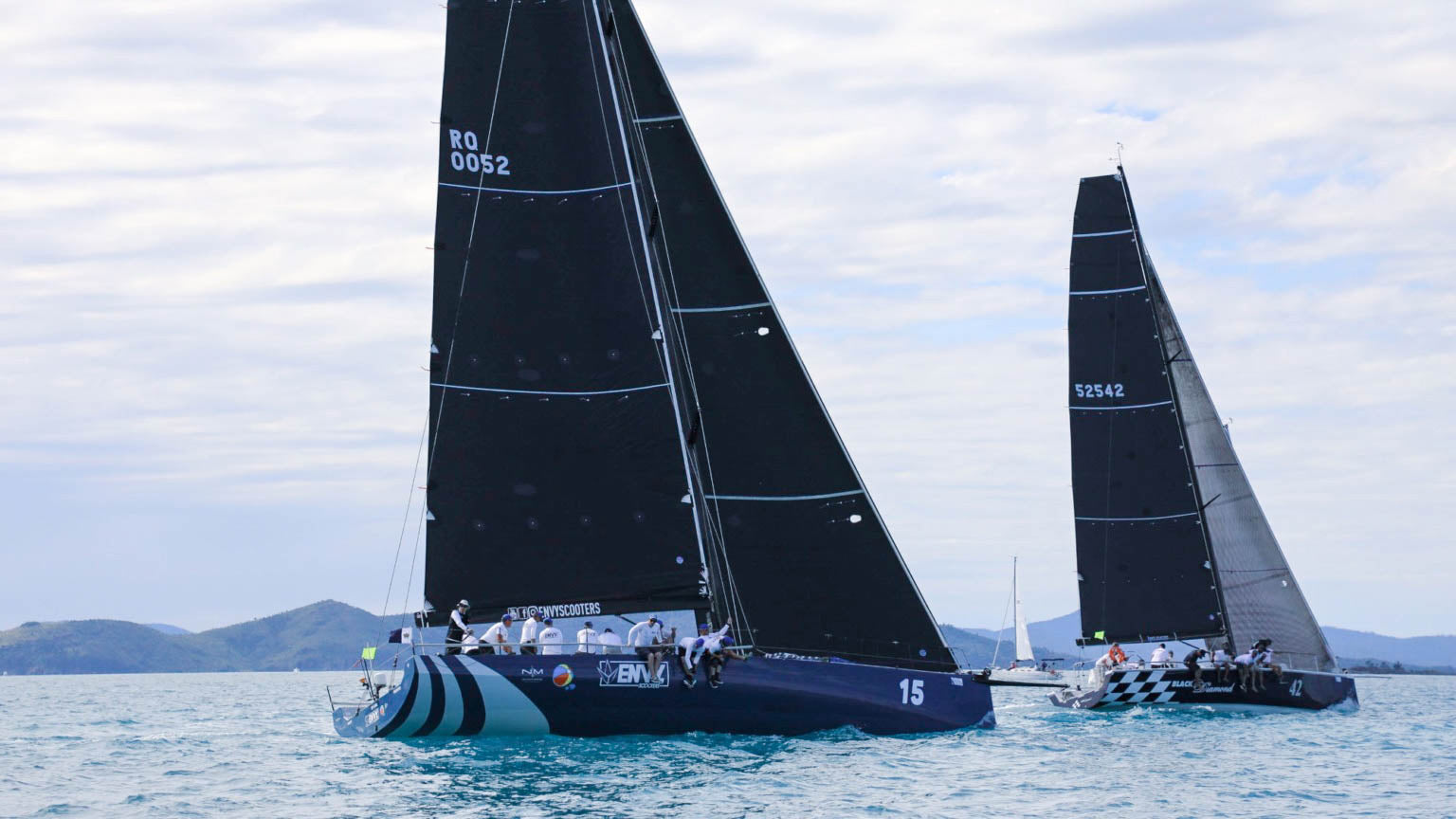
AIRLIE BEACH RACE WEEK
AIRLIE BEACH RACE WEEK 2020
North Sails Australia’s Josh Torpy and Ben Kelly Share Race Reflections
📸 Shirley Wodson Photography
Airlie served up challenging light air racing for the week-long event. In the IRC passage fleet, racing was very close between Team Hollywood, Mr Bojangles, Desperado, Black Diamond and Envy Scooters making it exciting and a great test of crew work. Team Hollywood, with a full North inventory, was quick out of the blocks– just as expected in the lighter breeze conditions. Black Diamond was hot on their heels, pushing them on the IRC rating every chance they got but Team Hollywood was ahead of the game, coming out on top of the scoresheet, followed by Envy Scooters, and Desperado to round out the podium.
📸 Shirley Wodson Photography
North Sails Brisbane's Josh Torpy was onboard Envy Scooters, and used Airlie Beach RW as their practice event for the Annual Sydney Hobart which takes place later this summer. “We were fortunate enough to have some great crew that we normally don’t have access to, especially given the Covid pandemic,” said Josh. “Having a top-notch crew gave us the upper hand, and that allowed us to truly get the most of the week-long event to work on crew fine tuning and boat speed.” Using the week to fine tune, the team took many positives away which will help them get up to speed with their normal crew. Josh commented; “This year's event saw many smiling faces, as sailors were happy to be back on the water, back to doing what they love most. All and all the whole fleet had a great week in what we all felt very lucky and privileged to participate in a great regatta in the Whitsundays given the current situation.”
📸 Shirley Wodson Photography
North Sail Expert Ben Kelly also shared excitement for a successful race week onboard Black Diamond. “It was refreshing to be surrounded by such a strong team of younger sailors that are moving up into larger keel boat racing,” he remarked. “This was the first race for the new owner, and to experience the tight IRC racing amongst a wide range of boats made for the perfect ice breaker.” The Black Diamond crew is gaining traction and was able to ramp up their performance by focusing on crew work and boat handling. Ben commented: “For our first race together, we are very happy with our result. Our 3Di RAW 780 mainsail was our secret weapon in the light air conditions, and the boat was in great condition, prepared by Lee Randall and North Sails associates to get her up to top speed.” Overall North Sails was heavily represented across all fleets at the event, I paid particular attention to the Multihull Divisions, with a new A2 giving the Cut Snake owned by Robert Dean a new deeper downwind mode that clearly improved their week in the light conditions.
📸 Shirley Wodson Photography
Troy Forest’s Grainger Mint was quite impressive all week, with a beautiful 3Di square top mainsail and headsail. “They used their massive Code 55 upwind and did very well in the ultra-light conditions,” said Ben. “We recently supplied Mick Hayes aboard the Schionning Catamaran Renaissance with a new carbon paneled main that had an increased head width and a more refined roach. From the looks of it, they had her dialed in at this event.” The Orma 60 Trimaran ex-Vodaphone won the regatta using a full wardrobe of North Sails. All sailors felt genuinely fortunate to be attending a regatta in such amazing waters and perfect weather. Ben commented; “I am sure next year’s Airlie Beach Race Week will smash all records for attendance as the beautiful images going out on social media have made all missing this years event very jealous!”
📸 Shirley Wodson Photography
READ MORE
READ MORE
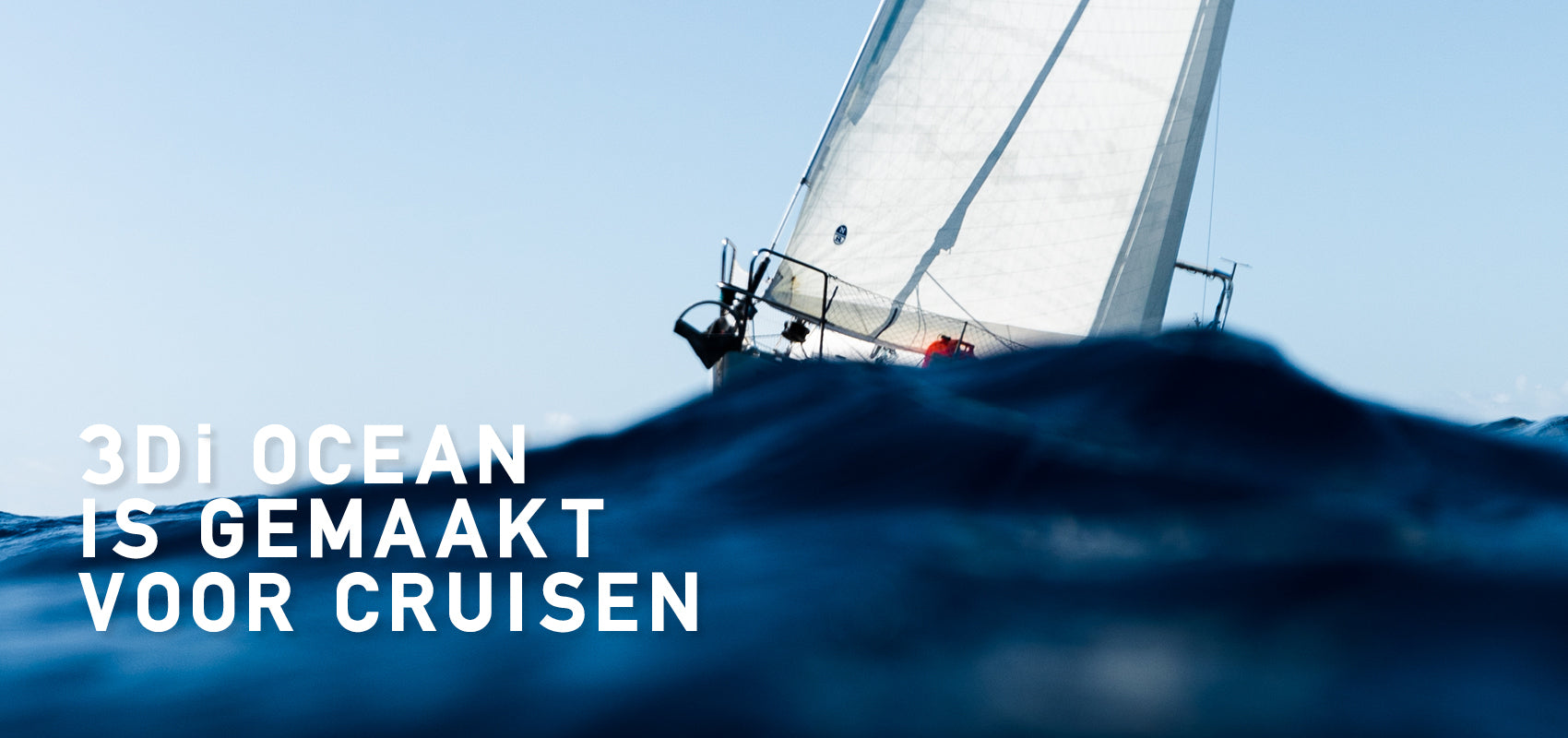
3Di OCEAN: ALLES WAT U WILT WETEN
3DI OCEAN: ALLES WAT U WILT WETEN
Kom alles te weten over onze nieuwe 3Di OCEAN productgroep met onze Q&A
V: Wat is 3Di OCCEAN?
A: 3Di OCEAN is de nieuwste groep binnen North's 3Di productljn, exclusief ontworpen en ontwikkeld voor cruisen
V: Is 3Di OCEAN het goede product voor mijn boottype en gebruik?
A: 3Di OCEAN is geschikt wanneer u op zoek bent naar een sterk en duurzaam premium cruise zeil met alle voordelen die 3Di zeilmaken biedt.
V: Wat is anders en beter aan 3Di zeilmaken?
3Di is North Sails gepatenteerde manier van composiet zeilen maken op een 3D mal. Om 3Di zeilen te maken worden individuele filament tapes geprint in precieze tape vectoren(lengte en richting) en dichtheden. Dit membraam wordt vervolgens versterkt door hitte en een thermoset hars toe te voegen op een 3D mal op de ware grootte en uiteindelijke vorm van het zeil. 3Di resulteed in een sterk, strak en precies gevormd zeil. 3Di results in strong, smooth, and precisely shaped sails. https://youtu.be/OCFEYvqXDus
V: Wat is anders aan 3Di OCEAN ten opzichte van andere 3Di Productgroepen?
A: 3Di OCEAN zeilen zijn geoptimaliseerd voor cruisen en daardoor robuust en duurzaam., terwijl 3Di RAW zeilen ontwikkeld zijn voor extreem weinig rek en lichtgewichte wedstrijd performance. 3Di ENDURANCE zeilen zijn geschikt voor zowel cruisen en racen door de balans tussen vormvastheid en extra toegevoegde duurzaamheid.
V: Welk 3Di OCEAN zeil is het juiste zeil voor mij?
A: 3Di OCEAN is beschikbaar in 3 verschillende stijlen om allerlei bootgroottes te kunnen voorzien.
OCEAN 330 is 100% NORDAC Polyester en geschikt voor cruise boten van 25 tot 45 voet.
OCEAN 370 is voor boten groter dan 35 voet, inclusief multihulls, waar door de grootte een mix van Ultra PE en 3Di NORDAC gewenst is voor sterkere zeilen en minder rek.
OCEAN 700 is speciaal ontwikkeld voor schepen groter dan 50 voet met een high modulus mix van UltraPE en aramide.
V: Hoe lang maakt North al 3Di cruise zeilen?
A: 3Di technologie bestaat al meer dan 10 jaar, en 3Di zeilen worden op duizenden boten gebruikt en hebben al meerdere miljoenen mijlen gevaren.
V: Wat zijn de specifieke voordelen van 3Di OCEAN zeilen?
A: 3Di OCEAN heeft zijn duurzaamheid als grootste voordeel. 3Di NORDAC Polyester en UltraPE vezels zijn beter bestand tegen UV en flex dan elk andere vezel die gebruikt wordt voor aandewindse zeilen. Door de composiet constructie met thermoset hars hoeft er geen mylar film gebruikt te worden, waardoor het zeil niet kan delamineren zoals laminaat- en string zeilen. 3Di OCEAN heeft een speciale buitenlaagtape die bescherming biedt tegen schuren en schavielen. Dit maakt het zeil uitermate geschikt voor in-mast of in-boom rolgrootzeilen.
V: Zijn 3Di OCEAN zeilen geschikt voor wedstrijdzeilen?
A: Niet zo goed als een ENDURANCE of RAW zeil! OCEAN is ontwikkeld als wedstrijdzeil, maar uiteraard kunt u prima een clubwedstrijd of toertocht met 3Di OCEAN zeilen varen. Wanneer u echt op zoek bent naar een zeil voor cruisen en wedstrijdzeilen is 3Di ENDURANCE wellicht een betere optie. En 3Di RAW is natuurlijk het ultieme wedstrijdzeil.
V: Hoe zit het met andere materialen? Maakt North nog steeds cross cut cruise zeilen?
A: Jazeker. North maakt nog steeds crosscut en radiale zeilen. NPC Cross-Cut zeilen worden gemaakt van traditioneel geweven polyester. NPL Tour zeieln worden gemaakt van gepatenteerd gelamineerd zeildoek voor specifieke toepassingen en prijsniveaus. Binnen uw wensen en verwachtingen hebben wij zeker een North cruise zeil dat geschikt is voor u.
ONTDEK MATERIALEN VIND UW LOFT VRAAG EEN OFFERTE AAN
READ MORE
READ MORE
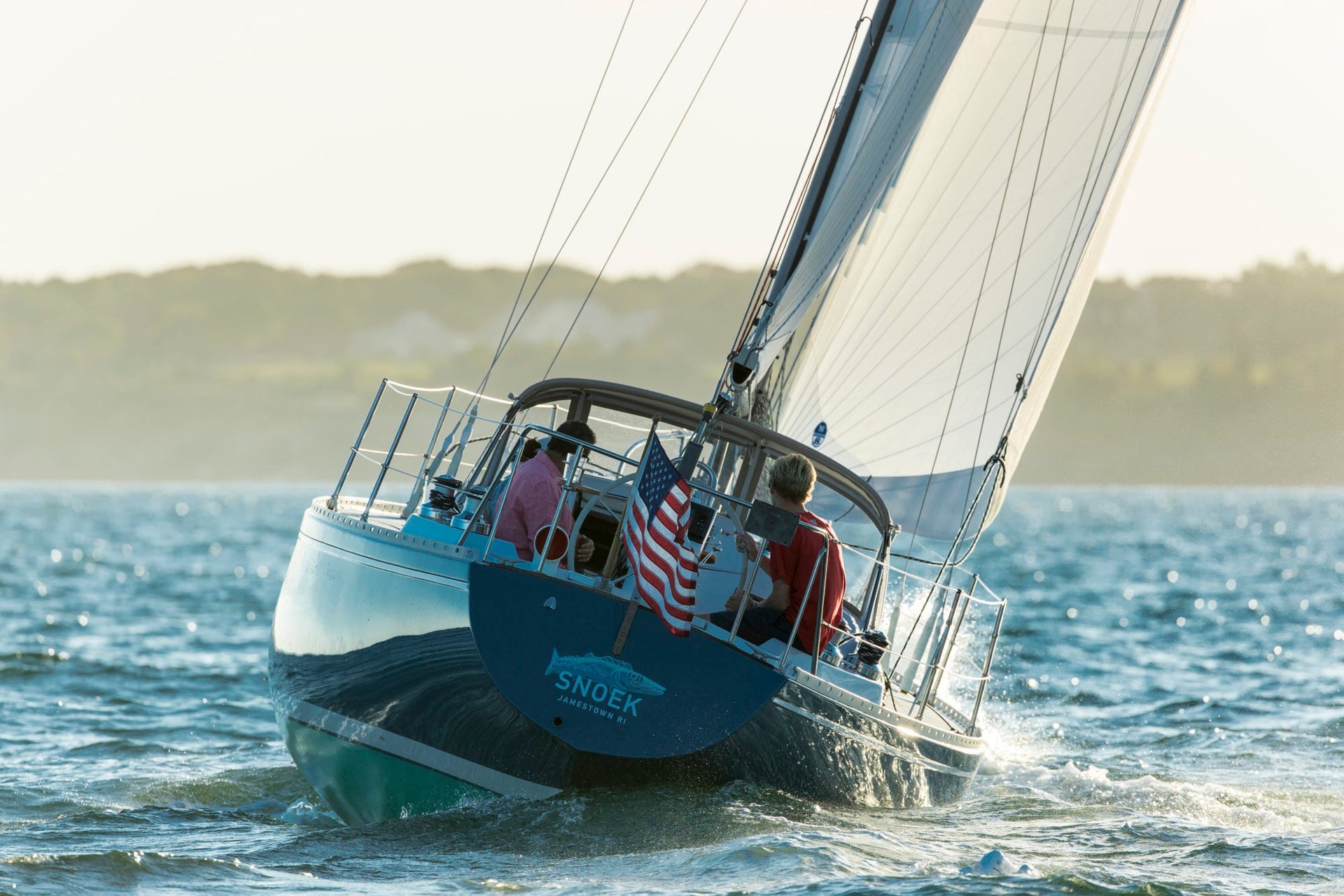
Q&A WITH ONNE VAN DER WAL
Q & A WITH ONNE VAN DER WAL
A North powered restoration project. Onne Van der Wal’s Snoek wasn’t always the cruising gem she is today.
Onne Van der Wal’s Pearson 36 didn’t always shine as she does now. Before she was Snoek, she was tired and tangled on her mooring in Newport Harbor. Now, she’s a gem of the New England cruising scene, but it took months of hard work and grit to get her up to speed. Onne’s PBS documentary chronicling the restoration of Snoek is now airing in select cities, so we caught up with the famous yachting photographer and cruiser to learn about his experience and how he upgraded his performance with new North Sails.
North Sails: Why did you choose to work with North Sails?
Onne: I was doing an early morning photo shoot over at Dutch Harbor, and I hear a bicycle come down behind me and it stops, and it’s Dan Neri, CEO of North Sails Group. I said, “I was going to give you a shout. I’m rebuilding an old Pearson, and I wanted to talk to you about working with me on it.” And he said, “Deal. Count me in ” And that was literally the conversation. Well, from Dan that’s a lot. And that’s all I needed to hear– the confirmation and the thumbs up.
And so I got back in touch with him, and arranged a sail with Dan and cruising expert Bill Fortenberry. We sailed around the bay and they measured everything and looked at every detail, and took pictures. Dan got very involved in the design process. With the old sails, the boat had a lot of weather helm, and I told Dan this. The sails were too deep, and the main– there was just too much power. So, they got me set up with a brand new set of Radian sails.
Everything arrived during the winter, all boxed up from Sri Lanka. We laid them out on the lawn and had a look, and it was ‘oohs and aahs.’ When the boat was finished and put in the water, it was just Bill and me, and my daughter to test them out. The three of us hoisted the sails and immediately noticed that the new main was a lot flatter. And even then if you put a reef in, oh my goodness, it’s even flatter– it’s just great. They fit beautifully. And we went sailing and we were all pretty psyched.
North Sails: What made you choose Radian sails?
Onne: I just think that the weight of the cloth is so manageable. I sail with my wife and my wife’s not a huge sailor, so she normally stays in the cockpit. I have a stack pack with lazy jacks to store the main. The fabric is pliable enough that I can just drop the halyard and the sail, and it literally falls all the way down into the bag onto the boom. From there, I can just pull the leech a little bit aft, and it flakes nicely into the bag. It is just such a big advantage to have that nice, soft pliable workable fabric. Yet when we’re sailing with that main up, and we’re hard on the wind, in let’s say 17-18 knots of breeze–I mean the main looks beautiful.
My headsail is a 135%, and has a nice high clew and a foam luff. We were coming back from the vineyard the other day in a southwesterly, and it was a fetch home. So we cracked off, but not tons, and with a nice high clew like that, the bow stayed above the waves. When we had furled the sail a bit to minimize the sail area, it looked nice and was perfect for shorthanded cruising sailing. Just perfect.
The red and white gennaker that we have, it’s just so easy to fly. I do it on my own. I just tack it down on the bow and pull it out. I preset the sheets and can hoist from the bucket bag right there. he launching tube with a bucket and a nylon tube, I just hoist away. and bingo. As soon as I’m ready to let it go, I just make sure it’s a little bit in the lee of the main, and I trim on the sheet a bit. I pull the bucket down and I lash the bucket to the deck, and then when I’m ready I drop the halyard, it’s easy. That’s how cruising should be. Nice and easy, and no stress.
North Sails: Tell us about choosing Radian over something sporty like 3Di?
Onne: Some members of my family gave me a hard time for not going with 3Di and all that kind of stuff. And I said, “I am a cruiser who prefers to use traditional sail materials. I take them off the boat and fold them up. I like traditional materials like Dacron too when it comes to trimming. For me, they are easy to handle, hoist, and trim.
North Sails: What was the best part of the new sail process?
Onne: I’m very happy with the service I received. Having gone for that first sail with the old sails, and how extensively the Dan and Bill measured everything, looked at everything, and checked where the leads were ideally placed made the entire experience worthwhile. When the sails arrived, nothing needed to go back to the loft. It was bingo– out of the bag it fit, and when I trimmed it on and cranked the halyard, it looked good.
North Sails: What is the best trip you’ve ever taken onboard Snoek?
Onne: We did a trip two years ago and we sailed to Block and from Block, we sailed down to Shelter Island. We sailed in about 20 to 25 knots easterly, so it was DDW. We deployed our full jib and a full main. And I have a nice carbon pole on the boat, so I ended up pulling out the headsail. And we just made super good time and surged up to about nine and a half knots. For an old heavy cruising boat from 1972, to do nine knots was pretty remarkable with the three of us on the boat. When we got to Shelter Island, we poked around and then we sailed across to Stonington, CT. We tacked up the coast from Stonington to Watch Hill, RI in a northerly, and had a beautiful and fast beam reach all the way along the south shore of Rhode Island. As we got to Watch Hill, the wind shifted the west. So as you can imagine, we’ve got a beam reach to Point Judith. The wind clocked around to the west and we had another reach up Narragansett Bay, all the way home.
My wife said to me, “You know, this sailing stuff is pretty comfortable and easy.” I think that trip from Block to Shelter Island to Stonington and back just epitomized perfect sailing, and having the right breeze and the right sails– it was just so comfortable and so fast. We’ve had a lot of nice sails on the boat, but these stand out the most.
North Sails: Any behind the scenes you can share with us on the PBS documentary?
Onne: North Sails President Ken Read said in a documentary, “What is Onne tackling? I mean, that’s so much work.” And yeah, it was. It was a long winter spent restoring Snoek. I enjoy working with my hands, and I’m fortunate that I went to trade school to learn how to do boat work. But more than that, it was a very rewarding project to grab an old boat from 1972 that was borderline dump material. It could have so easily gone the other way, where somebody said, “This boat, it’s done, it’s not worth anything. We should just scrap it.”
In February when it was dark and cold, I thought “What the hell am I doing?” But I just knew what I was heading for and what I could do with it once it was completed. We’ve had some amazing experiences. Everywhere we go, I always take my camera, and early in the morning or late in the day, I end up mostly going for a sail on my own or with one of my family members, and we go and take some nice pictures of where we are.we’ll take a rod with us sometimes and fish a bit too.
For my photography, I’ve been able to grab some really nice images of New England, Shelter Island and Nantucket, and everything in between. One thing, when you go and do an assignment and you stay ashore in a B&B or a little hotel, you’re a little stuck and then you’ve got to get a ride or you’ve got to find a little boat or whatever to go and shoot. But when you’re staying on the boat, and wake up in the morning at sunrise and look up at portlight, you say ‘damn, it’s bloody perfect’. There’s no wind, the sun is beautiful, there’s a little bit of a cloud. I just say to my wife, “I’m going to go shoot, see you later.” And I jump in the dinghy and I go and shoot. Because you’re literally sleeping on location, I mean, you’re sleeping where it’s all happening. And just with one eye open, you can see if it’s worth getting up or not.
We’ve enjoyed it very much. And quite honestly, I’ve sailed all over the world in many different places and I think we live in one of the most beautiful cruising spots in the world. It’’s been a very worthwhile thing to restore and save this old boat and be able to fix her up and enjoy every moment.
READ MORE
READ MORE
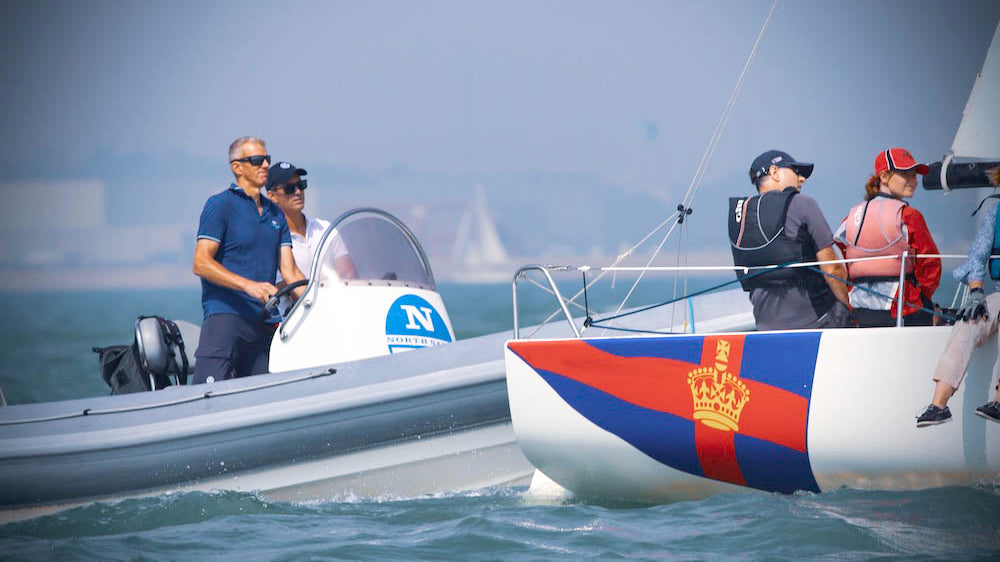
CHARITY CUP COACHING TAKEAWAYS
CHARITY CUP COACHING TAKEAWAYS
Coaches Perspective on Weekend Club Race
📸 Louay Habib/Royal Southern Yacht Club
Local experts onboard the North Sails RIB took to the Solent each day to offer coaching tips to all 75 One Design and IRC boats competing in the Royal Southern Charity Cup Regatta. Neil Mackley has summarised the most frequent points of feedback for you to apply to your next weeknight or weekend club race.
Less Crew Equals Less Righting Moment
Due to the restrictions on crew numbers, a lot of boats were sailing overpowered. It was gusty on the third day of racing, so it was important for crews to set their sails up with a little added twist to help the boat accelerate rather than just heel when the larger gusts hit. More twist (in the jibs particularly) would help the crews stay powered up but not overpowered and would also make it easier to steer the boat.
Optimize your Crew Work
Again, adjusting to reduced crew numbers meant in some cases, crew work could be a main point of focus. I saw a few boats gybing the mainsail after the spinnaker pole was tripped. I think it is smoother to always gybe the main and then trip the pole to help keep the kite flying. Or still trip the pole, gybe the main, and then fit the pole back on the new gybe, whilst keeping the boat under the kite and in control.
Go into Mark Roundings with a Firm Plan
The other area that comes into play and also gets exaggerated by less crew is rounding the leeward mark. Dropping one or two boat lengths a little early is much better than waiting until the last second and sailing past the mark. The kite drop will take longer with less crew and there is also a higher workload on each crew member, so this needs to be accounted for. Sailing two boat lengths or more past a turning mark and then sailing back to the mark takes at least 20 seconds, dropping 15 seconds early is therefore still a gain.
Assign Job Roles Onboard
Adapt your crew roles to the reduced numbers. It is important to have a plan of what needs to be done, when it needs to happen, and by who. You should only lose one crew off the rail at a time if at all possible. Less hands to help mean everyone is busy, so assign each crew their duty to take charge and execute.
Sail Selection
When it comes to choosing the right sails to meet conditions, most teams will know what the ideal ranges are for each sail whilst fully crewed. But this is likely to be different when sailing shorthanded and is probably most exaggerated at the crossover from a J2 or Medium Jib to the J3 or Heavy Jib. With a lighter crew, the crossover is going to be a couple of knots lower. So if the normal crossover was 16-17 knots, then this could actually be 14-16 knots with less crew, maybe even 12 knots. This is definitely worth looking at and testing.
The most effective coaching tip I gave was simply asking the teams to drop the jib car back a little to encourage twist in the jib. Lots of boats were sailing with older inventories so the sail shape has drifted aft, and the leech rounded up. In this case, I advised boats to ease the mainsheet just a few cm’s, as over sheeting makes the shape worse. Twist is our friend, as it encourages the sail to breathe and helps the boat accelerate when a gust hits. Twist helps to steer in gustier conditions, and if there is not enough twist, the boat will want to round up in the pressure increase, as opposed to depowering and still accelerating forward.
📸 Louay Habib/Royal Southern Yacht Club
📸 Louay Habib/Royal Southern Yacht Club
📸 Louay Habib/Royal Southern Yacht Club
📸 Louay Habib/Royal Southern Yacht Club
Sign Up for North Sails News
READ MORE
READ MORE
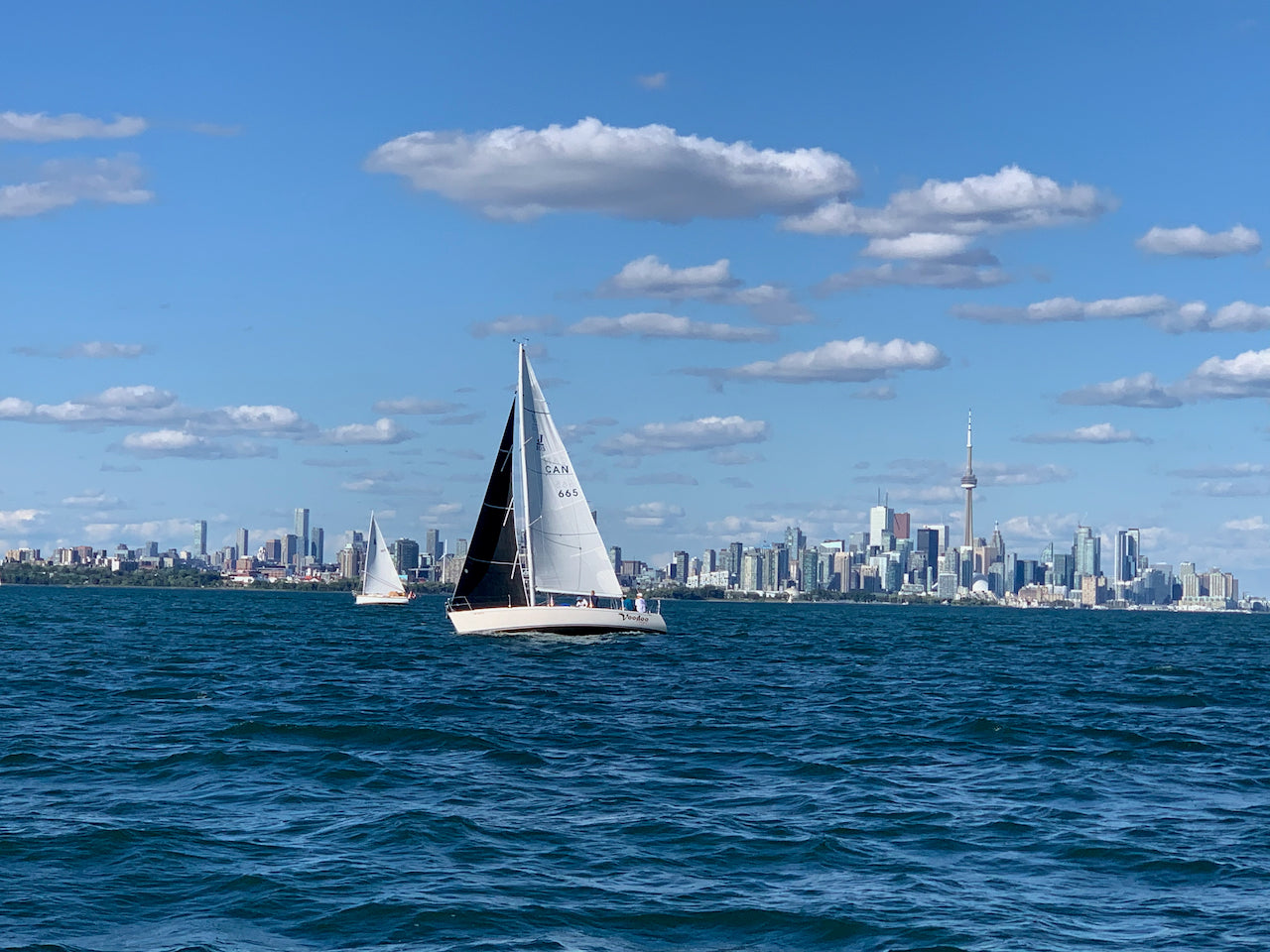
RACING IS BACK
RACING IS BACK
Getting Back Into The Racing Groove
Man does it feel good to be back out on the water in a racing atmosphere. With the stage 3 reopening in Toronto and Peel regions, many of us were able to have racing “reopen” at our yacht clubs. A concept a lot of us believed wouldn’t happen at all this season. In this sense, patience paid off and we’re able to get the adrenaline pumping with weeknight racing.
We had four divisions, small WS Fleet, DH WS Fleet, Large WS fleet and Ultra WS fleet, for a total of 27 boats signed up from both MCC and EYC. At MCC, our first race night on August 5th and it was a breezy night to kick the series off with. My body definitely wasn’t used to those movements anymore and was definitely feeling it the next day. We had a nice offshore NW breeze with an average of 12-15 kts; close hauled for most of the legs.
High Tea had a great night with the 3Di Raw Mainsail and 3Di Raw Furling Jib, taking 2nd in the Ultra WS fleet while Endeavour took 3rd. Koodos to their crew for nautical themed masks. Their smiles for being out on the water were beaming through their masks. Great Escape was flying around the course as well with their new light/medium 3Di Raw jib (Looking snazzy Richard!); and let’s not forget 3Di Raw powered Rum Kist, skippered by Bill Morland and crewed by his kids and friends. Fantastic to see youth out on the course, keeping us all in check.In the DH WS fleet, we saw Surprise take first with their 3Di Nordac, now called 3Di Ocean, mainsail, well done Dave and Wally!
What is even better to see though is how MCC is welcoming other racers from different clubs, whose racing has been cancelled, to come race at MCC. A terrific display of sportsmanship and encouragement to get sailors out on the water.
While we still love cruising, don’t get us wrong, it did feel good to get the heart pumping and be in race mode, even if it was for a couple of hours. The best part of it though, I have to say, was hearing everyone afterwards say the same thing, “it felt good to be out there again.”
READ MORE
READ MORE
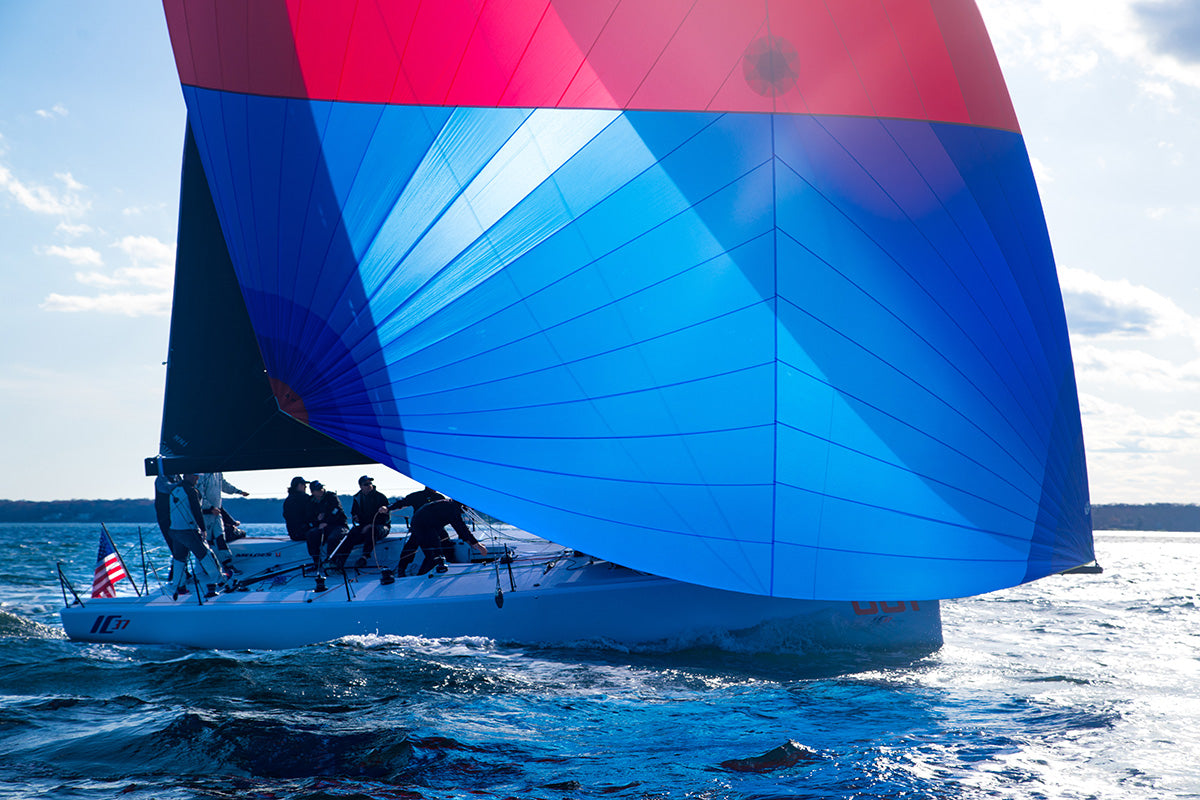
NORTH SAILS IC37 WEBINAR COLLECTION
NORTH SAILS IC37 WEBINAR COLLECTION
Sail Trim, Boat Speed, Crew Tips, and More
We’ve collected all five North Sails IC37 Webinars, hosted by IC37 Class Coach, Greg Fisher, featuring special guests and key experts in the class. Each webinar focuses on something new; from upwind to downwind sail trim to heavy air, overpowered sail trim and rig set up. Hear from Ben Kinney, main trimmer on Members Only, 2019 National Champs on how to obtain maximum speed and stability across a wide range of conditions. From a designers point of view, North Sails designer Mike Marshall shows us the difference in sail trim modes across the ranges using visual support. Grab your notebook and hear the best-of talk about IC37 sailing so you can become the ultimate IC37 sailor.
📸 Hannah Lee Noll / Melges IC37 Training Weekend 2019
Learn about building boat speed in light air conditions, and how sail trim plays plays an intricate role in maintaining power through the lulls.
Upwind Light Air Sail Trim
📸 Hannah Lee Noll / Melges IC37
Staying powered up but not rounding up is key in heavy air conditions. Hear more about best sail trim practices and communication between the trimmers and helmsman.
Upwind Heavy Air Sail Trim
📸 North Sails / James Tomlinson
Discover more about ideal sail trim, using jib leads to create the right entry window when it comes to headstay tension, and shifting the power up on the main to stay in control.
Sail Trim: Medium to Overpowered Conditions
📸 Melges IC37 Class Association / NYYC
The IC37 is a highly physical boat. Our experts dive into the run, going through all the details on how you can get the most speed to stay ahead of the competition.
Downwind Boat Handling
📸 Melges IC37 Class Association / NYYC
Hear from the experts on how to accomplish the perfect drop with the retriever line, and what each role is responsible for to assure a clean mark rounding.
Leeward Mark Roundings
READ MORE
READ MORE
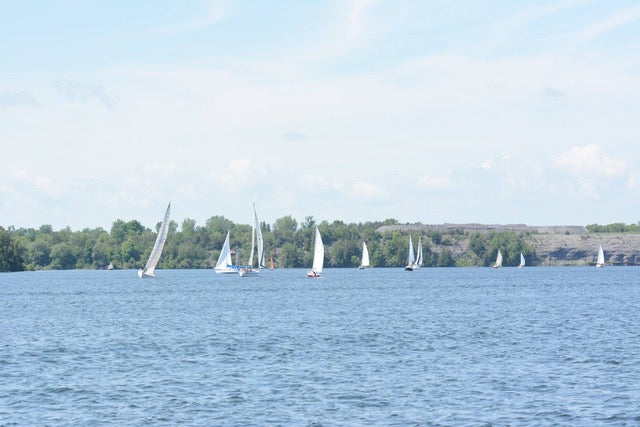
EXPLORING A HIDDEN GEM
EXPLORING A HIDDEN GEM: PRINCE EDWARD COUNTY
Cruise On Over and See The County
Many know the County as it’s known to folks from the Six. Sandbanks Park. The wineries. Charming inns and B&Bs. The rolling pastures dotted with quaint communities like Wellington. Most travellers arrive by car but now that sailing has returned why not consider a cruise instead? What better time to plan a waterborne adventure? Open up your favourite navigation app, Navionics, perhaps. Or Google Earth. Scroll over to eastern Lake Ontario...Take note of the north shore of eastern Lake Ontario.
Within a good day's sail, the varied and vast cruising grounds of Prince Edward County await. Eastern Ontario has embraced Stage 3. Most everything is open. Anchorages. Marinas. Yacht clubs. Stores. Restaurants. Less the crowds.
Prince Edward County (PEC) beginning in Brighton continuing 38 nm east to Cressy Point, there are so many coves, harbours, open reaches, and terrific freshwater sailing to be had. Many different itineraries could be plotted.
The Murray Canal is the western access to the Bay of Quinte leading to Trenton and Belleville. Technically not on the county, both have yacht clubs and public marinas.
The north shore waters of Prince Edward County are dotted with anchorages while marinas are a little scarcer. Baycrest Lodge Marina located in the county just a few miles east of Belleville. A gem of PEC is Picton. Getting to there will likely be a mix of sailing, motor-sailing and motoring as you navigate through the Narrows into Long Reach and then Picton Bay. Once in Picton there are docking options including the Prince Edward Yacht Club or the Picton Harbour Park Marina. The downtown is a walk away.
If you have made it to Picton I’d strongly encourage you to make time to explore the waters east of Picton. Adolphus Reach, Waupoos, Prince Edward Bay, Prinyer's Cove. A region distinguished by limestone cliffs, fresh, clear water, gravelly beaches and good anchorages.
A great feature of cruising these waters is flexibility due to changes in weather. Protected waters can be found easily, no matter the wind direction.
A word of caution. No doubt, you done a proper study of the charts as you sailed or motored to this point. In these waters, safe, damage-free passage making requires vigilant navigating. Use the guides. Use your mobile Navionics app, use your eyes and binoculars but know where you are and where you are going. As they say, the water can get hard fast if one is not paying attention.
Set sail for the Bay of Quinte and the waters around Prince Edward County. The sailing is excellent, with lots to see and do.
All this to say, go! Go as soon as you can.
READ MORE
READ MORE
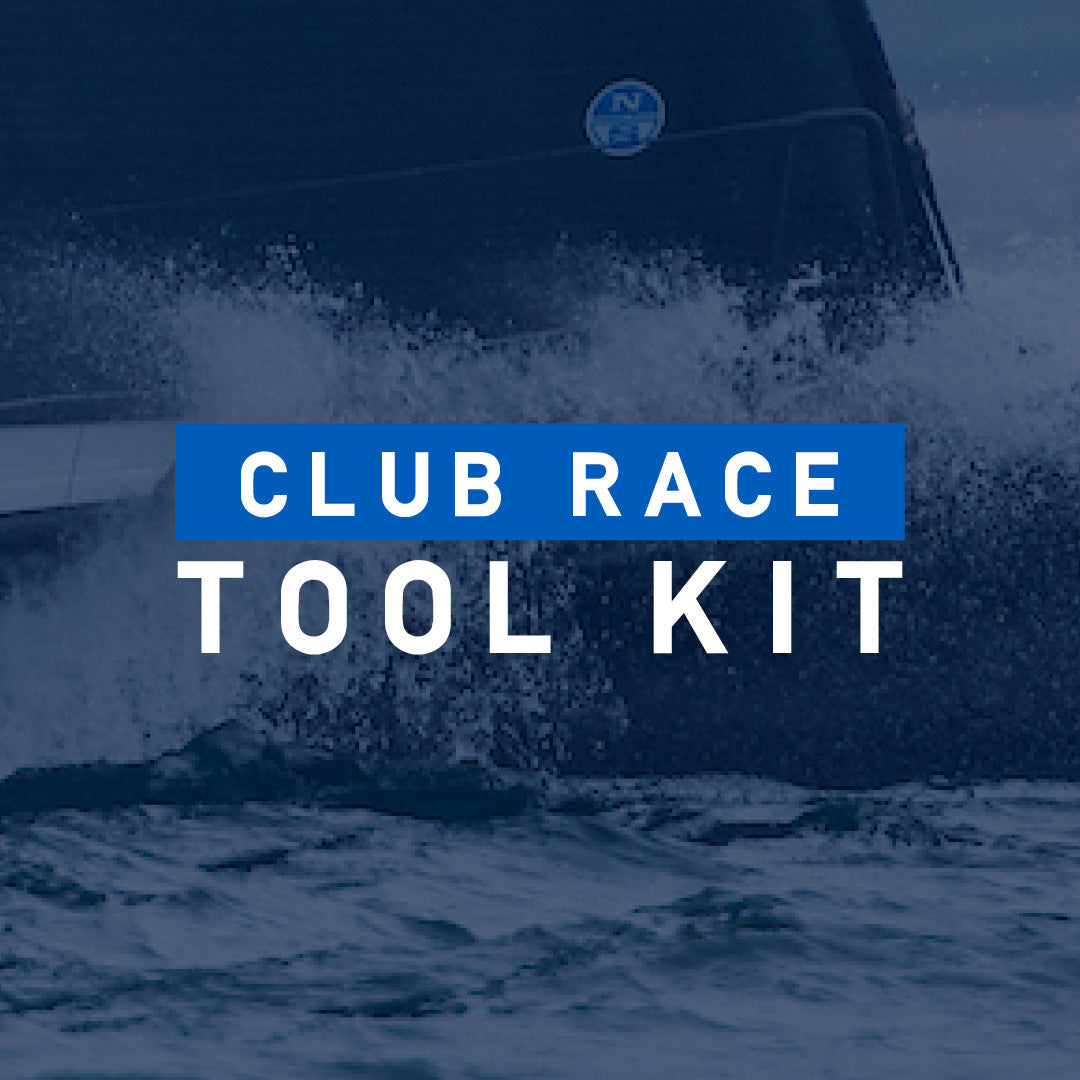
CLUB RACE TOOL KIT
Whether you live to sail on weeknights, or save your energy for the weekend, we’ve assembled a collection of articles to help make your next club race the best it can be. Tips from the North experts on helming, sail inventory suggestions, downwind communication, and DIY sail care methods– all contribute to improving race results at your next weeknight ‘worlds.’
Best Sails for Club Racing
For some, “club racing” means a casual jib-and-main evening race aboard a well-stocked boat carrying roller furlers. For others, it means a no-holds-barred weekend race aboard a Melges 32 with a full crew aboard. Hear from material expert Tom Davis as he lays out your inventory options.
Learn More
Sticking To Your Senses
Remember when your spinnaker was new—how crisp and clean the material felt and the way it crinkled going into the bag? The colors were sharp, and it even smelled like brand new nylon. When the kite filled and snapped in the breeze, you knew it was pulling your boat forward for all it was worth. Your senses knew that the sail was new, and if you allow them, they’ll help you understand when that same spinnaker is ready for replacement.
Learn More
New Sail Technologies Set The Tone
Black has not always been the fast look for sails, but lately more and more black sails are showing up on the water. Why? The simple answer is that many sails are now made with carbon fiber and carbon is black. Read how 3Di was this trendsetter and why it is unique to North Sails technology and stands out (results and color!) from the competition.
Read More
Code Sails: The Ultimate Speed Addition
Did you know that North Sails is the originator of the Code Sail concept? What started out as a straightforward but innovative concept has rapidly evolved into a whole new category of sails, including sails with the Helix structured luff. While Code Sails may look and perform quite differently from one another, there is one common theme: Code Sails are fast, flat, free-flying sails, designed for close reaching angles.
Read More
Make The Most Of Each Upwind
The most important element of upwind boathandling is tacking. Tacking seems like a minor thing, but the difference between a good tack and a poor one can be measured in boat lengths. In a race where you tack ten times, well-executed tacks can provide the margin of victory. And in a close duel, superior tacks will allow you to break free from or keep control of a rival. Find out more on each crew position and how you can together improve your uphill sailing.
Learn More
All About Battens
Thinking about battens? Preparing for a new season is something that is on everyone’s mind. Whether you’re staging your boat to launch, planning an extended cruise, or hoisting your sails for a weeknight club race; It’s important to make sure you’ve got your battens installed properly and tensioned correctly. Checking your battens will provide better sail shape and performance – and ensure you don’t lose them after the first tack or jibe!
Learn More
Steering Downwind: Less is More
Steering off the wind, on reaches and runs, requires a coordinated effort between helmsman and spinnaker trimmer. Your trimmers and tactician can sometimes conflict in feedback which makes things tricky. Here are some tips on how you can acknowledge and respond to direction, while maintaining optimum speed downwind.
Learn More
DIY Sail Care & Maintenance Tips
There are many ways you can help prolong the life of your sails. Our Certified Service experts wrote down pointers to keep you aligned with our sail care maintenance practices, which can be part of your regular routine while you are at home, or on your boat.
Read More
Create Your Own Club Race Playlist
Want to learn more about boat prep, sail care, and optimizing your rig for your weeknight race? Scroll through our webinars and personalize your own club race webinar playlist. Simply find the webinars you want to collect and under video, click ‘save’. From there you can ‘create your own playlist’, and use the drop down menu to select your privacy settings, if you want your playlist to be private. Rewatch and rewind whenever you like.
Create Your Playlist
READ MORE
READ MORE
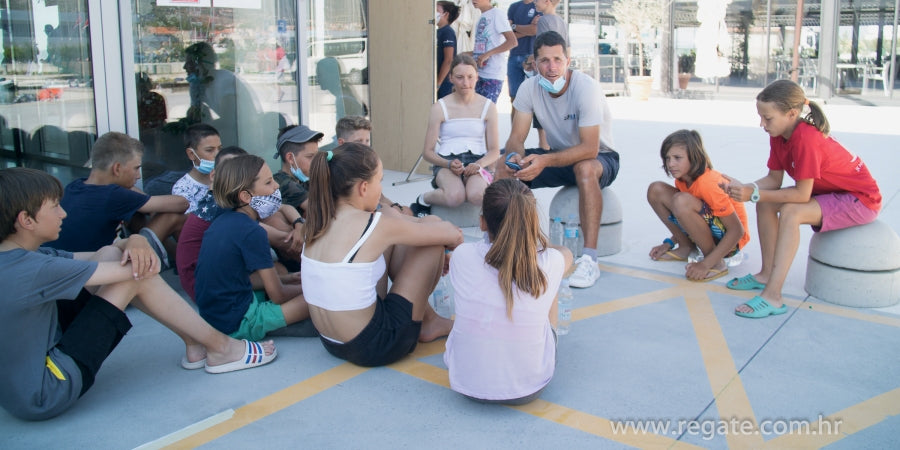
TEAM RACE PH
Team race PH
Ekipa kodnog imena "Uljanik 2", a u sastavu Noa Gorički, Luka Lorencin, Luka Pahljina i Marko Puljiz, inače članovi JK Uljanik iz Pule, rtenirani od starne Daria Klibe, najbolja su ekipa na Ekipnom prvenstvu Hrvatske za klasu Optimist. Da bi trijumf Pulskog kluba bio potpun pobrinula se ekipa "Uljanik 1" u sastavu Edi Jurman, Mija Močinić, Ema Grabar i Jakov Močinić koja je osvojilo srebro!
Naravno, trener i Uljanika 1 je Dario Kliba.
Ovo prvenstvo je bilo nastavak klasičnog Prvenstva Hrvatske koje je završilo u subotu 1. kolovoza i organizator mu je također bio Jedriličarski klub Marina Kaštela. S jedrenjima se krenulo već u nedjelju, a kako je vrijeme išlo na ruku Regatnom odboru, finala su se odjedrila već sutradan, tako da nije bilo potrebe da se iskoristi rezervni dan.
Uvjeti na moru su bili slični onima na prethodnoj regati, bar što se temperature tiče, a po pitanju vjetra bilo je raznolikije. U nedjelju se flota stacionirala ispred Slatina na otoku Čiovu... za one koji ne poznaju tu zonu, to je unutar Kaštelanskog zaljeva. Na more se izašlo već oko 10 sati a puhalo je svega nekoliko čvorova nestabilnih po smjeru. Zato su ekipe zadužene za postavljanje regatnog polja imale više nego pune ruke posla, ali srećom po njih ubrzo je regata prebačena na vanjsku stranu Čiova, na mjesto gdje se jedrilo prethodnih dana.
Tu je maestral bio dosta stabilniji i puhalo je do desetak čvorova, a to je bilo dovoljno za nešto više od polovice Round Robina, odnosno dijela natjecanja u kojem je potrebno da jedri svatko protiv svakoga.
Inače je to princip po kojem se jedri "team race", a pojam Round Robina uglavnom je jedna od prvih asocijacija vezana uz dvobojsko jedrenje, tzv. match race.
Drugi dan regate RO se nije zadržavao sa sjeverne strane Čiova, već je odma zauzeo kurs prema provjerenoj lokaciji i tamo je regatno polje ovog puta bilo postavljeno na jugo koje je puhalo od 5-6 čvorova, pa sve do 15-16. Pratio ga je kratki oštri val koji je manje iskusnim klincima i klincezama stvarao probleme punjenjem njihovim jedrilica morem.
Na prvenstvo se prijavilo 16 ekipa. Uz spomenute dvije ekipe, JK Uljanik je imao još jednu ekipu, a njihovi sugrađani iz JK Vega dvije. Tako da se može reći da su Pulski jedriličari činili više od 30% regate.
Osim njih po dvije ekipe imali su još JK Split, JK Mornar i JK Briva, a svoje šanse sa po jednim timom okušali su JK Labud, JK Zenta, JK Galeb, JK Opatija i JK Trogir. Inače, ekipe imaju po četiri člana, a pravila im dopuštaju i jednu rezervu.
Ono po čemu se ekipno jedrenje razlikuje od klasičnog flotnog, gdje svaki jedriličar jedri samo za sebe i skuplja bodove za svoju korist, kod ekipnog jedrenja svi bodovi jedne ekipe se zbrajaju. Logičan zaključak, a da bi se postigli što bolji rezultati više nije bitno da se prvi stigne do cilja, već da cijela ekipa kao kolektiv ostvari što manju sumu kaznenih bodova. Drugim riječima, nije uopće bitno da li će netko iz ekipe stići prvi, dapače, to se čak i na jedan način penalizira. U slučaju izjednačenja bodova pobjeda odlazi onoj ekipi čiji član nije prvi presjekao ciljnu ravninu!
Još jedna stvar je drugačija od klasičnog flotnog jedrenja, a to je oblik regatnog polja. U Ekipnom jedrenju se jedri tzv. zmija. Nakon starta jedri se u orcu, potom se desnim bokom okreće u mezzonavu. Nakon toga ponovno poluokret desnim bokom da se zauzme kurs u krmu, a kad se stigne do te bove ona se ostavlja lijevim bokom i ponovno se jedri mezzonava. Nakon dolaska do slijedeće bova ponovno slijedi okret u lijevo i u orcu se jedri do cilja. Kako se mora odjedriti vrlo velik broj regata sve distance su relativno malene i uglavnom su duljine pojedinih dionica oko 50 metara.
Kako je bilo prijavljeno 16 ekipa, matematika je pokazala da se moralo odjedriti ukupno 120 pojedinačnih matcheva! Da bi se to moglo realizirati stalno su u polju bila po tri para ekipa. Nakon starta prvog para slijedila bi procedura za drugi par, pa nakon toga za treći par. Kad bi prvi par završio svoj match krenula bi predstartna procedura za slijedeći par i tako do kraja Round Robina.
FOTO: JK MARINA KAŠTELA
U svakom slučaju ovakvo jedrenje zahtijeva određeni kombinatorički stil razmišljanja natjecatelja i sigurno je lakše pripremiti se za ovakvo natjecanje kad u klubu postoji veća baza, odnosno veći broj jedriličara i jedriličarki da se mogu složiti bar dvije ekipe. To se najbolje vidjelo na primjeru prve dvije ekipe, jer npr. trećeplasirana skupina jedriličara, koja je jedrila pod zastavom JK Labud, a u sastavu Josip Tafra, Marin Ljubičić, Grigor Pettener, Roko Čepić-Zokić i Antonio Milišić s trenerom Vedranom Mandićem, sastavljena je od jedriličara sa samog vrha rang ljestvice, ali Puljani su pokazali da je potrebno još nešto osim izvlačenja maksimalne brzine iz jedrilice.
Što se tiče kvalifikacijskog dijela, Round Robina, svaka ekipa je morala odjedriti po 15 matcheva. Na kraju su tu bili najuspješniji članovi ekipe Uljanik 1. Oni su imali idealni skor od 100%, odnosno pobijedili su u svih 15 plovova!
Iza njih su bili Labudaši, koji su definitivno pokazali svoju kvalitetu s impresivnih 14 pobjeda. Već se zna da su se u polufinale s njima plasirali članovi Uljanika 2, a pravo na završnicu osvojili su s 13 pobjeda. A četvrta ekipa je u polufinale stigla s 12 pobjeda i to su bili članovi JK Vega po d imenom Starships.
Ostale ekipe su imale po manje od 10 pobjeda, a koliko je svaka osvojila bodova i koja su mjesta zauzeli možete vidjeti na ovom linku, a ako ste željni malo detaljnije analize kliknite na ovaj link.
Prvoplasirani Uljanik 1 je za svoje suparnike u polufinalu izabrao sugrađane iz Vege, tako da je Labudu na megdan izašao Uljanik 2.
Oba para su priredili napeta jedrenja i svi su morali odjedriti po tri plova, jer su u finale išli oni koji su imali dvije pobjede. Kao što već znate, parovi u posljednjoj fazi PH bili su Uljanik 2 i Uljanik 1, odnosno Labud i Starship.
Ekipa s višim startnim brojem nije pokazala da se boji klupskih brojeva jedan i iz oba finalna plova izlaze kao pobjednici! Drugi par je priredio neizvjesnije matcheve, pa su morali odjedriti i treći.
Bodovna stanja u završnici možete pronaći na ovom linku.
Malo detaljnijom analizom može se vidjeti da je Uljanik 2 imao i malo veću dozu sreće na svojoj strani kad je i u polufinalu i u finalu osvojio bod pri bodovnom stanju 18:18, ali zar postoji netko tko bi odbio pomoć gđe. Fortune?
READ MORE
READ MORE
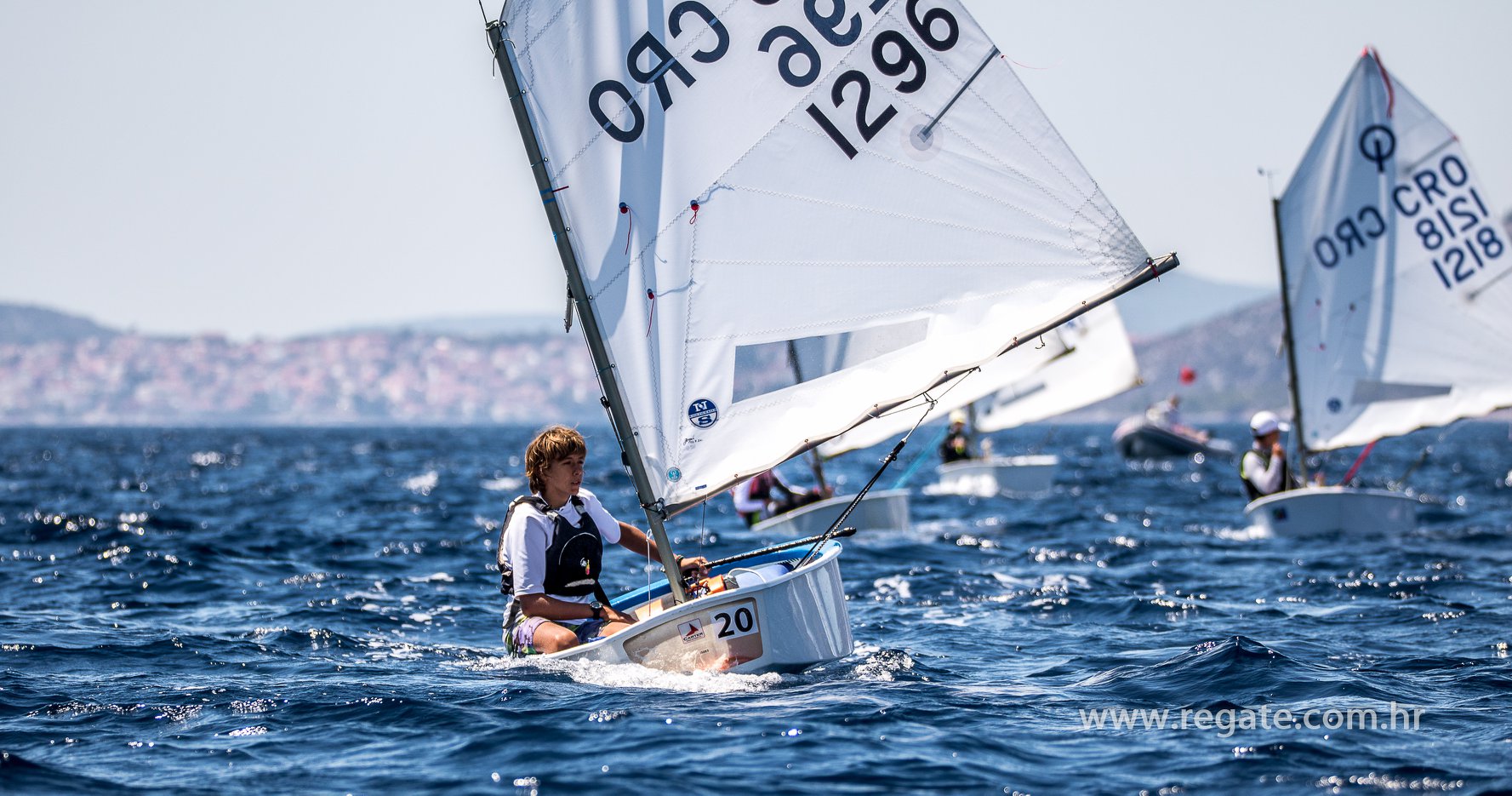
PRVENSTVO HRVATSKE ZA KLASU OPTIMIST
Prvenstvo Hrvatske za klasu Optimist
Tristan Tol, član Jedriličarskog kluba Vega iz Pule novi je prvak Hrvatske u klasi Optimist s čak 10 bodova prednosti u odnosu na drugoplasiranog Josipa Tafru iz JK Labud, a koji je srebro osigurao s pet bodova prednosti u odnosu na brončanog Bepa Duplančića iz JK Zenta. Regatu je organizirao Jedriličarski klub Marina Kaštela.
Do svojih rezultata su stigli nakon 9 odjedrenih plovova. Prvog dana regate, u srijedu 29. srpnja, odjedrena su tri kvalifikacijska jedrenja, a u četvrtak još dva. Nakon toga je uslijedilo formiranje finalnih skupina... zlatne i srebrene.
Iduća dva dana na moru se jedrilo samo unutar tih skupina, bez daljnjih podjela, a ukupno su odjedrena još četiri plova. Stvarno bogat i skoro maksimalno iskorišten program pogotovo kad se uzme u obzir da se jedrilo u srcu ljeta po iznimno teškim temperaturnim uvjetima. Visoke temperature su vladale već od jutra, a maestrali su dozvoljavali jedrenje tek iza podne. Srećom, puhali su stalno iznad 10-12 čvorova pa je bar na moru bilo ugodnije nego za vrijeme čekanja na kopnu.
Nakon prvog dana jedrenja već se moglo naslutiti da Tristan Tol ima ozbiljne namjere i da je u pobjedničkoj formi. U tri održana jedrenja pobijedio je u prvom i trećem plovu svoje skupine, a u drugom plovu je završio na drugom mjestu. Dobro otvaranje je imao i član drugog Puležanskog kluba, Jakov Močinić - JK Uljanik. On je osvojio dva druga i jedno prvo mjesto. Zajedno s njima na vrhu se odmah istaknuo i Josip Tafra. I on se mogao pohvaliti prvim i drugim mjestom, ali mu je četvrto iz prvog plova malo pokvarilo prosjek.
Njih trojica su već u startu značajno odmaknuli ostalima. Najbolje se to može vidjeti na primjeru četveroplasiranog na kraju dana, Edija Jurmana iz JK Uljanik, koji je bio iza Josipa čak 9 kaznenih bodova.
Što se tiče djevojčica, najbrža u srijedu je bila Katja Rabak iz JK Vega koja je dan završila na 6. mjestu, a imala je jednak broj bodova kao i petoplasirani Luka Pahijina iz Uljanika. Stvarno vrlo dobar dan za jedriličare iz Pule!
U četvrtak se jedrio kraj kvalifikacija i kreću prva odbacivanja. Matematika je kao i uvijek zanimljiva i nemilosrdna, pa je zanimljivo vidjeti rasplet na kraju dana.
Imena trojca u vrhu su nepromijenjena, jedino što su se bodovno jako približili jedni drugima. Prva dvojica sad imaju po 6 bodova i zamijenili su se u redoslijedu. Jakov i Tristan imaju potpuno jednaka mjesta, jednaki rezultat u posljednjem plovu, ali Jakov je u predzanjem bio bolje plasiran (pobijedio je u svojoj grupi, dok je Tristan u svojoj završio na drugom mjestu). A da bi nastavak regate bio još napetiji pobrinuo se Josip koji je bio na samo jedan bod iza njih dvojice.
Najveći skok u plasmanu imao je Zentaš Bepo Duplančić. Kvalifikacije završava na četvrtom mjestu iako je u drugi dan Prvenstva ušao s 12. pozicije. Inače, Bepo je i najbolji u kategoriji U12.
Među djevojčicama je također došlo do smjene na vrhu. Katja Rabak je skliznula na 11. mjesto, a njen status najbrže djevojčice preuzima Mija Močinić iz JK Uljanik.
Petak... početak završnice... formirane su dvije skupine sa po 69 natjecatelja i u tom sastavu nastavljaju jedriti i u subotu.
Sad je jedrenje sigurno i teže, jer su svi sličnih jedriličarskih vještina u istim jakosnim skupinama. Naravno, to odmah ima i direktnog efekta na plasmane na kraju dana, ali bodovi skupljeni u kvalifikacijama još uvijek dobro dolaze za održavanje visokog plasmana. To su najbolje na vlastitom primjeru osjetili Tol i Tafra jer su obojica bili dosta loši u posljednjem jedrenju dana. Srećom, odbacivanja su ih spasila, pa su i dalje ostali u vrhu, a čak su i obojica napredovala za po jednu stepenicu. Tako Tol ponovno preuzima vodstvo, a Tafra prvi put dan završava kao srebreni.
Najveći pad u vrhu imao je Jakov Močinić. On je s prvog mjesta skliznuo na sedmo. Slično kao i dvojac s vrha i on je kiksao u posljednjem plovu, ali najveći bodovni teret mu ipak nije bio taj plov, neko prvi plov dana kad nije startao.
Među djevojčicama ponovno dolazi do rošade. Katja Rabak za tri boda prelazi Miju Močinić i preuzima mjesto vodeće djevojčice.
Što se tiče srebrene skupine, tu su malo više do izražaja došle pripadnice nježnijeg spola. Kaja Grubišić iz JK Split i Ana Grubelić iz JK Uskok su na vrhu skupine, a najbliži dječak im je mlađahni Ricardo Juretić iz JK Opatija.
I na kraju, još dva jedrenja u subotu. Što se tiče zlatne skupine to je sigurno najzadovoljniji bio trener JK Uljanik jer su njegovi Mija i Jakov Močinić odnijeli pobjede u oba plova. Jakovu je to bila jedna moralna zadovoljština koju mora iskoristiti kao motiv za nastavak s vrhunskim jedrenjem u nastavku sezone, dok je Miji ta pobjeda olakšala povratak na vodeću poziciju među djevojčicama.
Što se tiče vrha raspored je ostao jednak, a na postolje su se popeli Tol, Tafra i Duplančić!
Slično je završilo i u srebrenoj skupini, ista imena, ali znatno veća doza neizvjesnosti. Ricardo je uspio preteći Anu za tri boda i izjednačiti se s Kajom. Međutim, njena pobjeda u sedmom plovu je išla u njenu korist i osigurala joj pobjedu u skupini.
Osim što je regata bila zahtjevna po pitanju topline i dugih prebacivanja do regatnog polja s vanjske strane Čiova, sigurno će svima ostati u sjećanju po brojnim otežavajućim okolnostima vezanim uz zadovoljavanje sigurnosnih elemenata zadanih od strane raznih stožera.
Napravljeno je devet jedrenja po maestralu do 14 čvorova. Svaki dan je bilo sve u redu, jedino nas je u petak nevera potjerala s mora, a danas (subota) nevera je krenula kad smo već svi bili u marini. Tako da su svi bili zaštićeni. A jučer nas je uhvatio samo rub. Bili smo van Čiova i nevera je stigla do njega.
Mi kao organizatori smo se najviše borili protiv Korone... da ne bude grupiranja, da se ne ulazi u hangar i zatvorene prostore i da se zadovolje sve smjernice epidemiološkog stožera.
A što se tiče natjecanja, najbolji su pobijedili! Međutim, još nismo gotovi. U nedjelju starta timsko PH koje će se jedriti dva dana s tim da imamo i jedan dan u pričuvi ako ne budu odgovarajući vremenski uvjeti.
Armano Zekan, JK Marina Kaštela
A evo tko su sve slavodobitnici u pojedinim kategorijama:
DJEČACI
1. Tristan Tol - JK Vega Pula
2. Josip Tafra - JK Labud Split
3. Bepo Duplančić - JK Zenta Split
DJEVOJČICE
1. Mija Močinić - JK Uljanik Pula
2. Katja Rabak - JK Vega Pula
3. Noa Gorički - JK Uljanik Pula
DJEČACI DO 12 GODINA
1. Bepo Duplančić - JK Zenta Split
2. Toma Smirčić - JK Split Split
3. Marko Puljiz - JK Uljanik Pula
DJEVOJČICE DO 12 GODINA
1. Ema Grabar - JK Uljanik Pula
2. Nina Marušić - JK Zvir Hvar
3. Marta Lolić - JK Split Split
READ MORE
READ MORE
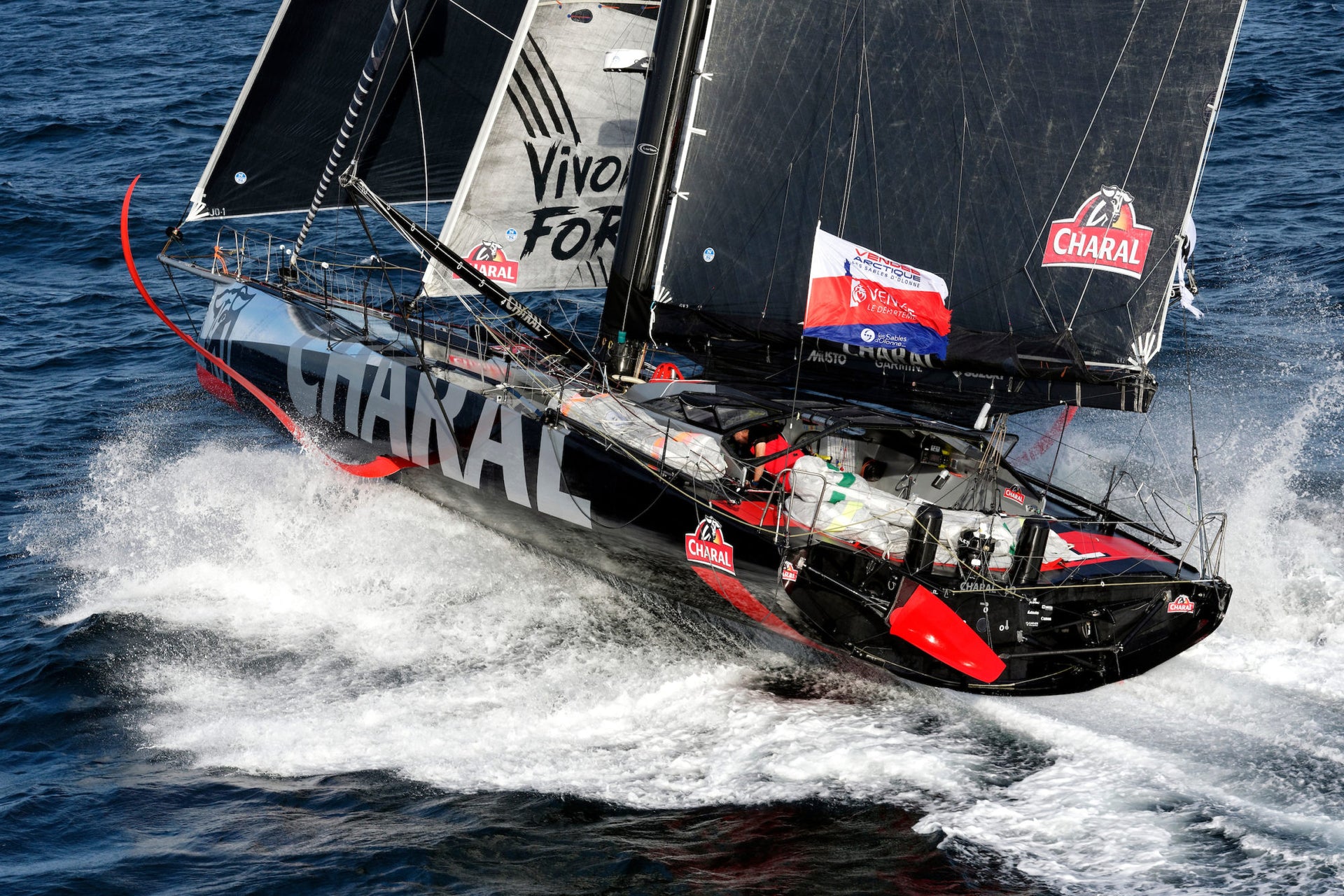
BUILDING SAILS FOR THE IMOCA
BUILDING SAILS FOR THE IMOCA
From Drawing Board to Physical Sail Plan on an IMOCA
📸 Jeremie leCaudey
November 8th, the next edition of the Vendée Globe race is set to start from Les Sables d’Olonne, North Sails has designed the sails for the ¾ of the IMOCA fleet, 17 of which have a full set and 7 with a partial set.
The sails on a boat are essential: they ensure the propulsion of the boat. But this “engine” must adapt to the boat as well as the pilot. Each boat has a distinctive set of sails depending on several parameters such as the shape of the hull, the deck plan, the rigging, or even a new element today: the foils whose air behavior plays a critical role in the stability of the boat. This wardrobe must also cover all the wind conditions encountered during competition.
It is up to the designers to design a set of sails that are reliable, efficient, versatile, and tailor-made to each skipper and that does not involve overly physical maneuvers. These sails need also to have both torque, strong acceleration at low revs, (bottom of the sail range), and power when, once launched, the boat accelerates quickly. Defining the right sail inventory can be complex. Yann Regniau, Yann Andrillon, and Quentin Ponroy, designers at North Sails France, enlighten us on the design of the sails of a singular boat, the IMOCA for an equally singular race: the Vendée Globe.
Designing Sails for The Vendée Globe Weather Conditions and Sail Optimization
IMOCA Sail Design Support and Tools Skipper and Team Sail Inventory
Trends and Next Steps
How do you design a set of sails for a Vendée Globe?
There are no absolute rules. It depends on the team, whether they are building a new boat or not, and on the expertise they have in-house. For most new boats, we are involved right from the design stage, working alongside the architects to define the sail plan. In all cases, we have contact and information meetings to precisely target the skipper’s needs and what we can bring him in terms of experience and tools. Then, we draw up the first drafts from the architect’s plans where we can directly simulate our sails in 3D, which allows us to refine the triangulation.
In summary, the sail design is fed by three means: theoretical studies from North Sails (aero and structure), a rich database of sails designed for IMOCA boats combined with our expertise and boat-skipper input. The main stages include the definition of the specifications of the sail with the team; the design (theoretical studies, 3D drawing, and structure); the manufacturing sheet; the manufacturing of the 3Di structure in Minden (Nevada, USA) and finally the finishes at North Sails France (Vannes, Brittany.)
📸 Raphael Demaret
What are the particularities of the Vendée Globe in terms of weather conditions and sail optimization?
One of the peculiarities is the length and duration of the Vendée Globe, the race takes the fastest boats 2 ½ months to complete, but most racers finish in three months. The sails become extremely stressed throughout the race, so the structure must be adapted to account for all possible wear and tear. Reliability is the keyword. The three aspects that characterize this race – around the world, single-handed and non-stop – also apply to the sails.
Today and for several editions, IMOCA boats have at their disposal an arsenal of precise meteorological tools with a southern limit that must not be exceeded to avoid the ice zone and hit drifting icebergs. This was not the case during the very first Vendée Globe, where computer tools were limited. The boats crossed the zone of icebergs and sailed very far south in the Pacific and Indian Oceans to reduce the distance to be covered. During the 1997 edition, after their boat capsized, the sailors Tony Bullimore and Thierry Dubois had to be rescued by helicopter. This edition was particularly marked by the tragic disappearance of the Canadian Gerry Roufs, who in the last SOS announced: “The waves are no longer waves, they are as high as the Alps.” Modern IMOCA boats avoid sailing in winds more than 40 knots, at the risk of suffering major damage without going any faster. They opt for a routing where they can exploit the boat’s speed potential. This largely defines the specifications of the sails. And of course, downwind points of sail – the majority in the Vendée – are favored, even if versatility remains important.
What are the particularities of an IMOCA in terms of sail design?
The new foil boats have both a displacement mode and a flying mode that we must reconcile in terms of sail configuration. They can indeed have violent acceleration and deceleration. As the number of sails on board is limited to just eight, the sails must be reliable. If one or two sails are torn, victory could be compromised. They must also be durable with increased shape retention throughout the race and as light as possible, one, to facilitate maneuvers, as these boats are very physical, and, two, to increase performance, particularly by reducing the weight and the center of gravity of the boat, which increases the power of the boat.
Are sails designed for an IMOCA in the same way as for any other support and for any other race?
Yes and no. Yes, because the design process is similar, i.e. we define the sail plan as precisely as possible with the skipper and the boat’s architect, we work on the specifications of the sail, then we work on the surface, the shape, and the structure so that they respond as well as possible.
No, because the result of the design is different. The difficulty is that due to a limited number of sails, you have to be consistent with all the sails and, above all, this race has become a sprint around the world. The aim is therefore to create a sail that performs well in terms of shape, that is strongly reliable when aging and that, of course, is not too heavy.
📸 Jeremie leCaudey
What supports and tools do you use?
Within North, we have a software solution for designing, studying, and dimensioning the structure of 3Di sails, the North Design Suite, which includes among others Spiral for the sail design, Desman to model the rigging in 3D and Membrain to generate deformed sails. We also use Rhinoceros for the architect’s plans.
Once the design is validated, what are the stages in the manufacture of a sail?
We determine the finishing details of the sail (size, length, and number of webbing straps or rope at each corner…) and prepare the layup plan which will allow the production of the 3Di membrane on a deformable mold (no stitching at this stage). On receipt of the sail at the Vannes workshop, we carry out sail layout and the fitting of all additional reinforcements, straps and finishing details
What is your relationship with the skipper and the team?
We have a relationship based on trust and mutual listening. They are all directly involved in the process. We try to listen to them as much as possible to understand their expectations and needs, how they work, their vision of the project, and the boat. Then we try to transcribe this vision in our drawings as best as possible.
📸 Pierre Bouras / TR Racing
Who defines the sail inventory?
The IMOCA class rules limit the number of sails to eight. The choice of these sails is a long discussion and testing over the years to try to have a game optimized for the Vendée Globe. This debate is essentially about downwind sails, as downwind points of sail are dominant in the Vendée and boat performance has evolved. We assist the team in defining this set of sails.
Can you name the sails for this Vendée and what they are used for?
– A Mainsail
– An obligatory storm Jib 20 m2 minimum
– J3: Heavy air upwind sail/gennaker staysail off the wind
– J2: Upwind and close-reaching sail used from 12 knots upwards
– FRO: upwind sailing in light airs and reaching all the way to downwind in heavy air
– J0: Masthead Gennaker (190 m2 flat sail) for light airs and reaching
– A7: Fractional reaching and downwind reaching Gennaker in strong winds
– A3: large Gennaker of around 300 m2 for downwind sailing up to 25 knots
What are the main trends in terms of sails since the last Vendée Globe?
The sails have less volume on the upper part and the volumes are further forward. The most visible point is the reduction in head width and the roach of the leech of our mainsails are “S” shaped. Without forgetting that most of the headsails are load sharing, using the North Sails Helix structure luff.
After the sails are set, what is the next step in the program?
We carry out test sailings to check and validate that the sails meet the specifications defined with the skipper. Sometimes, a sail can be a laboratory sail, it is tried/tested, then it comes back to the sailmaker’s to be modified and tested again. And each outing is important for continuous improvement. We systematically record the data to work on the evolution of the next sails.
How do you help the sailors to get the most out of their sails specially designed for this race?
We help them on the outings to optimize the way the sails are trimmed so that they can find the right setting for each angle of a given sail very quickly.
What changes can be made to the sails for the next Vendée Globe 2024?
Everything will depend on the evolution of the IMOCA class. Will it continue to evolve with increasingly large budgets given the current pandemic crisis? That said, as soon as a new set of sails is designed, there will always be room for improvement. Our sails for 2024 will, therefore, reflect the evolution of the IMOCA class, whether they are 100% foiler or not…
READ MORE
READ MORE
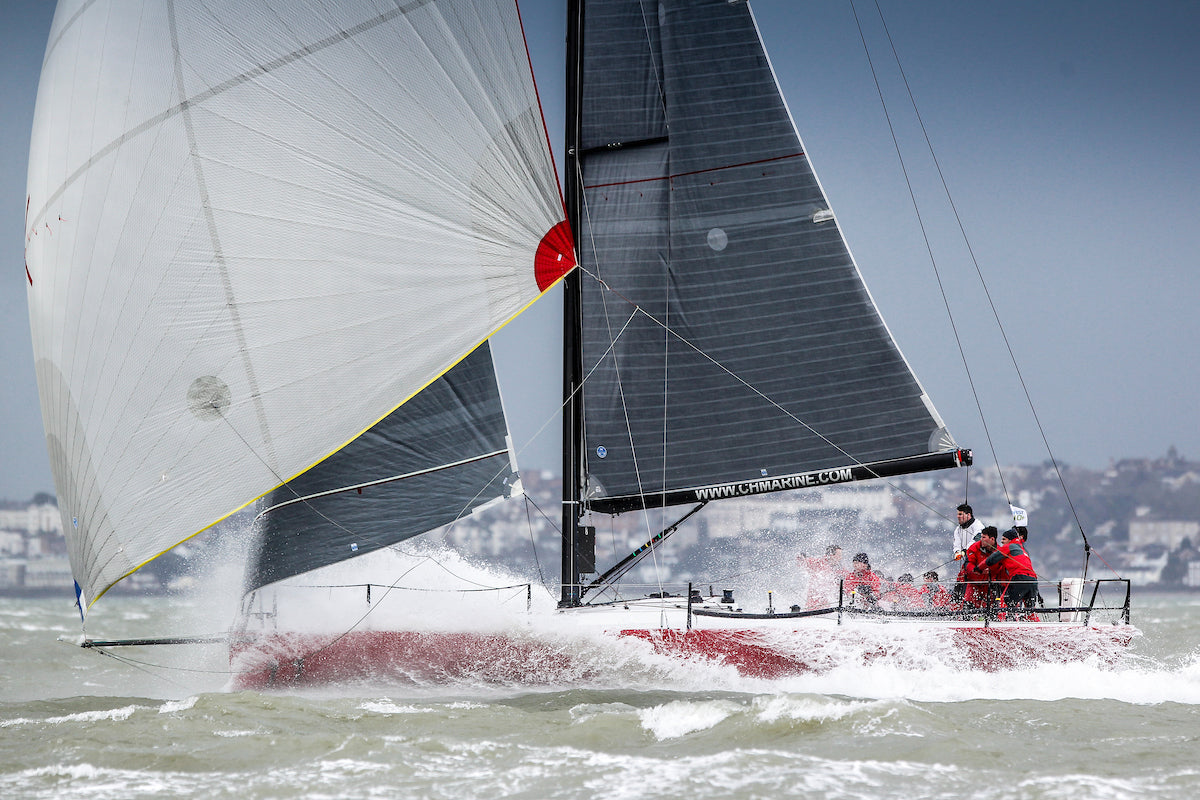
STEERING DOWNWIND
STEERING DOWNWIND: LESS IS MORE
Coordinating Commands To Perfect Downhill Steering
📸 RORC Easter Challenge / Paul Wyeth
Steering off the wind, on reaches and runs, requires a coordinated effort between helmsman and spinnaker trimmer. The spinnaker trimmer often has as good a feel for performance as you do while driving, and together you can coordinate efforts to take advantage of changes in conditions. Of course, as the helm, you must respond to other inputs as well. The tactician may suggest one move, and changing sailing conditions may suggest another. At the same time, you are trying to respond to the trimmer’s input based on sheet load and boat speed. More often than not there are conflicting suggestions: Go up. Go down. Be more aggressive. Steer less.
One effective communication path is to channel all suggestions through the trimmer. Since your tactics won’t succeed without good trim, it helps to keep the trimmer in the communications loop. It also makes life easier for the helm, since you’ll only need to listen and respond to one voice.
📸 Chris Howell
Steering on The Reach
Light to Moderate Air
The shortest distance between two points is a straight line… at least, on a reach it is. Plan your reaches with this as the basic tenet. From there you will have to make modifications based on tactics and changes in the sailing conditions.
In fluctuating wind conditions, work up in the lulls and down in the puffs as necessary to maintain speed, while holding a good average course. Ask the trimmer to indicate when the sheet load is light (head up), and when the spinnaker sheet is fully loaded (bear off). The amount of course change required depends on wind speed.
Tactically on a reach there are times when you must head up abruptly, either in an effort to pass another boat or to defend your position. Alerting the trimmers prior to the move improves the chances of success. Any abrupt course change without warning your trimmers will usually doom the maneuver to failure.
Heavy Air
In heavy air, you are at the mercy of your trimmers. The vang, main sheet, and spinnaker sheet must be eased when the boat is overpowered or it will round up and broach. It is fast to carry as much power as you can as long as you can control it. Carrying weather helm is OK as long as the rudder doesn’t stall, leading to a round up. Keep a hand on the vang, and dump it when the helm is on the verge of stalling.
Don’t let an occasional round up discourage you. Regroup and see how long you can go before you round up again. If you do broach, you can speed the recovery by luffing the main and spinnaker. Bear off to a course below your desired sailing angle before you trim. Work up to a reaching course again only after you regain control at a lower angle.
Aggressive trim is needed in puffy conditions to relieve helm load and build speed. Easing the sails in puffs translates the force of the puff into speed rather than heeling force. If the course to the mark is right at the cusp between spinnaker and jib, then a change to a Code Zero can bring control and blazing speed. If you don’t have a Code Zero, sail a little low of course with the spinnaker, and then change to a jib when it is time to reach up. Do not try to sail the cusp with either spinnaker or jib.
Steering on the Run
Goals on a run vary with the wind speed and boat type. The ideas presented here are accurate for moderate displacement keelboats. Priorities will be quite different on an ultralight sportboat. Regardless of your boat type, it is critical that both driver and trimmers are working toward the same goal.
Light Air (4-10 knots true)
In light winds (up to ten knots true), the optimum sailing angle is about 140° true wind angle (40° above dead downwind). The angle changes very little as the wind speed fluctuates, so it is not correct to head up in the lulls and off in the puffs except for tactical reasons. Tacking downwind and keeping the apparent wind forward is fast. Play the sheets to the wind, while steering a steady course.
📸. Chris Howell
Moderate Air (10-15 knots true)
In moderate winds the optimum speed and sailing angle change dramatically with every change in wind speed. For every knot of wind the optimum course shifts five degrees. In ten knots of wind the optimum angle is 140° true wind angle. In fifteen knots of wind a 165° true wind angle is optimum. Try to respond to every change in wind speed, driving off with the puffs and heading up in the lulls. As you change course the trimmers must also respond, working not only the sheet, but the guy and topping lift as well.
Of course, every movement of the helm slows the boat.
Heavy Air (15 knots and up)
When the wind exceeds fifteen knots, you no longer need concern yourself with changing your sailing angles. Aim for the mark. Sail fast. Keep control. Surf if you can.
📸 Nico Martinez
Heavy Air Tips
Use crew weight to balance the helm, or try some windward heel to push the boat down—as long as you have control.
In overpowering wind—say twenty plus—control becomes a bigger issue, and windward heel is not such a good idea. A heavy air run can lead to death rolls and broaches. To control rolling, avoid sailing dead downwind, and trim the spinnaker directly in front of the boat—don’t let it float out to windward, and choke down the sheet and pole. Also, move crew weight aft. In big breeze, everyone should be in the back of the boat.
A word of caution on boom preventers. In a heavy air broach they tend to break after providing a false sense of security (or the boom breaks). The preventer can also cause a broach if the boom hits the water on a roll to leeward. And once you do broach, if the preventer holds it can keep you pinned until someone finds a way to release it.
Helmsmanship in heavy air conditions must be forceful to keep control. But remember, every jerk of the helm slows you down. Smooth is fast.
READ MORE
READ MORE
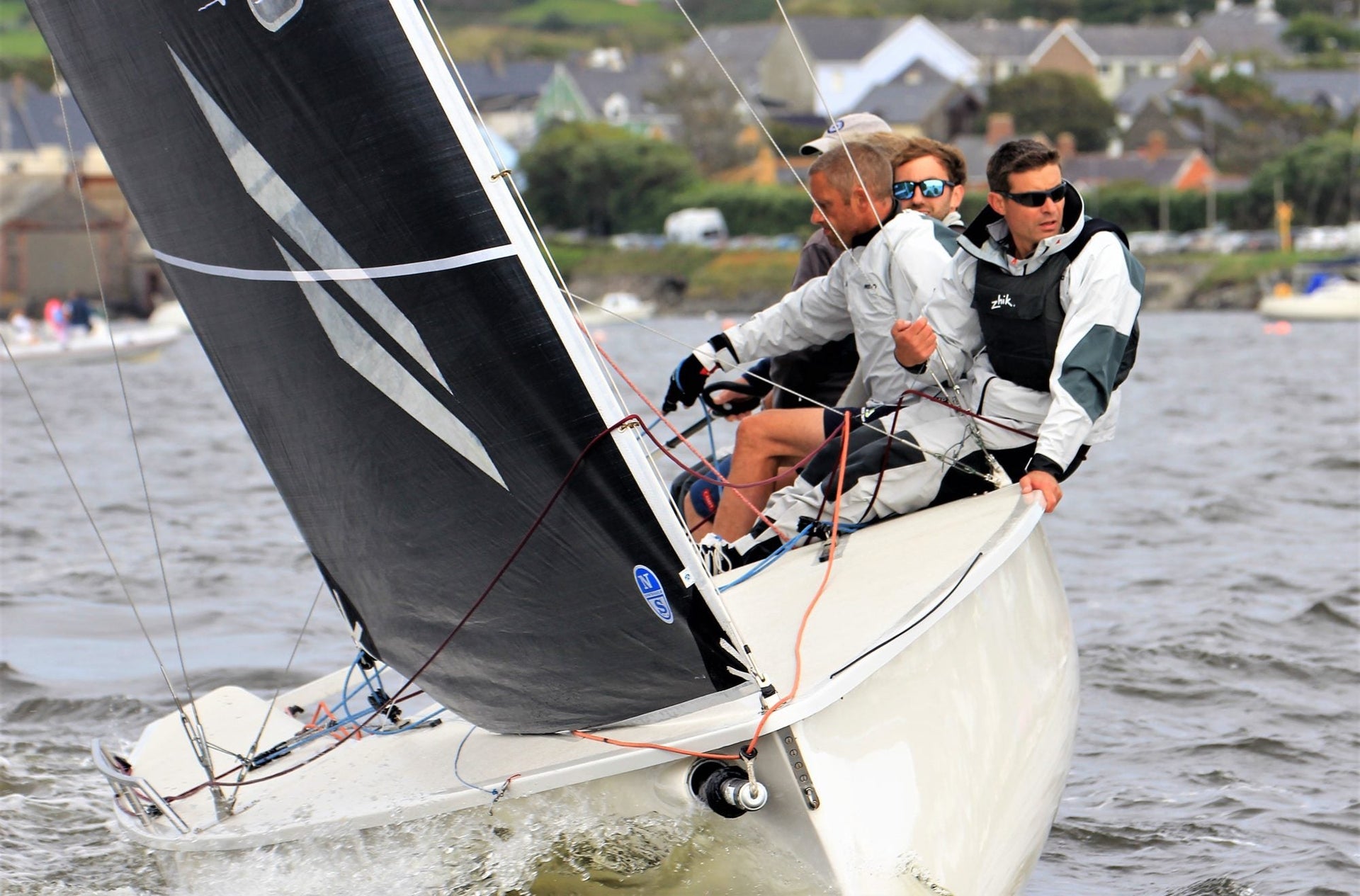
3Di SUCCESS IN THE 1720 CLASS
3Di SUCCESS IN THE 1720 CLASS
#NSVictoryList For Baltimore Cup Clients
📸 Deirdre Horgan
Congratulations to all North customers for their great results in the recently held 1720 Baltimore Cup. Special congratulations goes to first overall finisher, Robert O'Leary, sporting North Sails 3Di main and Genoa. Well done to second place finisher Anthony O'Leary, flying the same combination of North 3Di sails. Fionn Lyden came in 3rd overall, flying a 3Di main, and the Durcan Family sailing T-Bone was 4th overall Flying 2017 3DL upwind sails and excelling downwind with the latest T-6 spinnaker design. T-Bone was the only boat to win two races.Great to see this class enjoying such close racing in the beautiful waters of Baltimore. Back in April 2019 I wrote a piece called "The Trickledown effect". The article explains how 3Di started life in the America's Cup and is now on the smallest One Design boats including the 1720. While on the subject of 3Di, take a look here to understand exactly how it's made. Totally unique in the sailmaking world. When you watch this video, it will explain why a 3Di sail might cost a little more than a conventional 2D sail, and why it will last significantly longer in the long run. We look forward to the next 1720 regatta at the end of August as part of the Cork 300 celebrations. Till then, sail fast!
📸 Deirdre Horgan
READ MORE
READ MORE
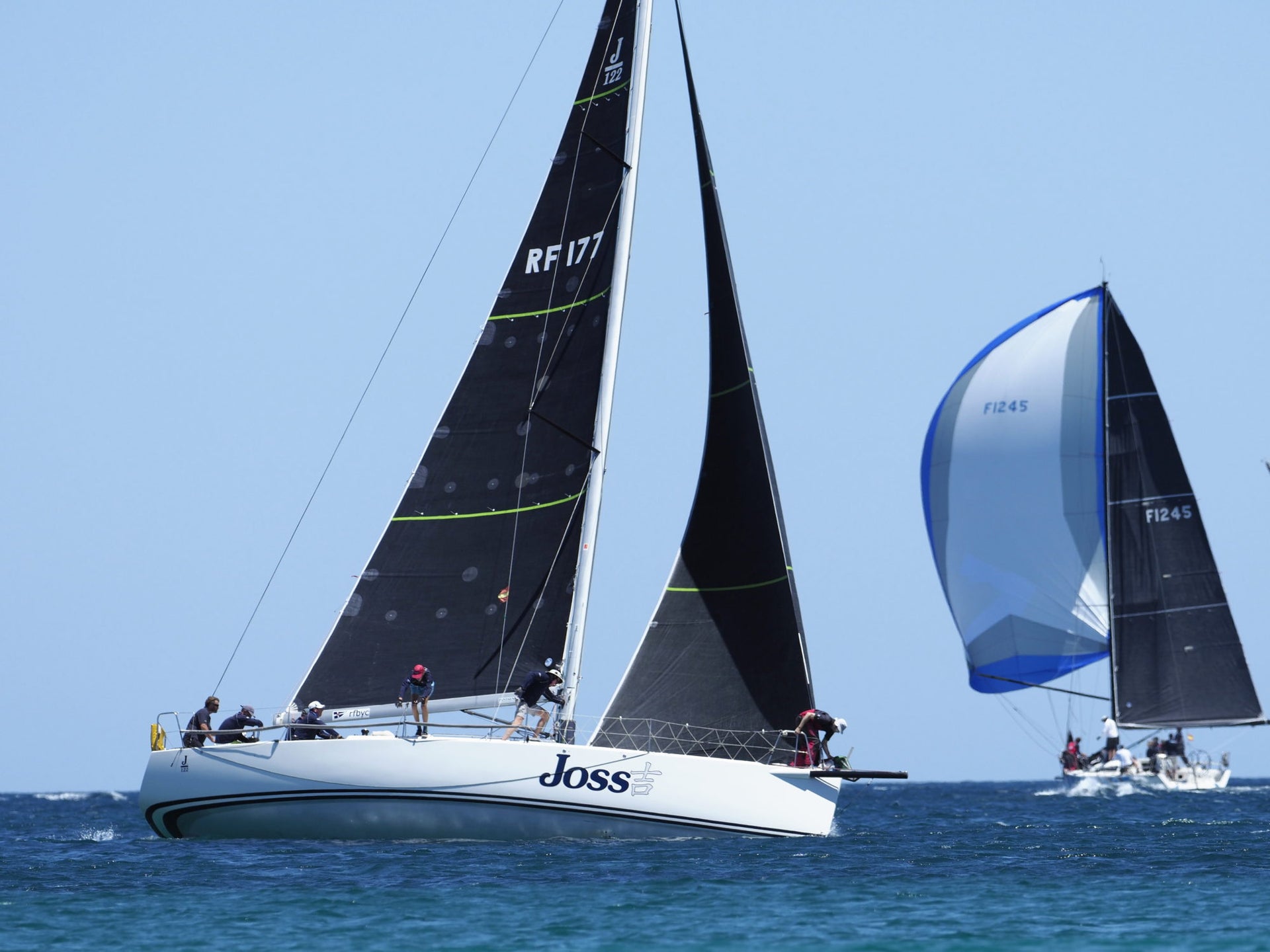
J/122 JOSS MAKES WAVES IN 2019-2020 SEASON
J/122 JOSS MAKES WAVES IN 2019-2020 SEASON
It's All Up From Here For IRC Rated Team
📸 Lindsay Preece / Iron Bark Photos
The Offshore Racing Spring/Summer Calendar in Western Australia consists of 12 ORWA official events, & three club events (RFBYC & FSC) that combine with some ORWA races as Club Sponsored Offshore Series – A total Spring/Summer calendar of 15 races. FSC also conducts a four-race winter series.
J/122 Joss launched in 2012 and has been a regular competitor in Ocean Racing in Perth, Western Australia since she arrived from Papua New Guinea, IN in 2013.
"The more you sail, the more you hopefully improve," and Joss typifies this statement. We had a brilliant 2018/19 Offshore Season – Runner up in the Siska Trophy & Bluewater Div 1 IRC Series, and winning several IRC & YAH ORWA Series, & 2 FSC IRC & YAH Series.
In 2019/20 ORWA changed the “Siska Trophy” criteria from a Bluewater Combined Fleet IRC Series only, to all ORWA Races – 12 Bluewater & Offshore IRC Races (Combined Fleets)
the “Winner” to be therefore crown the “WA Offshore Champion Yacht”.
"The 2019/20 Season has been simply amazing." Joss had a clean sweep of all Offshore Div 1 IRC Series in Western Australia.
33rd Siska Trophy – “Overall Season Champion Yacht (Combined Fleets)
Bluewater Series – Winners Div 1 IRC & PHS
Offshore Series – Winners Div 1 IRC & PHS
43rd Farrawa Cup Series (RFBYC) – Winners (Combined fleet), Winners Div 1 IRC.
Success Cup Series (FSC) – Winners Div 1 IRC & PHS
Captain Stirling Cup Series (FSC) – Winners Div 1 & PHS
Valamdre Winter Cup Series (FSC) – Winners DIV 1 IRC.
"What's the key to our success? An extremely well prepared boat, core crew who have sailed together for several years, a willingness to sail every event in every conditions, aiming for consistent results throughout the season (including enjoying the occasional race win), and sailing a really competitive IRC Rated J/Boat."
"Not to mention the sheer enjoyment and sense of achievement of being able to sail offshore. We are extremely realistic as to the ever improving quality of the yachts competing in WA, and of our chances in terms of repeating such unbelievable season results, the challengers are made somewhat easier when your name is already inscribed on the trophies"
"Our goals in 2020/21 are to continue to be as competitive as possible, enjoy ourselves sailing offshore, and celebrate whoever wins next year."
📸 Lindsay Preece / Iron Bark Photos
READ MORE
READ MORE
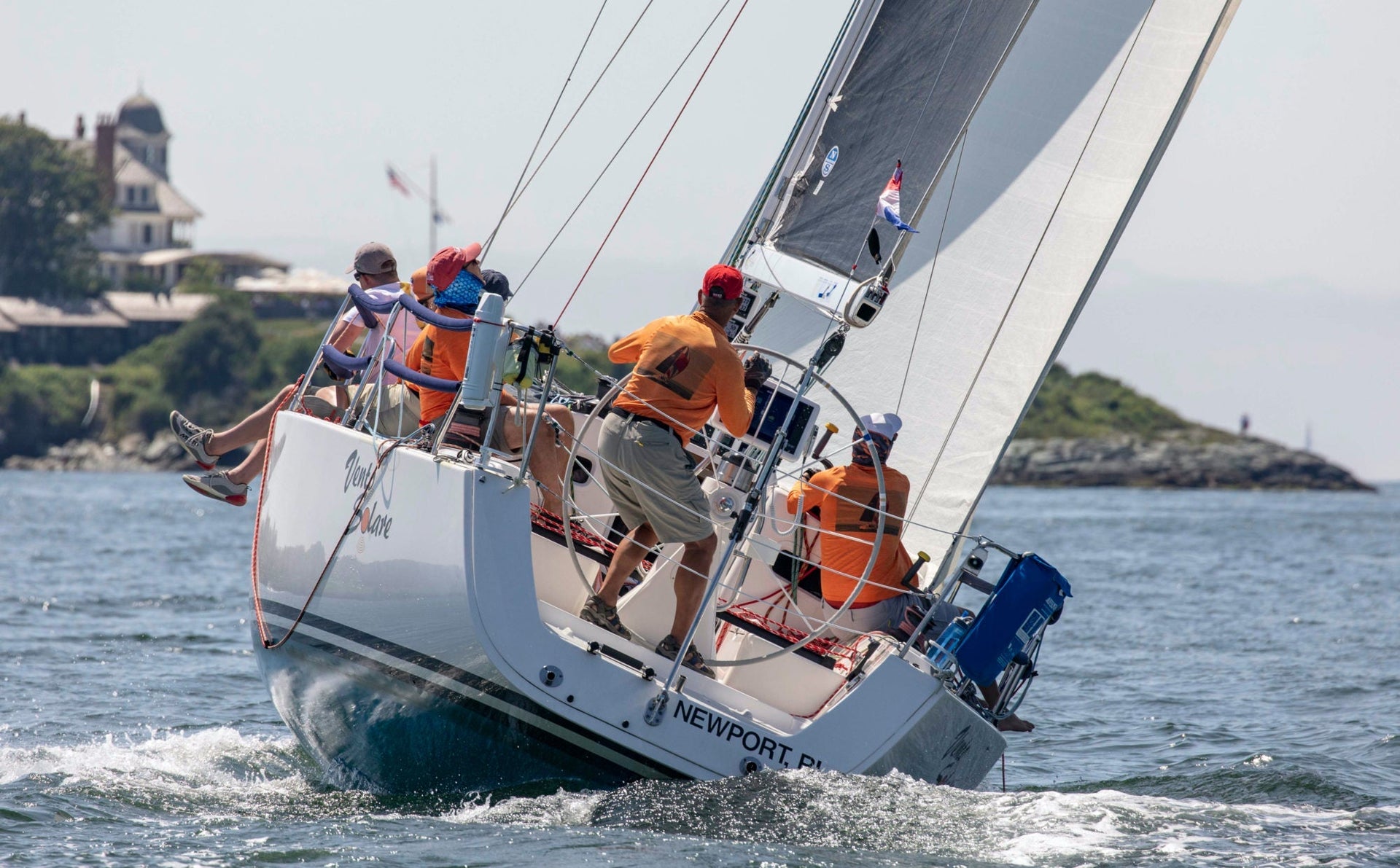
HOW TO IMPROVE YOUR TACKS
HOW TO IMPROVE YOUR TACKS
Prioritizing Your Upwind Technique Can Make Or Break Your Race Result
📸 Stephen R. Cloutier
The most important element of upwind boathandling is tacking, though every once in awhile an efficient reef or genoa change could also win you a race. Tacking seems like a minor thing, but the difference between a good tack and a poor one can be measured in boat lengths. In a race where you tack ten times, good tacks can provide the margin of victory. And in a close duel, superior tacks will allow you to break free from, or keep control of, a rival. Each crew plays a role in ensuring a good tack.
Tactician
If you have some flexibility in timing, look ahead for a smooth spot. Avoid waves, chop, and wakes coming out of the tack. Also, make sure you will be in clear air coming out of the tack—don’t tack into another boat’s bad air.
Driver
The courtesy of a preparatory hail, “Ready about,” increases the likelihood of a good tack at “Hard-a-Lee.”
A proper tack starts with a slow, smooth turn to preserve momentum and allow the boat to coast upwind. As the boat comes head to wind and speed is lost, turn more quickly to finish the tack.
In waves a faster turn is called for, as momentum will be lost more rapidly. Start the turn on the face of one wave and turn quickly as the bow pops out over the crest. Try to get the bow around so the next wave pushes the bow down on the new tack, not back onto the old tack.
During the turn the helmsman must change sides and settle into position to work the boat up to speed. Come out of the tack a few degrees low and squeeze up as speed builds. Try to focus on the gradual push of the tiller as you are flattening the boat.
Crew
Keep crew movement to a minimum, and choreograph your tacks to reduce traffic. For example, at “Ready about” it makes little sense to have the genoa trimmer come to windward to tail the new sheet while another crew member moves to leeward to release. The genoa trimmer should handle the release, and crew from the rail should tail and grind. On some boats it works to have the genoa trimmer release the jib, and then turn to take the main. Meanwhile, the main trimmer abandons the main, and trims the jib.
Ready About?
Until you are on the layline you know your next maneuver, sooner or later, will be a tack. Let’s be ready sooner.
As soon as possible after the completion of the previous tack, load the lazy jib sheet on the winch and flake the working jib sheet. At “Ready about,” the trimmer should make sure she is prepared to release and the tailer should check the new winch, take up slack on the lazy sheet, and put the winch handle in place. No one else should move. You slow the boat if you get off the rail at “Ready about,” and you also telegraph your moves, letting your competitors know you are about to tack.
Even at “Hard-a-Lee,” most of the team can sit tight. As the boat stands up, the grinder should move into position. (There is nothing to grind until after the release anyway.) The longer you hike, the faster the boat will be going into the tack.
The Release
When the genoa is backed halfway across the foredeck, ease out one arm length before spinning the remaining wraps off the winch. The sheet should be flaked in advance. Make sure it runs.
📸 Melges Performance Sailboats / Sarah Wilkinson for Beigel Sailing Media
Roll Tack
Every boat can roll tack, not just dinghies. In light and moderate winds, a roll tack uses crew weight to help steer the boat and tack the sails. Here’s how: First, heel the boat to leeward to generate weather helm and start the boat turning up into the wind. Next, as the boat passes through irons, roll weight to the old windward/new leeward side. This will help the boat through the second half of the turn and throw the sails across the boat. Finally, as the sails come over, move up to the new windward side. This hikes the boat flat, helping the boat accelerate out of the tack.
Tail and Grind
Tail the new genoa sheet hard from the moment the old one is released. The tailer should pull in long even strokes across his body. The grinder should grind full speed right from the start, even when there is no load. It is sometimes helpful to have another crew member slap the sail around the rigging and drag the clew aft.
The grinder, by spinning the winch full speed, can help the tailer bring the sail through the tough spots. By keeping the winch drum spinning, he also prevents overrides. This allows all the necessary wraps to be laid on the winch from the start of the tack, which means you don’t have to stop to add wraps once the sail loads up.
Trim out of the Tack
Trim for extra power and acceleration out of the tack. Pull the jib leads forward a few inches and don’t go to full trim right away; wait until your speed builds. If you want to adjust controls, such as the backstay, for acceleration out of the tack, do it just beforehand (or in the middle of the tack) so everyone can concentrate on building speed out of the tack.
Once the sail is nearly trimmed, the grinder can move to the rail and the tailer can trim the last few inches as the boat accelerates. The trimmer should call out the overall boat speed often so the helmsman knows when the boat is approaching full speed and when he needs to press more.
Hike
If time allows, hike immediately after you tack. Do this before you set the pole, or clear halyards, or do any housekeeping. Hike out, settle the boat, and let the driver concentrate. Wait until you are up to full speed before you start moving around. This holds true in light air as well. Even when hiking weight is not needed, movement robs speed and disrupts concentration.
📸 Zerogradinord
READ MORE
READ MORE
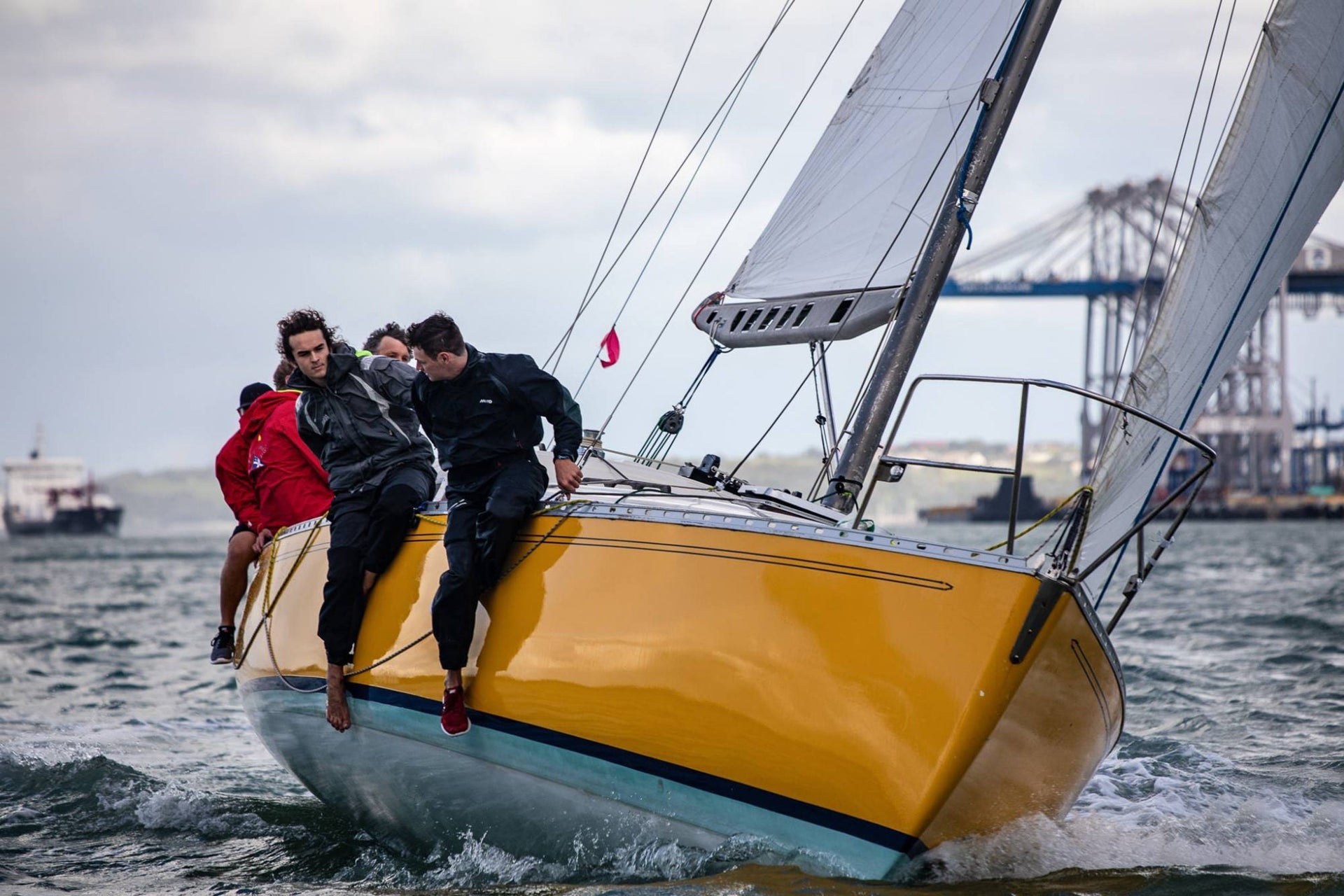
PAUL GROOM'S PSYCHE DOES IT ALL
PAUL GROOM’S PSYCHE DOES IT ALL
One Design & Doublehanded Distance Club Racing is on in New Zealand
📸 Rachel Von Zalinski / Live Sail Die
One Design Weeknight Racing
Local NZL sailor Paul Groom got into Stewart 34 racing 10 years ago and has been racing his second boat Psyche since 2016, making a name for himself as a regular at the top end of the fleet for class one-design racing. New Zealand’s Stewart 34 fleet provides highly competitive racing at the grassroots level, and members are known not just for their desire to win, but also their utmost camaraderie on and off the water.
What does Paul do to obtain the best possible boat speed? He explained; “It’s all about sail trim and backstay. On Stewarts which have a lot of sail area and loose rigs, the top of the mast falls off, de-powers, and while sail technology has drastically changed over the years, the simple and affordable products remain in the class. There’s no reason to change that.”
“Winning in this class isn’t easy, and every race is a new challenge,” Paul says. “They get up on a plane and can be an absolute handful. It’s a lot of fun. Race results are almost always determined by a matter of a few seconds,” Paul says. “It’s that close every time. After trying for quite a few seasons to get a win, it was a great feeling, and since then we’ve had a few more but it’s not easy! Apart from the crew, you need a really good #1 above all –otherwise you don’t have a chance.”
Psyche competes annually at least twice during the week on Thursday and Friday with the Royal New Zealand Yacht Squadron and in the Stewart 34 Championship Series which spans over eight race nights the summer, beginning in November. Optimum crew count is eight total, but you can get away with five. That’s not ideal Paul says when there is breeze on. Paul commented; “It’s ‘casual’ weeknight sailing, but each race is like sailing a world championship against the other Stewart’s. The trimming is fine-tuned. The crew work is exceptional. That’s what makes this class competitive, and a lot of fun to be part of.”
“Paul sails almost every race on the calendar year round and has seen amazing mileage out of his racing sails. I don’t think there is any Stewart 34 who would do more races than Paul. It is great to see his NPC Radian and Crosscut Dacron sails lasting strong over this test of time -and he’s still winning races!”
– Matt Steven, North Sails Auckland
📸 Rachel Von Zalinski / Live Sail Die
Lewmar Triple Series & Shorthanded Sailing Assoc. Of New Zealand
Paul teamed up with young rockstar Olivia Christie for some doublehanded club racing fun in the SSANZ (Shorthanded Sailing Association New Zealand). They’ve been competing in the doublehanded mixed division of the Lewmar Triple Series, which is a three-race series, with races ranging 50-100 miles long. So far the duo has completed two of three races, and have outperformed all expectations.
“Finding Olivia was key,” Paul says. “She’s an unbelievable sailor and really has a feel for the boat. This sport requires you to change your gears, plan ahead–and there’s an element of luck of course. We focus on minimizing our risks and keeping our minds open to learning. Having Olivia onboard has been a fantastic team-building experience. Her energy and interpretations make her a great teammate.”
The Lewmar 60 (60 miles) on July 4th was Groom and Christie’s debut, taking line honors and fourth on corrected time. The Lewmar 100, held just last weekend on August 1st, the duo took second place line honors, fourth on corrected time.
📸 Lewmar Triple Series / Live Sail Die / Suellen Davies
Sail Power
Paul worked closely with Andrew Wills and Matt Steven based at North Sails Auckland when it came to optimizing his sail inventory. The Stewart 34 class rules are made to keep the racing affordable, only permitting teams to compete with Dacron sails. For local club-style racing a few teams have custom sails made (code sails, asymmetrics), and have even gone as far as adding a bowsprit. Strictly one-design racing– it’s all Dacron and symmetricals.
Psyche uses North Sails NPC Radian mainsail, NPC Crosscut Dacron #1 , and an NPC Radian #2. Competing in roughly 100 races per year, Paul is able to get the most from his sails and his boat, thanks to his trusted sailmaker. Paul commented; “My older #1 genoa has about 400 races on it and is still in great shape after servicing, but the serious race sails only come out in the class championship. I have been really impressed with my sails, they are unbelievably stable.”
📸 SSANZ / Live Sail Die / Suellen Davies
Paul’s Ongoing Relationship with North Sails
Paul can’t thank his local North Sails team enough. “My experience with Matt and Willzy has been a great one, and they offer nothing but the best advice and support, which has helped me be successful out on the water.”
What keeps Paul coming back to North Sails? “My experience with sail service has been a great one. Willzy and Matt are unbelievably talented sailors. Also, the price for sails is competitive and affordable. My sails still have great shape, even with many miles on them. North’s products are made well and can be trusted.”
“The Lewmar 100 last weekend served up pretty fresh conditions with a 30 mile beat in 25-35 kts and some big wind against tide seas around the headlands. We opted for a conservative approach, which paid off in the end. The boat that beat us is the top S34 and is well sailed, but they also had a prod with a code zero, which suited the closer angles. Thing about doublehanded sailing is that if you lose someone to an injury or MOB then you’re singlehanding, and that’s a dangerous with a 1,500 sq ft of kite in breeze. I didn’t want to put Olivia in that position so we did a risk assessment before the downhill legs. For the club sailors with older boats: here’s a 60 year old class (psyche is 40!) using Dacron sails, and we finished ahead of far more modern boats in the division with laminate sails.”
Thanks for the footage 📽️ Paul Groom & Olivia Christie. Best of luck to you in the final event!
READ MORE
READ MORE
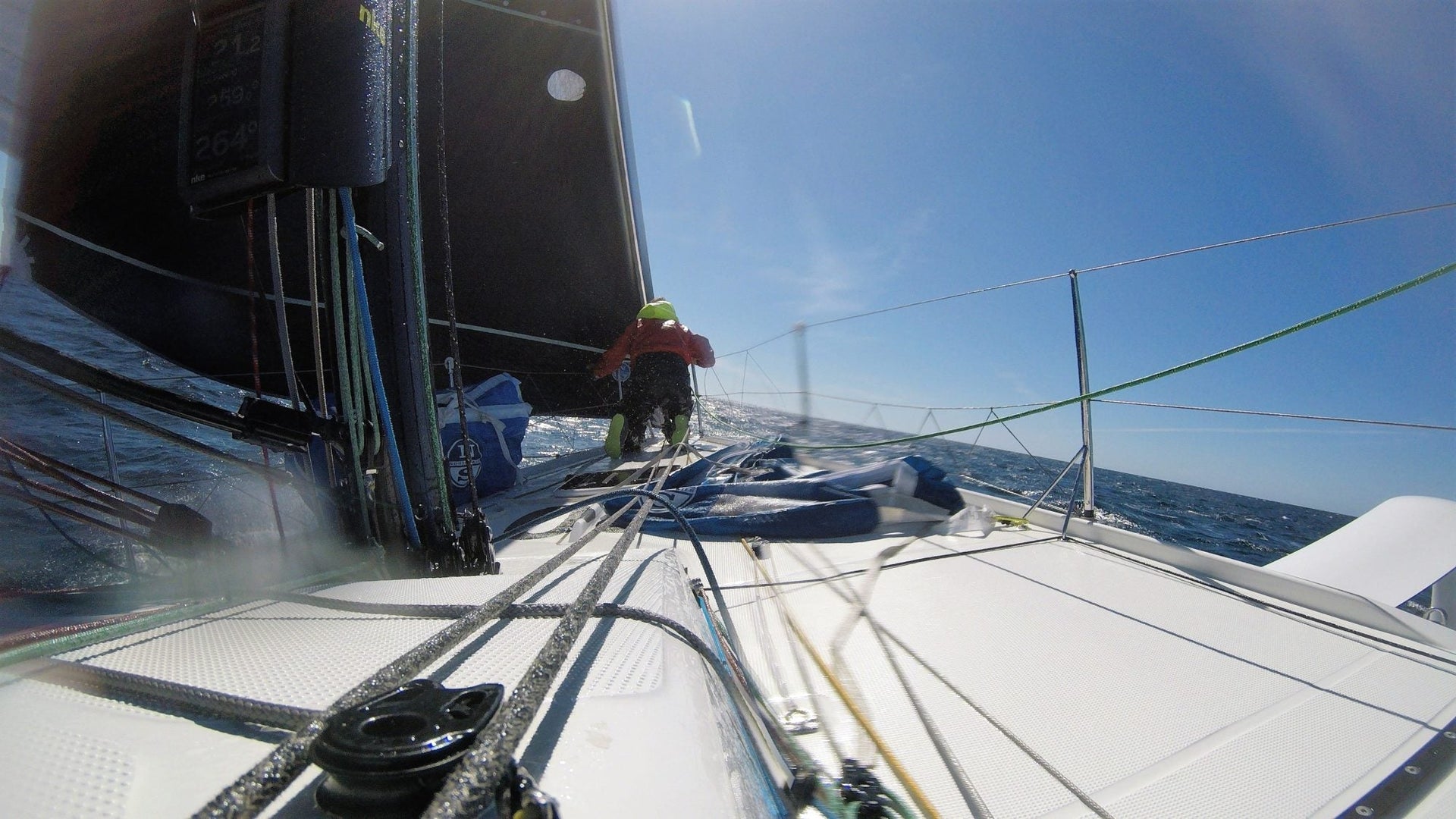
RL SAILING TEAM CHOOSES NORTH SAILS FOR FIGARO CAMPAIGN
RL SAILING TEAM CHOOSES NORTH SAILS
Sailmaker of Choice for Upcoming Doublehanded Figaro Campaign
📸 RL Sailing Team
Stepping onboard a Figaro 3 is an exciting yet daunting experience. They are offshore, foil assisted One Design race machines with no compromises. Learning to sail such a boat takes skill, time, patience and nerves of steel! That covers sailing the boat... the next challenge involves diving into the deep end and sailing it offshore, in France, in the Figaro circuit, competing against the best sailors in the world. It really is a quantum leap from what even professional sailors are used to. This is what Kenneth Rumball and Pamela Lee have lined up as they embark on their doublehanded Figaro campaign.
"With so much to learn'' Kenneth explains, "Pam and I did not have the time or resources to experiment with different sailmakers, sail design theories, build qualities or reliability issues. We needed top quality, Grand Prix sails that are capable of winning without endless hours of testing & experimenting.''
Nigel Young, Maurice ‘Prof’ O’Connell and Shane Hughes from North Sails Ireland contacted Kenneth and Pam once the RL Sailing Team doublehanded campaign was announced." North Sails were definitely the most logical sailmaker to partner with,'' Kenneth explains. "Although Nigel and team are based in Ireland, North Sails is known for having a phenomenal global network. We've also been in close contact with the North Sails team in Lorient , France who specializes in sails for the Figaro 3. We instantly felt at home and comfortable with the excellent service and customer care provided. Although we ordered our sails quite late in the season, the turn around was quicker than expected as they were ready to go almost two weeks ahead of schedule having been designed, built, and measured to the strict One Design class rules.''
"Going sailing for the first time with our North inventory was a joy that had us beaming from ear to ear. Our sails performed and fit perfectly the first time, so there was no need to revisit the loft for small snags that can so often waste time. The attention to small details, coupled with the lightweight 3Di sail material and design makes these sails really stand out from the crowd. The support and service we've received from the entire North Sails team has been fantastic. Polar files, sail selection charts, and tuning guides have been readily available to us, providing us performance gains we've been looking for. We couldn’t be happier with our decision to partner with North Sails.''
"Our sails performed and fit perfectly the first time, so there was no need to revisit the loft for small snags that can so often waste time. The attention to detail, coupled with the lightweight 3Di sail material and design makes these sails really stand out from the crowd.''
📸 RL Sailing Team
📸 RL Sailing Team
READ MORE
READ MORE
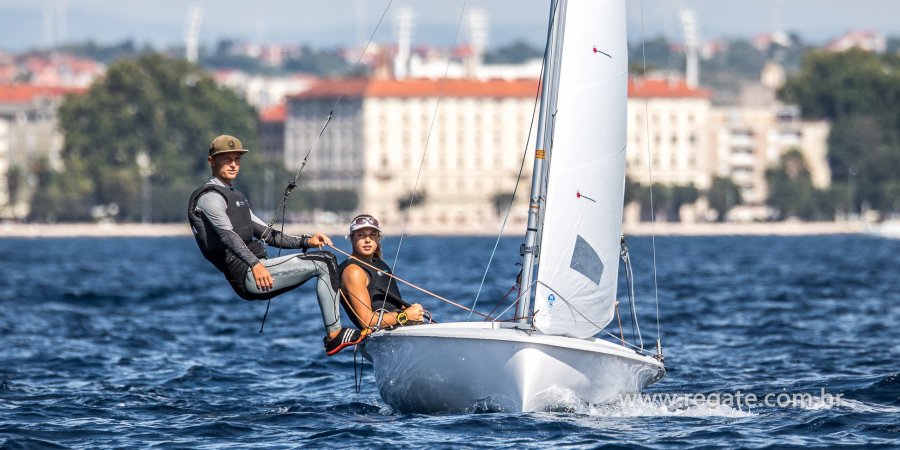
PRVENSTVO HRVATSKE U KLASAMA 420, 49ER I 49ERFX
Prvenstvo Hrvatske u klasama 420, 49er i 49erFX
JK Uskok iz Zadra bio je domaćin Prvenstva Hrvatske za klase 420, 49er i 49erFX. Karakter regate je bio otvoren i nastup na regati su iskoristili i stranci od kojih je nekima ovo bila jedna od rijetkih regata na moru ove sezone, tako da su svoje predstavnike imali Slovenija, Češka, Austrija i Njemačka.Jedrilo se tri dana, od 24. do 26. srpnja, regatno polje je bilo standardno za Zadar i jedrilo se ispred kluba, dok se jedino prvog dana regatno polje usidrilo ispred rive.Vremenski uvjeti su bili razni i stvarno se morala pokazati cijela lepeza vještina da bi se održao kontinuitet dobrih rezultata.
U petak je u najavi bio dolazak velike nevere koja se spuštala sa sjevera, pa Regatni odbor nije htio riskirati s juniorima u klasi 420, već su na more pozvani samo stariji u skifovima. Oni su startali dva puta tog dana, ali zbog promjene u smjeru vjetra prekinut je plov, korigirano regatno polje i ponovno startano. Plov je ovog puta uspješno završen, ali odmah nakon što su posljednji ušli u cilj svi su poslani natrag u klub da se sklone od nadolazećeg nevremena.
Subota je zato bila savršen dan za jedrenje. Svi su izašli na more i jedrilo se po maestralu koji je išao i do dvadesetak čvorova. Po tim uvjetima obje skupine su odjedrile po tri plova.
Jednak učinak je bio i u nedjelju, kad su odjedrena tri plova, jedino što su natjecatelji u klasi 420 bili malo nervozni na početku, pa je prvi start tog dana morao biti ponovljen dva puta!
Što se tiče klase 420, može se reći da su ovi mladići i djevojke bili glavne zvijezde ovog Prvenstva. Njih se okupilo čak 25, a od toga je hrvatskih posada bilo 13. A što se statistike tiče treba još izdvojiti da su najbrojnije posade bile čisto muške. Njih je bilo deset. Nakon njih su slijedile kompletno ženske posade, njih 8, dok je miješanih posada bilo 7. Od tih sedam posada dvije su bile s muškim kormilarom, dok ih je pet bilo s djevojkom za kormilom.
Kad se na kraju podvuče crta, može se reći da su daleko najspremniji bili Austrijanci. Čak pet posada su imali u prvih deset, a na pobjedničkom postolju dvije posade. Pobjedu su odnijeli Rosa Donner i Sebastian Slivon. Njih dvoje su pobijedili u četiri od šest jedrenja! Odbacili su samo BFD koji su zaradili u prvom nedjeljnom plovu, a skor im je pokvarilo samo treće mjesto iz petog plova. Oni su ujedno bili i najbolja posada u konkurenciji U19.
Srebrom se okitila Slovenska posada u sastavu Celestina Sabadin i Veronika Franić. Slovenske su isto bile dosta ujednačene po pitanju rezultata s tri druga mjesta, po jednom pobjedom i trećim mjestom, te petim koje su odbacile. Ma kraju su imale 10 kaznenih bodova.
A treće mjesto na postolju osvojila je posada Johanna Schmidt i Hannah Schrenzhofer. Njih dvije su imale samo bod više od Slovenski i međi ostalim, one su osvojile preostalo prvo mjesto. Ove dvije posade su ujedno bile i najstarije na regati.
Najbolja Hrvatska posada zauzela je četvrto mjesto. To su bile djevojke iz JK Uskok. Za kormilom je bila Noela Petešić, dok je flokistica bila Maris Bašić. Njih dvije su imale duplo više bodova od posade ispred njih, a suma bodova im se dobila od tri četvrta i tri peta mjesta... naravno s jednim petim odbačenim.
Druga posada na zatvorenom dijelu Prvenstva bila je iz JK Galeb, a sastavljena je od braće Fike... Tina i Ede. Njih dvojica su ujedno i najbolja posada u konkurenciji U17, a u generalnom poretku su zauzeli 6. mjesto.
Četiri mjesta iza njih finiširaju brončani na PH, a ovog puta je to bila muška posada iz JK Uskok. Riječ je o Andriji Marvinu i Josipu Kocmanu.
Rezultate koje su ostvarile posade u klasi 420 možete pronaći na ovom linku.
Što se tiče klase 49er, u njoj su bile prijavljene tri posade. Jedna iz JK Sveti Krševan, te dvije iz JK Uskok. Treba li možda reći tko je predstavljao Sv. Krševan? Naravno, riječ je o braći Fantela. Konkurencija je ovog puta ipak bila dosta slabija od njih i mladi Uskokovci su mogli dosta toga naučiti od posade koja se može pohvaliti titulom svjetskih prvaka iz 2018. godine.
Ovaj dvojac je bio apsolutno neuhvatljiv, a posljednji dan prvenstva su iskoristili i za trening boljeg upoznavanja s ulogama na jedrilici. Naime, Šime i Mihovil su se zamijenili na pozicijama, tako da je Mihovil bio za kormilom, a Šime na floku.
Razlika u rezultatu nije bilo, a za kraj treba spomenuti i da je ovo prva njihova titula prvaka Hrvatske, jer u posljednje vrijeme nije bilo ni organiziranih PH za ovu klasu.
Rezultate iz Zadra možete pronaći na ovom linku.
Treća klasa koja je jedrila u Zadru bila je 49erFX. Tu su bile prijavljene tri posade, a s njima je jedrila i posada u jedinoj hrvatskoj Nacri. Tu je regata bila dosta zanimljivija nego u inačici s visočijim jarbolom. Dvije ženske posade, jedna iz JK Uskok i druga iz Češke, može se reći da su jedrile match race. Obje su u lovu na olimpijske norme, a ovog puta su bile bolje naše djevojke... Enia Ninčević i Mihaela Zjena de Micheli Vitturi.
Pobjedu su osvojile s jednim bodom prednosti, odnosno s četiri pobjede i tri druga mjesta (jednim od njih odbačenim).
Čehinje Dominika Vodurova i Sara Tkadlecova su bodovno bile suprotne. Osvojile su tri prva i četiri druga mjesta i također odbacile jedno drugo.
Treća posada koja je jedrila u tim jedrilicama bila je sastavljena od dva mlada momka. Kormilar je bio Buba Pulek, dok je flokista Lorens Lokas.
U odnosu na starije kolegice njih dvojica su praktički početnici u klasi. Držimo im fige da ostanu uporni u svladavanju ove formule na vodi, a i ne treba sumnjati da će im to uspješno ići za rukom jer kormilareva titula prvaka Hrvatske osvojena u rujnu prošle godine sigurno daje na važnosti njihovih zajedničkih napora.
Rezultate za 49erFX možete pronaći na ovom linku.
Tjedan u kojem se jedrilo ovo PH je donio i par dobrih vijesti braći Fantela i posadi Nacre, Igoru Mareniću i Anđeli Mariji de Micheli Vitturi. Oni su saznali da su neke od važnijih regata koje su trebale biti organizirane tijekom ljeta prebačene na rujan. Jedna od njih je i regata u Kielu.
Ove novosti su naše posade dočekale s radošću jer su se svi zajedrili jedrenja na svojim razinama, a dvojcu iz Nacre odlazak u Kiel bi trebala biti i prva službena regata u ovoj klasi!
Foto galeriju posljednjeg dana ovog PH možete pronaći na ovom linku, dok je kratki video presjek tog istog dana dostupan na ovom linku.
READ MORE
READ MORE
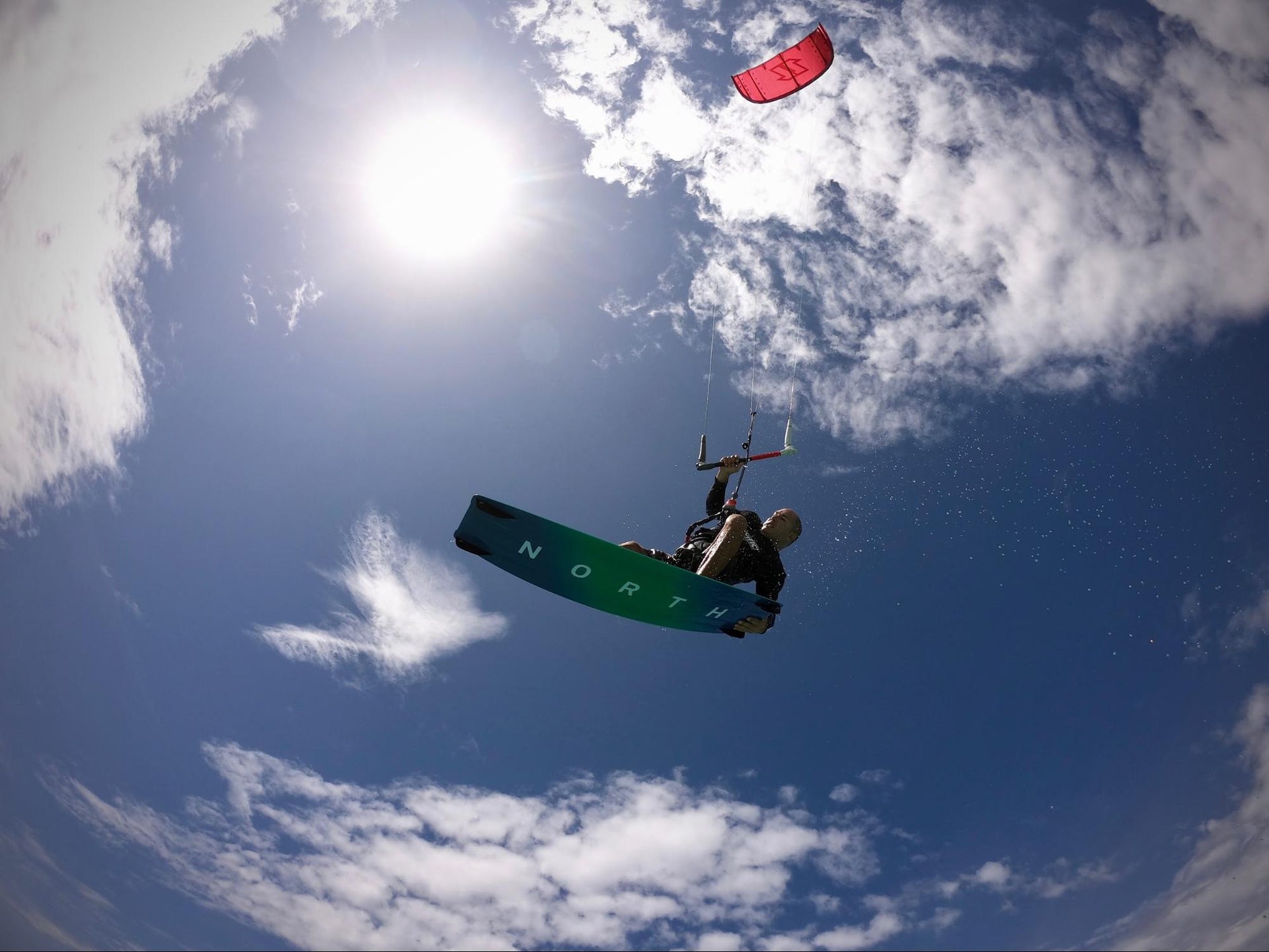
SAILING INTO CHANGE WITH RYAN LEVINSON
SAILING INTO CHANGE
Tackling Challenges One Kite Loop At A Time
Story by Ryan Levinson
When I wrote my last Waterlogs post four years ago, Nicole and I were just getting our sea legs after sailing over 10,000 nautical miles since leaving our homeport of San Diego. We explored Mexico before crossing the Pacific Ocean to reach the Marquesas Islands in French Polynesia, a 21 day crossing that was our first “blue water” passage. Now we have a lot more experience and many thousands more miles of tropical ocean water under our keels. There have been some profound changes since that last article.
If you live on a boat long enough there is a threshold you cross where life at sea becomes “normal” and land life is “different.” Sailing is no longer something you go do, it is your daily reality. If you make it that far you realize you are exactly where you are supposed to be, doing what you’re supposed to be doing. No matter how tired, wet, salty, frustrated, sunburned, or any of the other countless challenges you face from life at sea, the water is your foundation, the winds and waves define your flow. You realize that when you are at sea you are home.
Another change since my last Waterlogs post is the extent that FSH Muscular Dystrophy has robbed me of physical strength as muscles continue to atrophy throughout my body. At the time we had an incredible little sloop named Naoma. When she would heel from a gust or swell I would often end up violently smashed against various parts of the boat because I no longer have the strength to balance or to brace myself from “falling.” For a while I compensated by installing extra handholds, carefully planning my movements, and sailing more conservatively but the writing was on the wall. If we wanted to keep sailing we would have to leave our beloved boat for one that was more stable and accessible. That is what ultimately led us to buy Kiapa Nui, a NEOS/Looping 48 catamaran.
Switching from an older 38’ monohull to a much newer 48’ multihull is a huge leap in comfort and performance, especially because Kiapa Nui was custom built to be simple, light, and fast. She’s not a race boat but for a cruising cat she is well on the performance side of the spectrum. Sailing with that much speed and power is a huge change, but a fun one. Familiar passages are now hours or even sometimes days shorter. During gusts instead of finding myself smashed against a bulkhead in a heeling sloop I stand comfortably at the helm in a stable cat watching the knot meter climb solidly into the double digits. Kiapa Nui is the fastest, funnest, most comfortable wheelchair in the South Pacific!
Once the anchor is set we often break out the kites and continue the fun. Kiteboarding is sailing in three dimensions because with a kite you’re no longer restricted to the ocean’s surface. Kiteboarding is fun, easy to learn with a few lessons from a good instructor, and the gear is small enough to easily stow on a boat. You can kite almost anywhere there is wind and water. All over the world kiteboarders and sailors form like-minded tribes of people sharing a primal love of dancing with the wind across the water.
Before leaving on this voyage I had a rewarding career in ocean rescue and emergency medical services. I was a proud member of the US Sailing Team and was captain of a beautiful 120’ luxury ketch. But I was also rapidly losing muscle, a powerful reminder that we are all losing time. So I made some decisions, one thing led to another, and now I’m writing this while anchored off Mo’orea, buzzing with passion and gratitude. Each moment is a gift!
Having the courage to embrace change is not always easy, pleasant, or fun, but it is the foundation of all adventures. It is the difference between being a passive or active participant in life. We are sailors and kiteboarders, we are seekers, we are lucky because we know what moves us. Now more than ever it is clear that we can not choose every change or challenge we face in life. But we all have the freedom to choose how we respond. I’ll see you on the water!
Read more about who Ryan Levinson is and check out his Q&A with North Sails!
READ MORE
READ MORE

NORTH SAILS BY APPOINTMENT
NORTH SAILS BY APPOINTMENT
Book a Complimentary Coaching Session
Calling all Australian sailors!* Book a one-on-one, real-time coaching session with the North Sails experts who will join you by RIB and provide sail trim tips.
Let us know below when you will be sailing and we will schedule a time to meet you on the water to offer instant coaching and feedback. Whether you are a racer, cruiser, or One Design sailor, any boat should take advantage of North’s on-the-water coaching. Sign up to improve your game with us.
*Availability limited in some locations
READ MORE
READ MORE
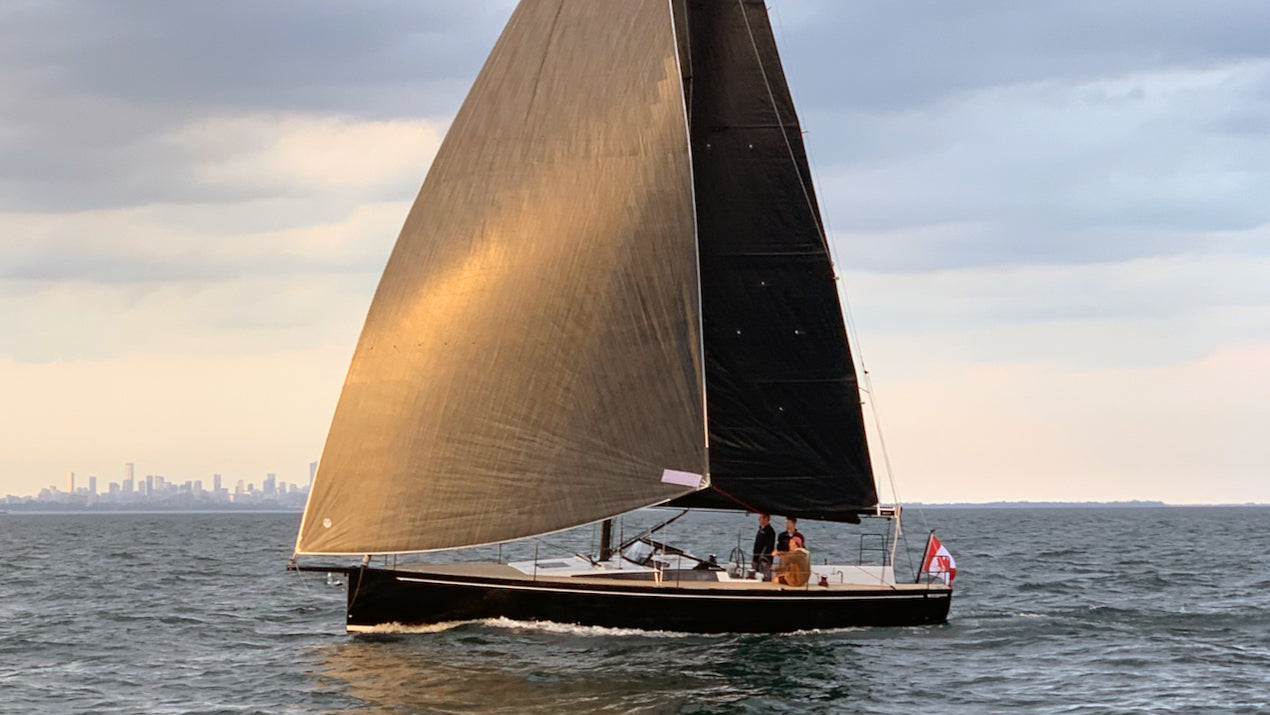
THE LATEST OBSESSION: CODE ZEROS
A Win-Win Decision Why do people love Code Zero sails? They have become a secret weapon for anyone looking to take their sailing to the next level.
READ MORE
READ MORE
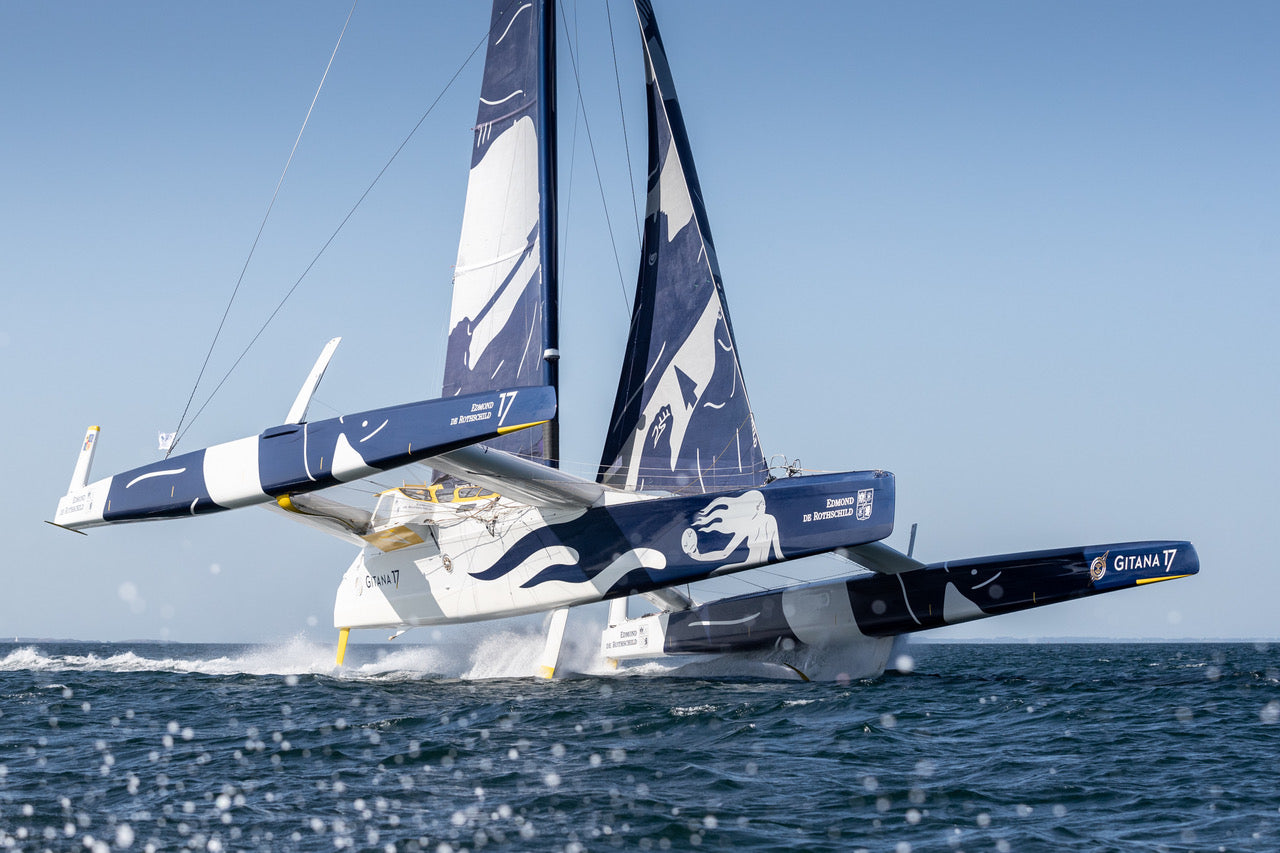
NORTH POWERED ULTIMES DOMINATE DRHEAM CUP
NORTH POWERED ULTIMES DOMINATE DRHEAM CUP
Team Gitana Leads the Drheam Cup With Aspirations of Shattering Jules Verne Record
E. Stichelbaut / polaRYSE / Gitana SA
After 750 miles, Maxi Edmond de Rothschild screamed across the finish line in full flight off La Trinité-Sur-Mer in Brittany at 35 knots on Tuesday. The 32-meter Ultime trimaran took line honors after 21 hours, 30 minutes, and 33 seconds of racing. They finished 2 hours ahead of their nearest competitor, Sodebo and third place Actual Leader. All three top finishing Ultimes are North Sails powered teams.
Thierry Martinez / Drheam Cup
Franck Cammas said in a press release, “It was a very fine race and it was intense, which is just the way we like it. There were some tactical phases, other periods which were just a drag race and a lot of reaching at the end, as was the case during the second night when we were hunting down the cardinal mark off Rochebonne, which was great because we didn’t have conditions as quick as that in last year’s Fastnet. It was quite good being able to push the boat in these conditions. It’s never easy to permanently remain close to 40 knots like we did last night. It was a great finish. We learned a great deal from this race. It was a technical course in a small space because the English Channel and the Irish Sea aren’t very big at the end of the day given the size of our boats. That means we can run through all the different maneuvers you can do on an Ultime.”
The Drheam Cup served as an opportunity for Maxi Edmond de Rothschild to prepare for their upcoming Jules Verne Trophy record attempt. With the number of opportunities to line up against high-caliber competition dwindled as a result of Coronavirus, the team pushed to make sure they are prepared to race around the world.
Charles Caudrelier explains: “It was important to be here as you can count the number of opportunities to go racing on the fingers of one hand! This is especially true in conditions like those we encountered last night, which enable us to drive the boat at her full potential. We’re delighted with the modifications we made to the Maxi over the course of the winter. From the outside, the boat looks the same, because aside from the fairly obvious aerodynamic additions, like on the beams, you really need sharp eyes. However, the team has done a really good refit and today we are able to see the fruits of our labour. I believe we have further optimised the platform and the level of performance we’ve achieved since her relaunch has made it all worthwhile. The race format didn’t necessarily lend itself to actually training for the Jules Verne, but it gave us a chance to head offshore again and rediscover the mechanics of sailing the boat… The Drheam Cup has launched our Jules Verne Trophy record campaign!”
E. Stichelbaut / polaRYSE / Gitana SA
READ MORE
READ MORE
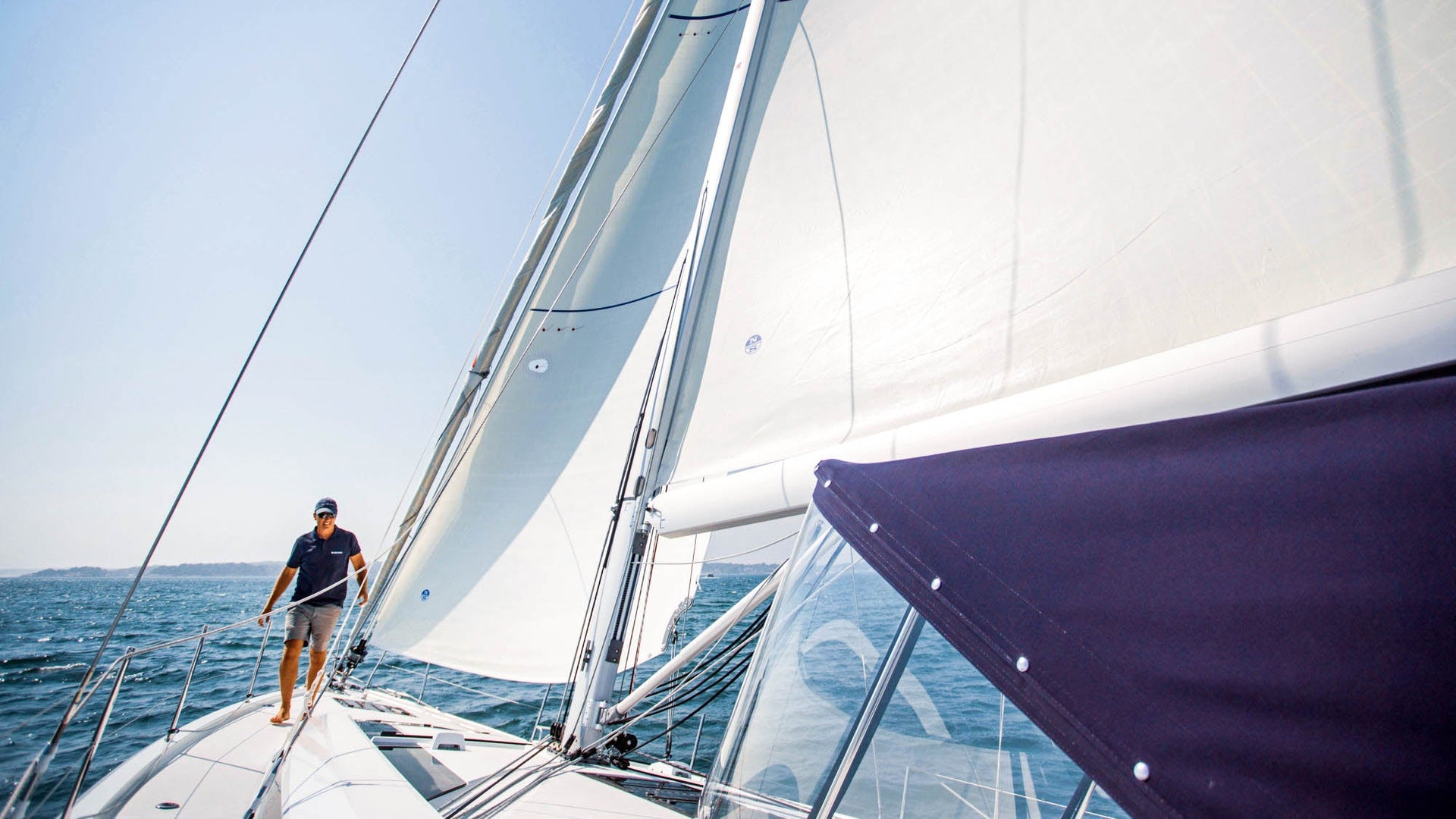
BUILDING YOUR CRUISING CHECKLIST
How To Prepare, What To Check For And What To Pack
Any trip can be exciting and overwhelming. The prospect of unplugging for a few days to relax and recharge is more than appealing for most, but the flip side of course is packing, preparing and getting yourself ready to go, which can cause a bit of stress. When it comes to a cruising trip, there are some key things to remember before departing the dock to assure you are ready for anything. Hear from our experts in Toronto on how you can get ready to enjoy every moment on your next cruising getaway.
Let’s start with your sails. Make sure to look them over, not the night before or day you’re leaving the dock. Aim to do this at least a week before you plan on heading out. This way you can allow for enough time for repairs and normal maintenance to be done without everyone getting stressed in the final moments. When looking over your sails, make sure to look for holes, fraying threads, batten pockets coming apart and any broken battens. Hearing the “thunk” as your batten goes overboard is never fun! A 10 Point Inspection from our certified service team is a good idea before leaving the dock. Our team will replace telltales, cut & clean loose threads, review UV, check for chafing, luff hardware, and check your spinnaker. Bringing extra repair tape or material is also an option if it helps set your mind at ease for your trip. Your loft can help you assemble a sail care kit that you can keep onboard so that you can make small repairs until you can get to the loft. In addition to checking your sails, you’ll want to give the boat a good once over. Check all running rigging including lifelines, stanchions, halyards and deck hardware. Don’t forget to check equipment down below. Review your electronics, radio, fridge and stove. Are your batteries charged? Is the VHF charged? Do you have extra fuses handy? Have you loaded maps into your GPS? Is your fuel sufficient in case of emergency? Does your motor need any maintenance? Ensuring you have enough life jackets for everyone that will be onboard is also essential. Your throwable, anchor line, anchor, and all safety equipment should be stored where you know you can reach it in case of emergency. Safety is no accident!
It’s time to pack. Something that does not spark joy for everyone however for me, I thrive. The trick to packing for a cruising trip is to keep in mind the following:
Multipurpose items. Keep in mind comfort, and things you can bring that can help in multiple situations. Bags that can be used for food, then can be used for disposing/ storing trash until you make landfall and can reach a dumpster is an example.
Gear that is lightweight. If you’re going in the summertime, you may think you don't need your wet-weather gear, but most would agree–if you don't have it with you, you will absolutely need it! Never leave your foulies at home. Whether you think it won’t rain or not, it’s better to have your gear with you than wishing you had it while being soaking wet. Even in the summertime, when a storm is brewing the temperature drops and if you are stuck on deck helping out or doing a sail change, or just hunkering down, you may get chilly!
Provisioning is key. Sorting out a menu ahead of time and what you have enough room for will help you avoid missing key items that can really put a damper on your next boat-cooked meal. Each person onboard requires one set of eating utensils, which you wash after use each time so its ready for the next meal. You should also plan for a few extra days in case you get caught in a storm or if you are sitting with no wind for longer than expected. Snacks are always a good idea, in pre-made baggies so that you can grab something quick if you are unable to comfortably cook a meal down below.
Lastly, you’ll want to check the weather before leaving the dock. It may sound like a no brainer however you’d be surprised by how many people do not do this. It’s a good idea to check the radar to see what is heading your way once you leave the dock. Looking to upgrade your cruising sails? Explore our tips on what to look for in a good sail and Tom Davis’ advice for best cruising sail options. For more information on how to make your cruise a fun and easy one, read more in our Cruising Tool Kit.
READ MORE
READ MORE

CUSTOM SPOTLIGHT: NORM CHURCH
CUSTOMER SPOTLIGHT: NORM CHURCH
Raising The Bar With North Sails
📸 Tim Fuhrmann
Norm Church and his Morgan 41 Obsession have been a Florida northeast coast fixture since 1971, the year the boat was purchased. The keel/centerboard model was the most successful of the Charley Morgan designs; she is ideally configured for the shallow waters of the Florida/Bahamas cruising and racing areas. Obsession has been consistently upgraded and maintained over the last four decades by Norm, often doing the work himself to the highest of standards. According to Norm’s longtime North Sails sailmaker, Lin Robson, “I’ve known Norm for many years, his upbeat and colorful personality has always been a bright spot during phone calls and loft visits. Always seeking to raise the bar, always an open-minded student during decades of experience, Norm and his team have won many races over the years. Most recently, the team won PHRF B, and were third overall in the Ft.Lauderdale to Key West race.” Obsession is an interesting study as well, like so many unheralded older boats across the country, she does not represent the latest design, but she is given new life after each of the sail and other successful upgrades over the years. Speaking of sails, Obsession is a quite diverse showpiece for North Sails, and Church has been an early adopter for North’s time, new technologies. The inventory includes a Radian main and #2 genoa, a 3Di 155%, S2 and A3 spinnakers, as well as a suit of NORDAC heavy weather sails. Lin Robson observes that, “The A3 is an interesting story, locally at least flying asymmetrical sails off a spinnaker pole is a relatively new sight the past couple seasons, but we built an A3 to be flown from the pole just above the pulpit years ago, it has been a weapon on those reaching courses for which Obsession loves so well.” Congratulations to Norm and his team. North Sails Gulf Coast looks forward to a lot more enjoyable years on the water watching Obsession succeed on the race course!
📸 Tim Fuhrmann
📸 Tim Fuhrmann
READ MORE
READ MORE
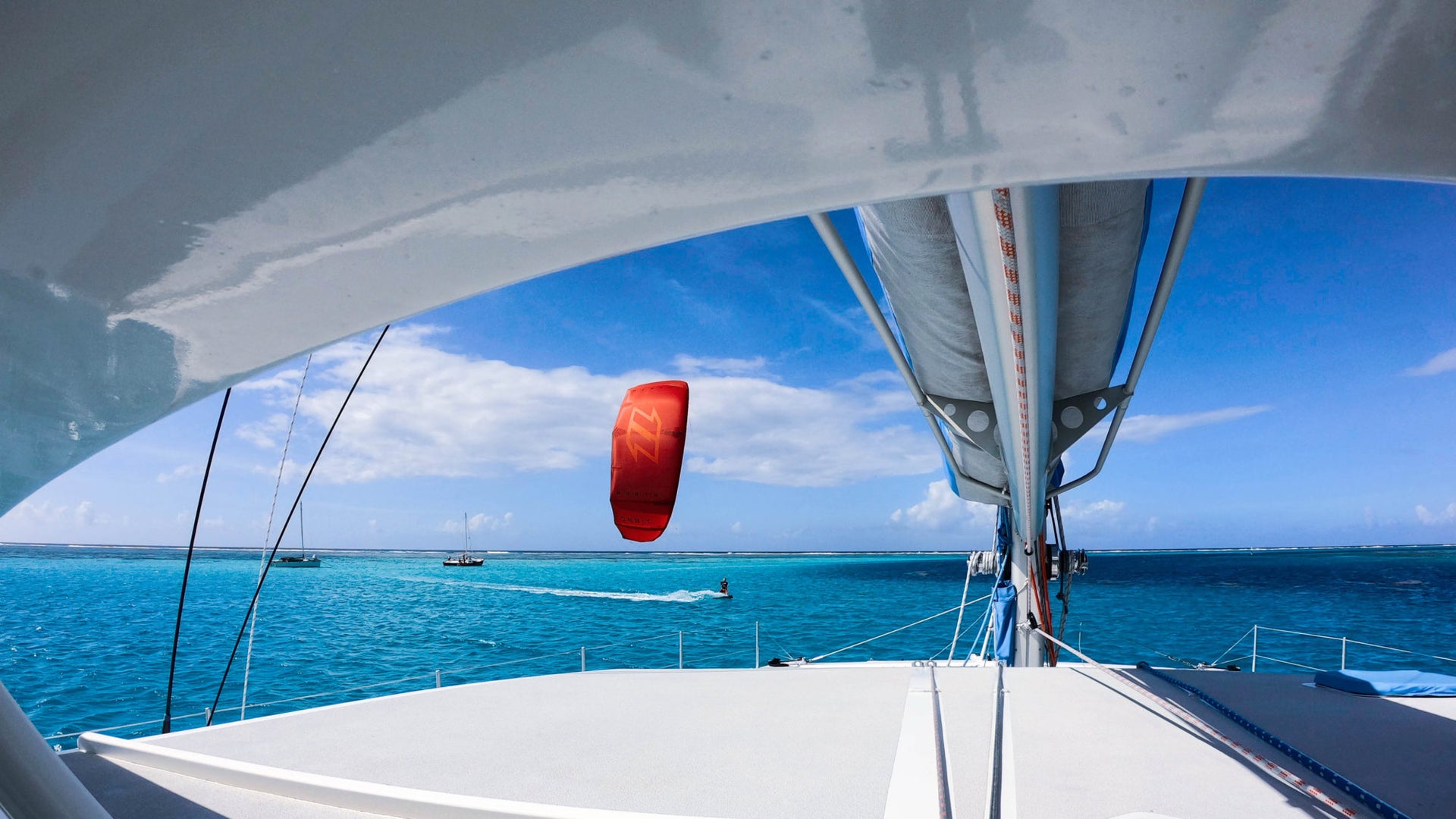
FIVE WAYS KITEBOARDING CAN IMPROVE YOUR SAILING
FIVE WAYS KITEBOARDING CAN IMPROVE YOUR SAILING
Similar Concepts Teach The Best of Both Worlds
Story by Ryan Levinson
For those who don’t know, I have a genetic disease called FSHD that causes my muscles throughout my body to weaken continuously. When I was diagnosed, there was nothing available to read except depressing stuff like clinical descriptions of symptoms, so I’ve always strived to be a public example of one possible approach to living with the disease. Kiteboarding empowers me to move and express myself with a freedom far beyond anything else possible given the effects of my disease. I once described it as feeling “like a dance across water and through the air to the rhythm set by the waves!” It’s hard to explain how much that means to someone like me whose life has always been very physical and based around my relationship with the ocean. As my disease progressed, I lost the ability to paddle a surfboard, but with a kite, I can ride waves. It’s now getting hard to walk, but with a kite, I can fly!
It is no coincidence that many of the best sailors in the world are kiteboarders. Both have a lot in common, but did you know that kiteboarding can also improve your sailing skills? Here are five ways kiteboarding can make you a better sailor:
It’s dinghy sailing without the dinghy
There is a wise saying, “To get better at sailing big boats, sail small boats!” Small boats offer a more direct feel for the forces involved with sailing. Kiteboarding takes this a step further by enabling you to literally experience sailing from the perspective of a boat’s mast. You develop an understanding of the interplay between the wind, water, and boat that usually takes much longer to gain through sailing alone. Kiteboarding is especially effective at helping you develop a comprehensive understanding of apparent wind, an essential skill for sailing well!
Fit is fast!
If you want to sail fast or far you will benefit from being fit. Kiteboarding provides a fun full-body workout to build the fitness you need to sail well. While kiting you wear a comfortable “harness” that allows you to control the pull of the kite with your entire body. This makes the kite’s pull easily manageable and provides the added benefit of strengthening key muscles used in sailing, especially your legs and “core.” Kiteboarding also builds aerobic endurance, flexibility, and coordination. It is a good idea to check with your doctor before engaging in any new form of exercise but don’t let age or physical ability serve as excuses for not getting started with kiteboarding. My 85 year old father in law took his first lesson this past winter and I’m in my 6th consecutive year of sailing full-time despite losing much of my strength due to a genetic muscle disorder. Kiteboarding plays a key role in helping me maintain the fitness I need to keep going on the water, imagine what it can do for you!
Kiteboarding is a crew factory
Do you need good crew for an upcoming regatta or passage? You have a great chance of finding them through kiteboarding. Even kiters who have never been on a sailboat can usually apply their understanding of wind, comfort in the water, and general level of athleticism to quickly become solid crew. Kiteboarder’s and sailor’s shared passion for harnessing the wind to move through water is a connection that often forms the foundation for lasting friendships on and off the water.
Sailing more makes you a better sailor
The more time you spend sailing the better you will be at it. But even the smallest dinghy can be a hassle to get rigged and ready, not to mention the challenge of just getting it to the water in the first place. Big boats are orders of magnitude more complex (and expensive) than dinghies! Kiteboarding gear is lightweight, portable, and a cost effective way to get your sailing fix. You can easily fit a complete set of kiteboarding gear in the trunk of your car (or cabinet on your boat) and get on the water quickly with little effort. Kiteboarding makes it possible for you to sail just about anywhere there is wind and water, even if it’s frozen (snow kiting is incredibly fun). Kiteboarding will greatly increase the time you spend zipping across the water developing skills and fitness that benefit your sailing.
The catch
Unfortunately there is a downside… Kiteboarding is an easily accessible way to feed your wind addiction which enables you to get a quick fix anytime the wind is up and you want to get on the water. The fitness, knowledge, and skills you will gain directly benefits your sailing thus making it even more fun and rewarding. It’s a viscous cycle of fun and progress that will keep you smiling on and off the water but if you’re not careful you could end up kiting between races or spending years of your life exploring the oceans on a boat full of kiteboarding gear, in search of steady wind, perfect waves, and endless sailing adventures…
How to start
The best way to learn how to kiteboard is to take a lesson from a qualified instructor. The learning curve is usually surprisingly quick and safe with good instruction but it is definitely dangerous (and expensive) without. Looking to get into kiting with North? Find your nearest instructor here.
Want to know more about Ryan? Read more in the Q +A with North Sails.
READ MORE
READ MORE
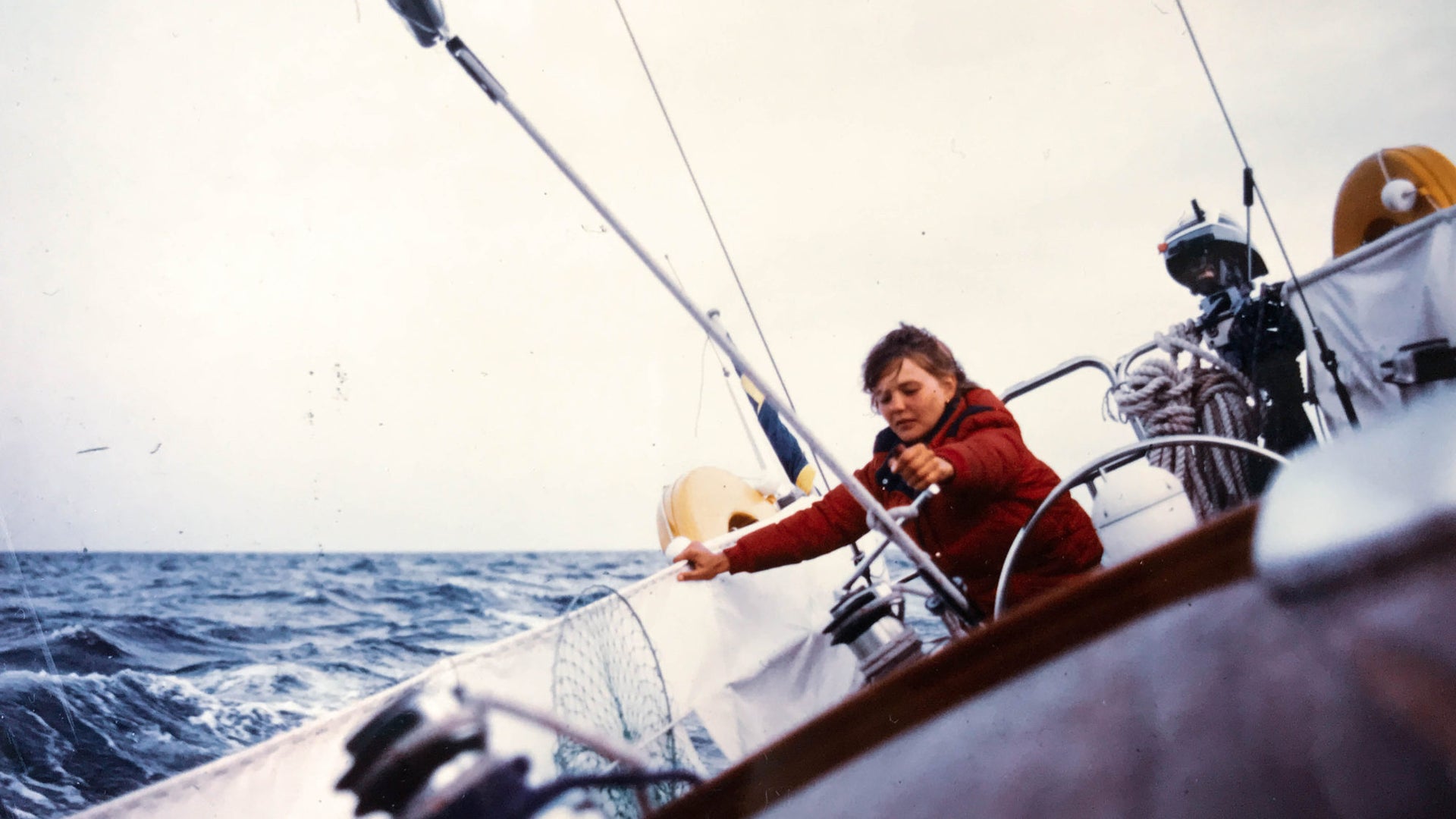
ARGO PART 2: SETTING OFF
THE STORY OF ARGO: PART II
The Story of Opal 46, Argo, and the Tradition Surrounding Her Continues
After years of sailing with his father on board his beloved schooner, Argo, based in Sweden, John Ingvar Ravelius has taken part ownership of the boat, alongside his brother and his father and has been updating and refitting her with the dream to create memories with his young daughter and pass the tradition along. Ravelius shares the second chapter of his several part series, about how a sailboat, and the work that goes along with it, is bringing three generations together. Read The Story of Argo: Part I here.
Building Confidence and Preparing for the trip to Kiel
After racing Argo for two summers in the archipelago of Stockholm, Ingvar was feeling confident at her helm and closer to his dream of sailing around the world. Tried and tested in local waters, she needed to be prepared for a long journey.
Ingvar had plans to sail away with a close friend with no destination set, only to sail south and see where the winds brought them. In 1983, before Ingvar set out, he met my mother, Leena, she was 25 years old and had no sailing experience and never even been on a sailing boat.
His plans changed, and my father asked my mom to sail away with him. She said yes and Ingvar took the leap, selling everything he didn’t need on Argo including his house in Sollentuna where he built Argo and they set out one afternoon from the harbor in Stockholm city with dreams of warmer climates and no plans to return.
Their journey started and they went through the Kiel channel in Germany and onto the English channel. My mother kept a journal.
August 21 – 1984 – Biscaya Bay
My mother wrote, “The wind was getting harder and harder and the rain was feeling like sharp needles in our faces, we had reduced the sails a lot and had a speed of 6 knots, I could hear the wind like a scream. The night was so dark, I could not see one star”.
A few days later, “the speedometer showed 6 knots, as we were sailing through the water. It was around 6 nautical miles to shore when all of a sudden the speedometer showed 0 knots. We wondered if it was broken? It was still feeling like 6 knots and we had the wind in our sails. Argo was stuck in a fishing net. We started to think about what we should do, neither of us wanted to dive down in the cold water with a big fishing net underneath the boat and cut it loose. Ingvar and I waited and didn’t know what to do when we saw a fishing boat pass by around 500m away heading to shore. We started to wave at them and they saw us and changed course heading to us. Luckily they wanted to help us and sent over a stick with a knife on one end. Ingvar started to cut the nylon fishing net but with no success. Finally, one of the fishermen came over to Argo and sharpened the knife and cut us loose.”
They realized that the net had damaged Argo’s rudder, the engine would start, but they had no rudder movement. Finally, after working the rudder back and forth, some of the net broke away and they could keep underway.
But when they started to move again they heard a weird banging sound and was afraid that the propeller was loose. Later, they discovered that the fishing nets floating mechanism was plastic footballs attached to the fishing net. The weird sound came from the balls banging against the hull on each side of the rudder.
Later in the evening, they reached La Coruna Yacht club and people on a French boat were yelling and pointed out that they had something stuck on Argo.
Leena and Ingvar yelled back “Yes, we know!” smiled and waving back a little bit ashamed. They saved these footballs for many years as a memory. And years later the red ball would be the first football I kicked in my life. After spending time in Biscaya bay they decided to sail into the Mediterranean sea, a family friend invited the couple to visit them at a hotel they owned in Ibiza.
When they passed Gibraltar and into the Mediterranean sea they did not know that Argo would stay there for the next 5 years, Ingvar and Leena and their two children would be born there.
Quotation from my Mothers book on May 10, 1984
On October 5th, 1984, Leena wrote, “the sun was shining behind the mighty Rock of Gibraltar when we passed the red and white lighthouse of Europa Point and had a course set for Puerto Banùs. We sailed into the Jose Banús Marina at an average speed of 6 knots with the wind from the side, no high waves and it felt like we were flying over the water.”
Stay tuned for part 3 to read about how my parents managed a newborn while sailing around in the Mediterranean sea!
READ MORE
READ MORE
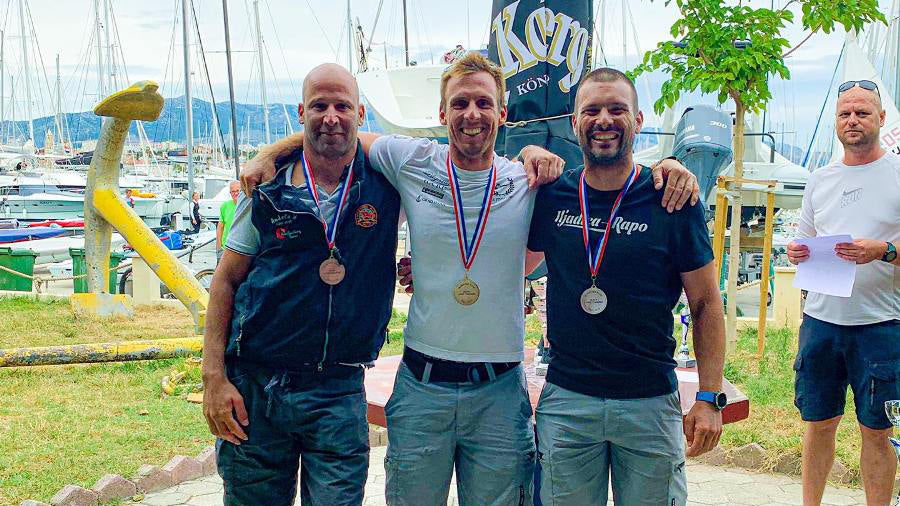
NAKON 8 GODINA IMAMO NOVOG PRVAKA HRVATSKE U STANDARDU
Nakon 8 godina imamo novog prvaka Hrvatske u Standardu
FOTO: LOVRE PERHAT
Osam godina za redom je Tonči Stipanović odnosio titulu prvaka Hrvatske u klasi Laser Standard, a ove godine njegovu poziciju je preuzeo Filip Jurišić! A da bi fešta u JK Mornara bila na najjače pobrinuli su se i najmlađi laseraši koji su na svom Prvenstvu Hrvatske u klasi Laser 4.7 osvojili cijelu hrpu medalja i naslova!
Od srijede 15. pa do petka 17. JK Mornar bio je domaćin skupini od šezdeset troje jedriličara i jedriličarki svih dobnih uzrasta koji su se okupili da zajedre za prestižne titule prvaka Hrvatske. Mlađi naraštaj je jedrio u Laseru 4.7, dok su stariji prekaljeni mladići, jedrili u inačici Laser Standard.
Krenimo prvo od "odraslih". U njihovoj konkurenciji izrazit naglasak je bio na status "otvorenog" PH. Od 26 jedriličara njih 15 je bilo s CRO jedrima, dok ih je jedanaestorica jedrilo pod nacionalnim oznakama raznih Europskih zemalja. Među njima svakako treba izdvojiti već praktički domaće Pavlosa Kontidesa, braću Vadnai, Liama orela, a ovog puta su stigla i dva vrlo kvalitetna Švicarca.
Standardi su odjedrili 6 jedrenja a apsolutnu nadmoć je od samog početka pokazivao Pavlos Kontides. Cipranin je osvojio čak tri prva mjesta, a najlošiji je bio u drugom plovu kad je završio na 5. mjestu. Konačni zbroj mu je dao 9 bodova, što je bilo za čak 4 boda manje od drugoplasiranog, najboljeg hrvatskog jedriličara prvenstva Filipa Jurišića.
Filip je uglavnom jedrio u blizini vrha i jedino nije bio "u regati" u prvom plovu kad je ušao 11. Sve nakon tog je išlo samo uzlaznom putanjom ili u samom vrhu, a kulminacija je bila u posljednjem plovu koji je završio pobjedom.l
Svega je bilo... prvi dan je bio lagani vjetar, drugi dan je bilo jako... muške, duge regate, maestrala 15-20 čvorova... a danas je bilo 15 čvorova tramuntane s kraja. Bila je vrhunska konkurencija, ekipa koja inače ovdje trenira ali došla su i dva švicarca, vrhunska jedriličara, jedan Slovenac... Pavlos i Mađari su naši... A što se mene tiče moram reći da nisam bio najzadovoljniji prvog dana. Drugi dan sam bio dosta bolji, a danas sam pobijedio u zadnjem plovu i generalno sam vrlo zadovoljan jer sve ovo je bilo u procesu priprema.Tako da nije bila neka ključna regata za koju sam se baš posebno spremao, tako da je tu bilo stvari za koje znam da bi moglo biti puno bolje i za koje znam da ih moram popraviti. Mislim, nije to bio neki hendikep, ali stvari za napredovanje i stvarno mi je drago što sam osvojio ovu titulu, pogotovo što je ona prekid osmogodišnjeg Tončijevog niza.
Filip Jurišić, Laser Standard - JK Mornar
Što se tiče trećeg mjesta u apsolutnom poretku, pripadajuća medalja otišla je u ruke mlađeg od braće Vadnai koji je bio samo bod iza Filipa, ali poprilično velikih sedam bodova ispred drugoplasiranog u zatvorenom dijelu prvenstva, a četveroplasiranog u apsolutnom poretku, do sada nedodirljivog Tonča Stipanovića.
Zatim ponovno slijedi preskok od dva mjesta u koje su se ugurali predstavnici Mađarske i Švicarske, pa se na sedmom mjestu našao trećeplasirani u nacionalnom poretku, inače spličanin sa španjolskom adresom i šibenskom registracijom, Milan Vujasinović. On je inače bio drugi najstariji natjecatelj na regati i sa svojih 40 godina starosti osvojio je i 40 bodova. Definitivno je pokazao da u njegovom slučaju godine ne znače previše i da mladi lavovi koji dolaze još uvijek ne mogu računati da će tek tako proglisirati pored njega.
A spomenute mlade lavove u rezultatima se može pronaći od 9. mjesta pa dalje. Uglavnom je riječ o momcima koji su u Standard ušli u proteklih par godina i ako žele napredovati u ovoj klasi imaju stvarno mnogo rada ispred sebe, a kako trenutno stvari stoje najbrojnije predstavnike u klasi imaju je šibenski JK Val koji je uz Vujasinovića brojio još tri predstavnika koji su svi bili u U21 kategoriji, a najbolje plasiran od njih bio je Marko Smolić na 17. mjestu i četveroplasirani u svojoj dobnoj skupini. Inače, u kategoriji U21 najbolji je bio još jedan član JK Mornar, Božidar Golubić. On je regatu završio na 11. mjestu s bodom prednosti ispred Liama Orela, slovenskog jedriličara koji se iz Finna prebacio u Standard zbog Pariza.
Božo je inače najbolje plasmane ostavrio prvog dana po laganijim uvjetima, dok je za dobar plasman po vjetrovitim uvjetima potrebno još rada. Preostale dvije medalje na hrvatskoj ljestvici uzeli su Bruno Gašpić iz JK Split na 14. mjestu ukupno i Roko Stipanović iz YC Croatia koji je završio na 16. mjestu u generalnom plasmanu.
Za razliku od starijih kolega, najmlađih laseraša je bilo mnogo više, čak 37 i od toga samo jedan sa stranom registracijskom oznakom, ali ipak dovoljno da i ovo prvenstvo dobije status "otvorenog", a kad se u obzir uzmu sve dobne i spolne kategorije na kraju je u petak podijeljeno 8 kompleta medalja!
8 kompleta bi značilo 24 medalje, a od tih 24 čak 13 ih je otišlo oko vrata predstavnika kluba domaćina, zato se kao najbolji sugovornik bezpogovorno nametnuo jedan od najzaslužnijih za ovu žetvu, trener omladinskog pogona JK Mornar, Toma Višić:
Mogu reći da smo stvarno naporno trenirali, a posebno ih moram pohvaliti da su oni kao ekipa apsolutno ludilo i da dolaze s guštom na trening! S ovakvim pristupom im stvarno uspjeha neće nedostajati. Radimo puno i kvalitetno i što je najvažnije imamo izvrsnu podršku kluba u svakom pogledu, a pogotovo po količini ljudi koje možemo pitati za savjet. Čim nekom nešto treba stvarno imam koga pitati za savjet... od Joze Jakelića, Mate Arapova, Tonča Stipanovića, Filipa Jurišića, Luke Radelića... to su stvarno vrhunski ljudi koji mi pomažu sa svojim savjetima, još što je tu i Saša Jocić kao vrhunski stručnjak koji radi na kondicijskoj pripremi svih klupskih uzrasta. U ovom trijumfu jedinu sjenu mi je bacio Lovre Perhat koji je doveo jednog Austrijanca koji je na kraju bio bolji od moje ekipe. Žao mi je što nismo još i njega pobijedili, ali ekipa mi je bila koncentrirana na međusobne dvoboje zbog statusa regate, pa im je malo pobjegao ispod radara.
Toma Višić, trener - JK Mornar
FOTO: TOMA VIŠIĆ
Spomenuti Austrijanac, Toni Messeritsch, bivao je sve bolji kako je regata odmicala kraju. U pet plovova, koliko su odjedrili Laseri 4.7, pobijedio je u posljednja dva, a najlošiji plasman mu je bio u prvom plovu.
Bodovno najbliža bila mu je članica JK Mornar, Petra Marendić. Ona je imala dijametralno suprotan razvoj regate od Tonija. Pobijedila je u prva dva plova, a kako je regata odmicala išli su i nešto lošiji rezultati, a odbacila je plasman petog plova. U svakom slučaju napravila je solidna tri boda razlike u odnosu na trećeplasiranog u generalnom poretku, klupskog kolegu, Maxa Gjideru. On je pobijedio u trećem plovu i time osigurao medalju na postolju otvorenog dijela Prvenstva, jer je imao jednak broj bodova kao četveroplasirani Roni Bobovnik iz YC Zagreb.
Preostale dvije djevojke iz top 3 apsolutnog poretka skupile su bodova da završe odmah nakon Ronija, na 5. i 6. mjestu. Riječ je o Tei Peteh iz JK Uljanik i još jednoj Mornarevki, Heleni Jakšić.
Nabrajanje svih titula i naslova osvojenih u Splitu ovog tjedna bio bi težak posao, ali zato su organizatori to pripremili na vrlo organiziran način, pa uz službene rezultate koje možete pronaći na ovom linku, možete pročitati i popis svih slavodobitnika na ovom linku.
READ MORE
READ MORE
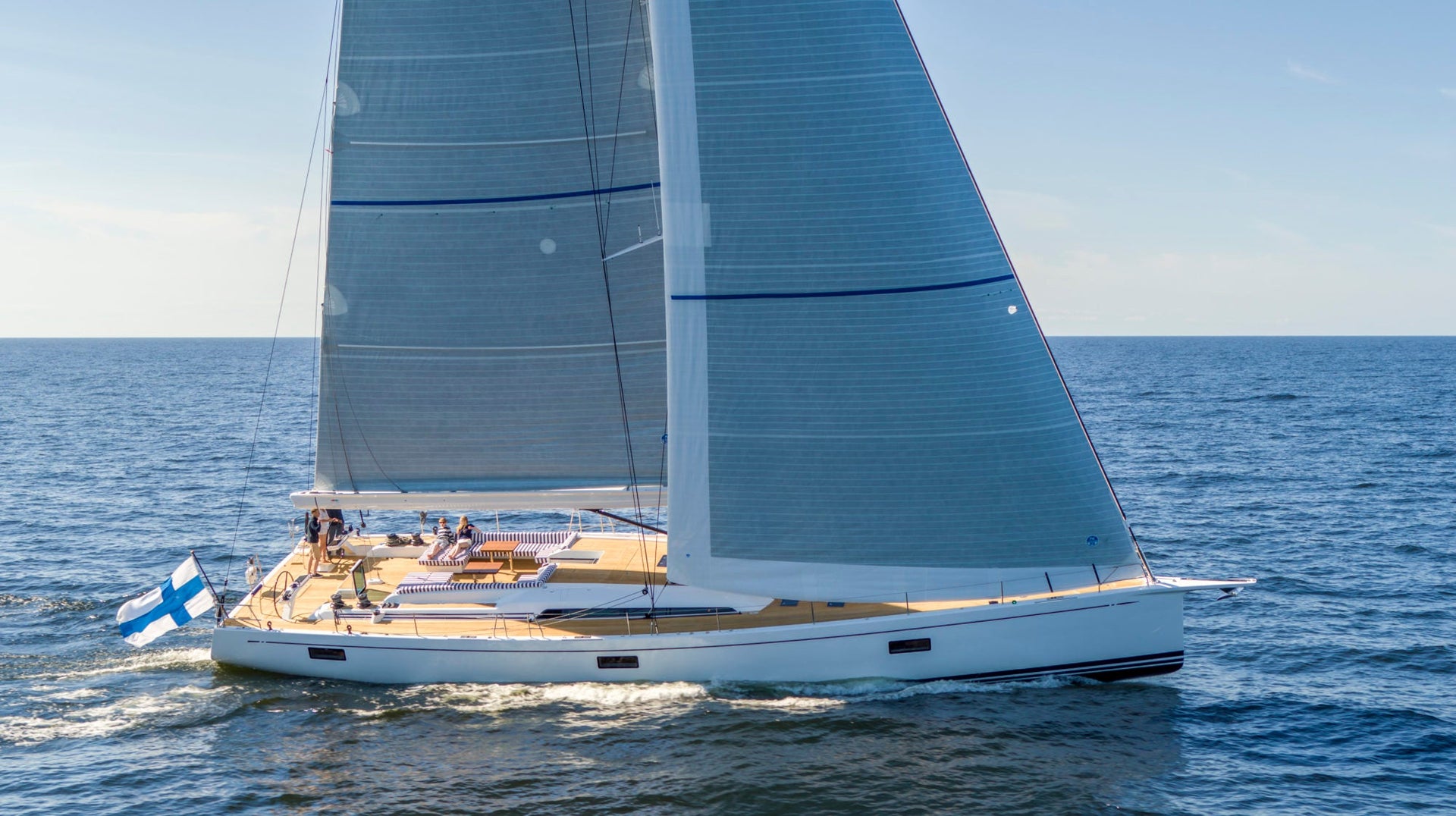
NEW SAILS FOR SUMMER ON SWAN 78 KININA
NEW SAILS FOR SUMMER: SWAN 78
Collaboration with North Sail Designers and Experts To Create The Perfect Inventory for Kinina
📸 Eva-Stina Kjellman / Nautor Swan
In 2018, Mr. Enrico Bonatti purchased Kinina, a Swan 78. Why a Swan 78? “I prefer the best quality,” he said. “And the 78 is the right size for me.” Mr. Bonatti then met with sail expert Matteo Reboli, based at North Sails in Carasco, Italy when he decided it was time for his new upwind inventory. From there, Matteo and Sail Designer Michele Melandra put together the best upwind sail combination for their client, with a new suite of custom 3Di ENDURANCE.
Mr. Bonatti was immediately impressed by the structural integrity of his 3Di ENDURANCE sails, especially in heavier air conditions. “My sails provided us more speed and greater versatility,” he commented. “3Di ENDURANCE is meant to be easier to control, as it is more rigid, and offers a reduced heeling moment while navigating, making it more comfortable for the skipper and guests onboard,” said Matteo.
📸 Eva-Stina Kjellman / Nautor Swan
This year, he wanted to add another option to his inventory for his cruising time around the Mediterranean, so he bought a Code Zero, made of cuben fiber which was built at North Sails in Milford, CT, USA. The order was placed mid-March and arrived in May to prepare for sail testing in Jakobstad, Finland. “Mr. Bonatti was exceptionally pleased with his new code sail during the sail testing last month,” said Matteo. “We had 15-18 knots of breeze for the testing. It went well.” Mr. Bonatti commented; “My new code sail has a ton of power, especially in lighter air. And it’s easy to deploy.” Reviewing the finished result, Mr. Bonatti was impressed with his overall experience working with North Sails. He commented; “My experience was the utmost professional. My sails were ordered, delivered on time– even during the restraints of COVID. North Sails made the effort to make sure I had what I needed.”
“Mr. Bonatti is the ultimate cruiser,” says Matteo. “He enjoys the leisure aspect. “Let me say, his new code sail coupled with his upwind suit is a perfect match. The flying shape, weight ratio, and sail handling– not to mention the lifespan; it was the right solution.”
📸 Eva-Stina Kjellman / Nautor Swan
“Planning the delivery of the Code Zero was the last step of the deal, but the most important step to take with the client to assure they are happy with their investment,” says Matteo. “Installing the sail is the part where you finalize everything,” he says. “The time spent sail designing, checking each finishing detail for quality, making sure all the fittings, mainsail cars, cables, and furlers are all correct, and working smoothly. It’s the beginning of the final step, but is our last chance to assure that things are 100% perfect.”
What did Mr. Bonatti think when he experienced his first sail with his new Code Zero? “It felt right. The boat showed great performance. It was picture perfect.”
Matteo credits Michele Melandra for his key involvement in the perfection of the final result. “Michele did an exceptional job with this sail design, from start to finish, working with Southern Spars rigging to create the best solution for our client. There is a reason that this project was successful. When it came time to fit the sails and test them out, we saw that everything was the perfect fit.”
“Working closely with the boatyard, boat captain, North Sails designers, and our clients,” Matteo added, “we’ve been given such great opportunities to work at the highest levels in the cruising sail market.”
Kinina is equipped with a staysail, which can also be hoisted using the anti-torsion cable on the furler or using soft hanks. This comes in handy when the weather turns rough, as the storm jib comes into play and can also be used with either method. The trysail runs on a track making it easy to drop on deck, just to add to efficiency.
Kinina is also equipped with the Ubi Maior Jiber System, which combines performance with ease of furling. By allowing the option for different sails to be hoisted using hanks or the anti-torsion cable, not to mention a faster hoist than a traditional furler would provide and a low profile drum, the overall upwind performance is automatically improved.
Matteo suggested a top-down furler because Mr. Bonatti planned to leave his sail up for easy use, and enjoys how simple it can be unfurled for sailing higher angles while cruising. Having efficient sail systems onboard is key on a yacht like the Swan 78. “Every aspect of this sail plan and boat design was made for luxury cruising. Nautor Swan builds beautiful boats, and North sail designers and experts have come together to create a great combination,” said Matteo.
New Ubi Meior Jiber System installed for top down furling code zero. Image left pre-installation 📸 Eva-Stina Kjellman / Nautor Swan
“This entire project was a reflection on our positive relationship with the shipyard where Kinina was being stored and was beneficial for us moving forward with additional projects with other Swan 78 clients.” Matteo expresses his thanks to the boatyard for working with North Sails to help make the client experience the best it could be. “Teamwork was important; between the boatyard, the captain, Southern Spars, and our North Sails experts and designers. Our client is happy, and that is our number one goal.”
📸 Eva-Stina Kjellman / Nautor Swan
READ MORE
READ MORE
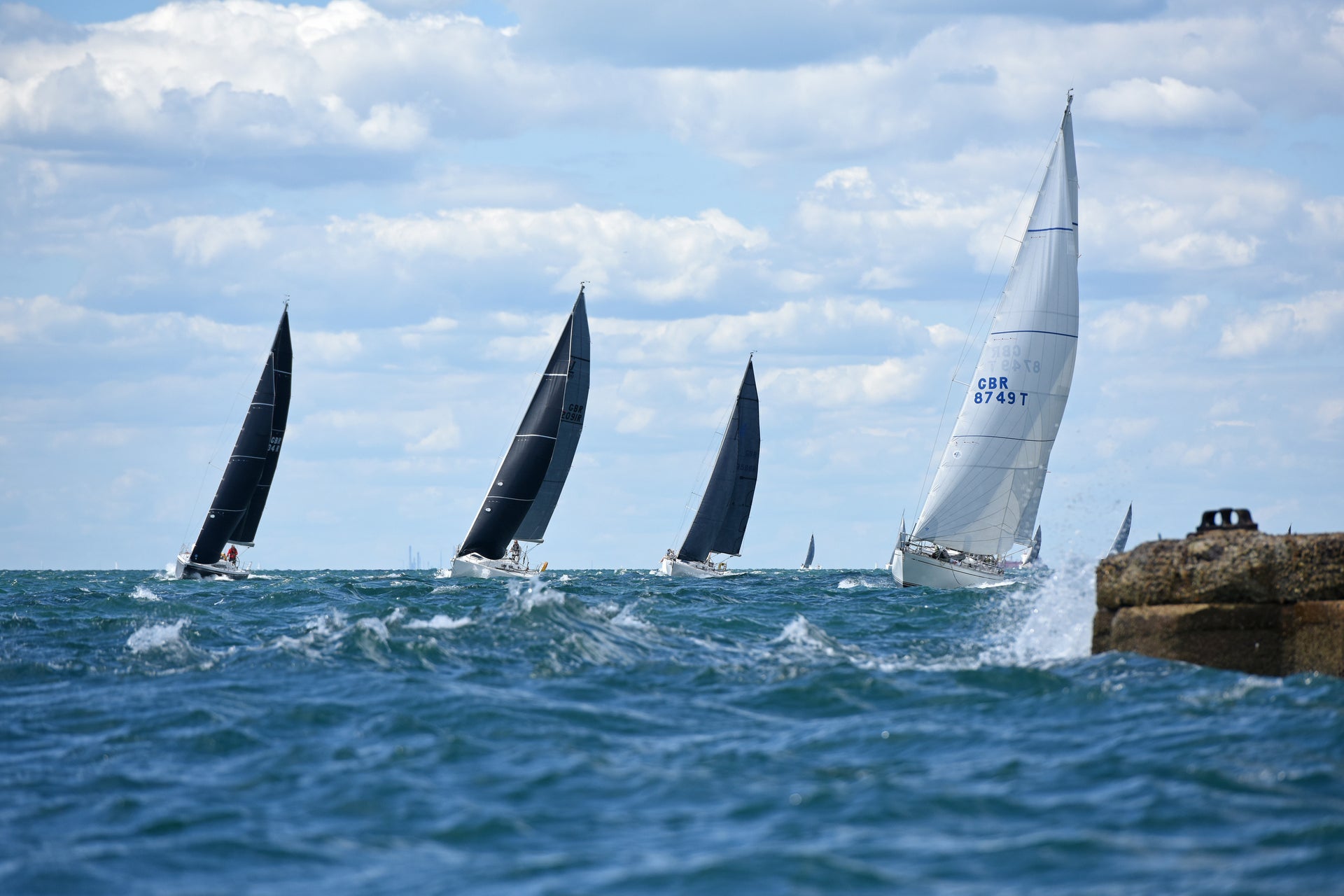
LOCAL SPOTLIGHT: CLUB RACING RESULTS WITH 3Di RAW
LOCAL SPOTLIGHT: CLUB RACING RESULTS WITH 3Di RAW
J/88 Tigris Takes the Lead in Class 1
The fleet racing towards the Nab Tower 📸 Rick Tomlinson
136 boats made up three classes who raced on the Solent last weekend for the Junior Offshore Group (JOG) Lonely Tower Race, marking the most entries for a local regatta so far this year. The 35 nm course had the fleet racing to and from Cowes, sailing around the Nab Tower which lies just offshore to the east of the Isle of Wight. Built for anti-submarine protection in World War I, the tower marks the deep-water entry into the Solent for sailors. As well as providing an amazing spectacle for all those on the water, the day also proved to be a great success for North clients. We talked to 26-year-old Sam Cooper who, alongside main trimmer Mike Haliburton, took the top spot with Gavin Howe’s J/88 Tigris in Class 1 after a total elapsed time of 5 hours, 45 minutes and 24 seconds.
The Race Course
The conditions at the start were not easy as converging air made conditions light and changeable. “The start was hard as we were one of the smallest boats on the line, with the shortest mast,’’ Sam says. “We knew the wind was going to be fickle, so we just set our course and tried our best to make the sails work around that. We could see some spinnakers flying close to the mainland shore which matched our 1km weather model, so we headed there, sacrificing the good tide. It paid off as we reached a light 5-8 knots of wind and had a good battle with Mark Spearman’s JPK 1180 Dawn Treader.’’
Dawn Treader flying their North Sails Code Zero 📸 Rick Tomlinson
The breeze eventually reached a steady 13-18 knots, and the pair rounded the Nab Tower just astern of Chris Jones’ J/111 Journeymaker, who they battled with throughout the race. After rounding Winner Buoy, Sam and Mike made the tactical decision to sail towards Portsmouth to escape the lighter air close to the Isle of Wight. “We sailed within 20m of the beach at Stokes Bay. The tide gave us good gains there, but the challenge with this leg was changing gears whilst maintaining good speed.’’ The pair followed the breeze and shifts on the upwind beat home before tacking onto starboard outside Cowes and finishing on the JOG line. Having sailed the race two times before, this result was their best. “We had said during the race that it didn’t matter much where we finished as long as we were happy with our performance in the boat. We were happy and it just so happens that we got a good result too!’’
The Sails
With a full North Sails inventory, the team raced with a 2016 3Di RAW 680 Mainsail, 2014 3Di RAW 670 J2, and a 2014 A2. “The 3Di RAW Mainsail is remarkable; we’ve pushed it since our very first outing in 2016’s Round the Island Race. It remains fast and the shape has held up extremely well. We’ve never had a sail repair either.” Team Tigris works closely with Ronan Grealish and Sam Richmond at North Sails UK. “We find them both to be full of knowledge and always there to help with our questions,”, Sam says.
“The 3Di RAW Mainsail is remarkable; we’ve pushed it since our very first outing in 2016’s Round the Island Race. It remains fast and the shape has held up extremely well. but it remains fast and the shape has held up extremely well. It has also never been repaired.’’
Winners of JOG Lonely Tower Race Class 1, Sam Cooper and Mike Haliburton with J/88 Tigris 📸 Rick Tomlinson
Shorthanded Sailing
The J/88 is different from today’s trend of doublehanded boats. It is fairly light, has moderate ballast and low form stability, with less power than the Sunfast 3300, JPK 1010, or even the J/99. “You have to sail the J/88 differently, with a focus on efficient maneuvers and sail selection,’’ Sam says. “Doublehanded sailing is great as you are freer to sail the boat exactly how you want. It also gives you a good feel for every role onboard, which I think ultimately improves each crew member onboard. For this race, I helmed, trimmed the mainsail, and had the spinnaker sheet in the hoists. Mike focused on the spinnaker drops, as well as headsail and spinnaker trim.’’
Singlehanded or Doublehanded?
Sam got involved with shorthanded sailing as his parents owned a J/92/S which they won the doublehanded class in the JOG Cowes-Dartmouth Race with. He is also known to sail solo, so we were interested to know which he preferred: “Both singlehanded and doublehanded sailing has its merits and I change my mind all the time! The J/88 is exhausting to sail solo as it is harder to keep it sailing fast compared to a wider, more stable boat. Right now I’m enjoying doublehanded sailing but ask me in a month and it could change…’’
Looking Ahead
Up next for Sam and the J/88 Tigris is this weekend for the JOG Great Escape Race where he will be racing with bowman/mastman Tim Villain. Good luck!
North Sails expert Neil Mackley at the start line on the North RIB
North Sails designer Kevin George sailing with Chris Frost onboard the Swan 36, Finola 📸 Rick Tomlinson
📸 Rick Tomlinson
North Sails expert Pete Redmond sailing with Dave Bart on the Cape 31, Tokoloshe 📸 Rick Tomlinson
Sign Up for North Sails News
READ MORE
READ MORE
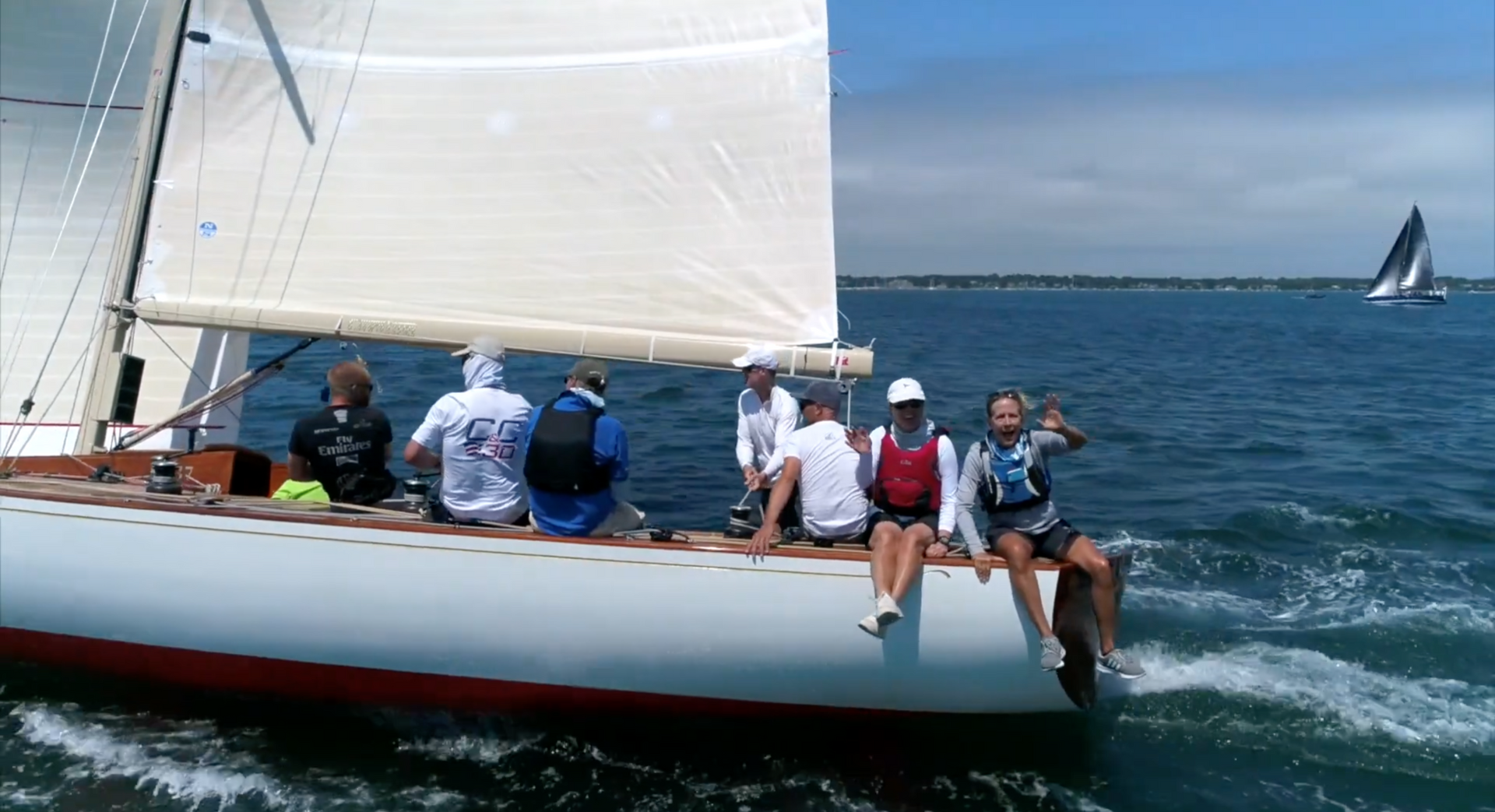
FEELS LIKE SUMMER IN RHODE ISLAND
FINALLY FEELS LIKE THE SUMMER SAILING SEASON IN RHODE ISLAND
Local Sailing Finds Perfect Conditions on Narragansett Bay
It took until mid-July but it finally feels like summer on Narragansett Bay. This past weekend 24 boats of various shapes and sizes participated in IYAC’s 2020 Newport Cup to race around Conanicut Island. Local talent, short-handed sailing, and solo kiteboarding sessions were all on display in an effort to do whatever it takes to get back out on the water.
Skipper of Class40, First Light, Sam Fitzgerald said, “it was great to get back out on the bay today and race against some new faces. Today’s conditions were challenging, especially in the beginning of the race but we had an awesome day nonetheless! We are just glad to be out here!”
The around Conanicut Island clockwise course started in a fresh southerly gradient which slowly shifted to a southwest sea breeze. The 18 mile “around the island” is a classic racecourse with upwind, downwind and reaching legs. Jason Carroll’s Mod 70 Argo was first to finish in just under 90 minutes.
“Never a bad day when you get to line up with a Mod 70 on the kite foil,” said local kiteboarder Casey Brown. ” I let Argo get a clear start, then started reeling them in as we ripped through the fleet before the wind faded approaching beavertail. Shoulda gone with a bigger kite! It was a great day on the water! Lots of stoke.”
“It doesn’t get much better than this,” remarked North Sails expert Mike Toppa. “It’s easy to take local sailing for granted but, we are lucky enough to be out sailing on one of the nicest pieces of water in the world. Schooners, kiteboarders, multihulls, classics, double handers, 12 Metres, PHRF champs, and everything in between were competing. This is different from what we all had planned for our 2020 season, but summer is short and you don’t want to miss out.”
Meanwhile, on the bay, Newport Yacht Club held their Offshore 160 Single-Handed Challenge. 15 short-handed boats set off on a 114 mile, overnight, offshore course to a buoy off Montauk Point and back. The biennial Offshore 160, held in the off-year from the Bermuda ONE-TWO, is a 160-mile qualifier for the ONE-TWO. This low-keyed, bare-bones event provides a chance for new skippers’ singlehanded to hit their qualifying passage in the off-year, and to provides past competitors with a long-distance racing “fix,” something we all need this summer
There is still plenty of racing in and around Rhode Island this summer for anyone interested in getting on a racecourse this summer. Check out the schedule below or get in touch with the North Sails loft in Portsmouth for questions or expert advice.
Contact Loft Find Your Expert
Events Coming Up Around the Bay:
M32 Midtown Cup – Jul 18-19
GSBYRA Southbay Regatta – Jul 18-19
Sail Newport Part I – July 25-26
MOHOSA Wednesday Night Worlds – July 29th
Around Martha’s Vineyard – July 30-31
Edgartown Yacht Club ‘Round the Island Race – Aug 1
Sail Newport Part II – Aug 1-2
MOHOSA Part II – Aug 2
Ida Lewis Distance Race – Aug 15-16
J/Fest – Aug 15-16
Herreshoff Museum Leukemia Cup –August 22
166th Annual Regatta & NYYC One-Design Regatta – August 28-30
Sail Newport Part III – Aug 29-30
CYC ATI Race – Sept 6
Queen’s Cup – Sept 2
Sail for Hope – Sept 12
Race Week at Newport presented by Rolex – Sept 23-26
Melges IC37 National Championship – Oct 2-4
Laser Masters – Oct 10-11
READ MORE
READ MORE


